It seems we can’t find what you’re looking for. Perhaps searching can help.
Sign Up for newsletter!
Subscribe to get the latest eBook!
Hotline







Jewelry eCommerce is a significant playground for many players. Exquisite jewelry pieces made from gemstones, gold, and silver are brought closer to consumers through eCommerce websites.
Brands worldwide, including those in Vietnam, not only strive to introduce a series of creatively innovative collections but also emphasize providing a better online shopping experience for customers.
Learn more: What opportunities are open to the jewelry eCommerce?
Let’s explore the allure of the jewelry world through the list of the 10 most notable jewelry eCommerce websites in Vietnam and around the world.
With a history spanning over a century, Cartier has firmly established itself as a symbol of luxury and sophistication in the jewelry market.
Renowned for its exquisite and unique jewelry creations made from the finest gemstones and precious metals, including gold and silver, Cartier goes beyond merely producing and selling products.
The brand also offers services such as care, repairs, and gift packaging.

Cartier’s eCommerce website is meticulously crafted on the Salesforce Commerce Cloud, a leading open-source platform for eCommerce development. This choice ensures that the online shopping experience on Cartier’s platform is optimized to reflect the brand’s spirit and values.
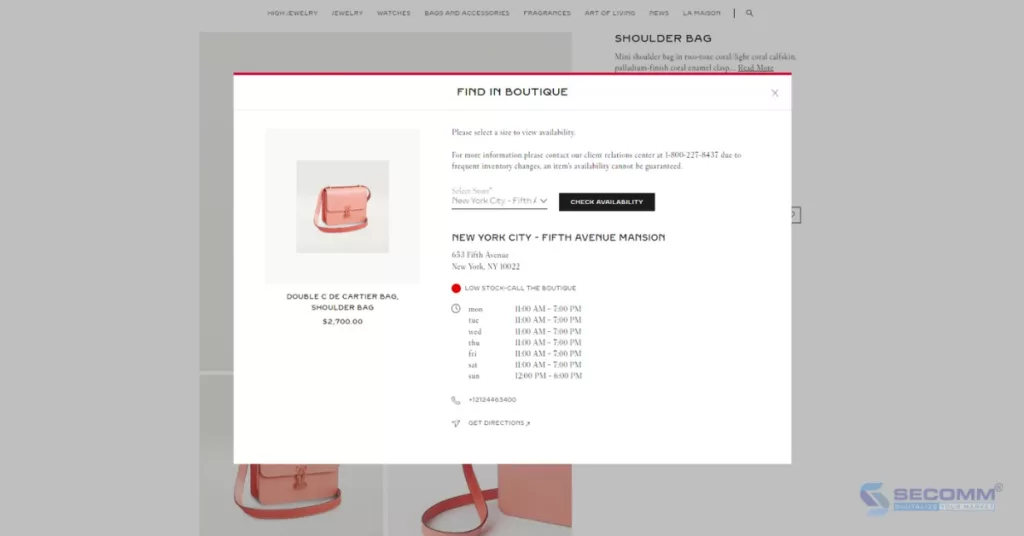
The website design embraces a minimalist approach and incorporates various features such as AR, allowing customers to examine products from different angles visually. Additionally, it features an intelligent search system that provides accurate results even if customers make typing errors and allows for checking product availability at any store.
Tiffany & Co. stands as a premier and globally renowned jewelry brand. Its product range includes exquisite jewelry items such as rings, necklaces, earrings, and watches, crafted from precious metals like silver, gold, and platinum, along with precious gemstones such as diamonds, pearls, and green beryl.
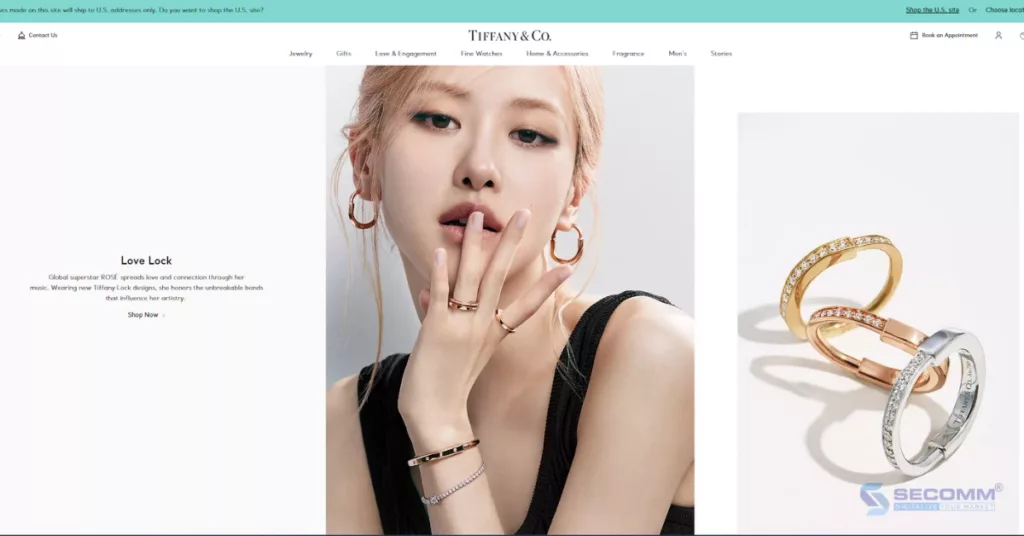
Tiffany & Co.’s eCommerce website is built on the Adobe Commerce platform. offers flexibility and scalability to meet custom needs and long-term development goals. Similar to Cartier, Tiffany also provides customers with various services, including product selection advice and product care.
Notably, Tiffany’s website includes an outstanding store locator feature based on the radius, enabling customers to easily identify the nearest stores based on city, zip code, and offered services, facilitating a seamless shopping experience.
With over 30 years of reputation in the crafting and selling of high-end jewelry, PNJ is one of the most renowned jewelry and diamond brands in Vietnam.
PNJ offers customers a diverse and extensive selection of jewelry, catering to every need and aesthetic preference, from wedding jewelry, feng shui jewelry, diamond jewelry, colored stone jewelry, and Italian gold jewelry, to Disney and STYLE by PNJ jewelry.

PNJ’s eCommerce website is built using the PHP programming language, a popular and effective language for developing web applications. The website features a user-friendly interface, allowing customers to quickly and conveniently view, search, compare, and purchase jewelry products.
The website also includes several notable features, such as integrated diverse payment methods, product size selection, store search by province/city and district, and options for home delivery or in-store pickup.
Originating from New York, USA, ANA LUISA is a prominent jewelry brand with a vision of enhancing life through unique and luxurious jewelry pieces. ANA LUISA selects premium materials such as 14k gold, 925 sterling silver, lab-grown diamonds, and cultured pearls to create diverse collections suitable for every style and personality.
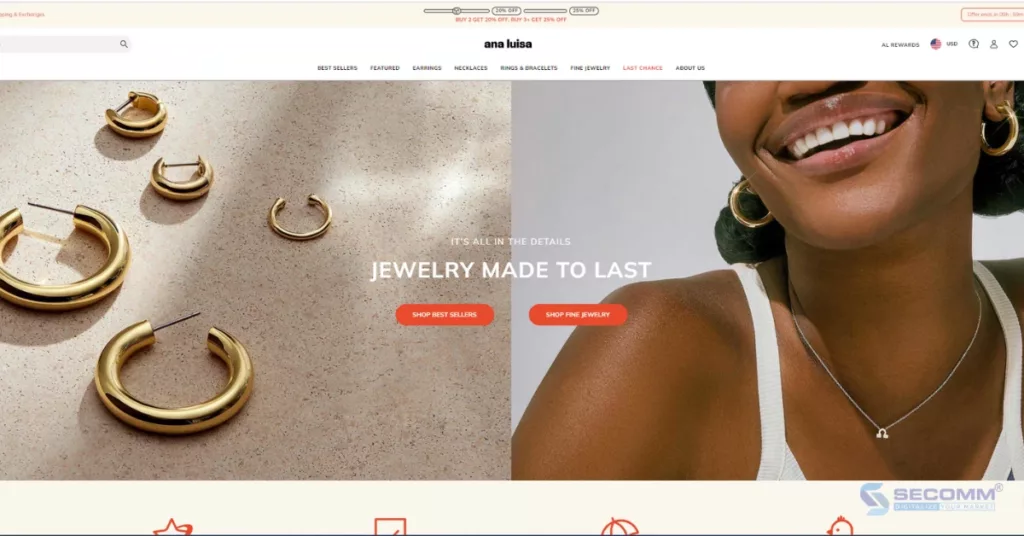
The eCommerce website of ANA LUISA is built and developed on the Shopify SaaS platform. The website features a simple and elegant design with a white color scheme, fitting seamlessly into the accessory and jewelry industry. ANA LUISA focuses on enhancing features to provide the best online shopping experience for customers.
Features include order tracking by order number and zip code, quick product view, pre-ordering with notifications upon availability, product recommendations based on viewing history, and displaying the number of products sold within the last 24 hours.
Missoma is a jewelry brand hailing from London, UK, specializing in gold and silver recycled jewelry with modern, refined, and distinctive designs. The brand features several standout jewelry collections, including Lucy Williams, Harris Reed, Savi, Zenyu, Molten, and many more.

The eCommerce website design of Missoma reflects the inherent sophistication and minimalism of the jewelry industry. The website is built and developed using Shopify, facilitating easy integration with a variety of third-party applications to enhance the customer shopping experience with richness and quality.
Some notable features of Missoma include the integration of diverse payment methods, including Buy Now Pay Later with Klarna; an automatic multi-currency conversion feature based on the user’s IP; product filtering based on material and size; and the incorporation of the loyalty program “The Rewards Stack” for loyal customers.
Founded by Michael Saiger in 2008, Miansai is a leading American jewelry brand. Miansai specializes in creating simple, elegant, and unique designs for both men’s and women’s jewelry, using carefully selected and handcrafted raw materials. The brand offers various jewelry collections, including necklaces, bracelets, rings, earrings, keychains, and many other accessories.

Miansai also utilizes the Shopify platform to build its eCommerce website, incorporating industry-specific features such as product size selection, product and collection filtering and searching, automatic currency conversion based on the user’s IP, search suggestions, and integration with social media platforms like Facebook, Pinterest, and Instagram.
Catbird is a high-end jewelry brand established in 2004 in New York City, USA. The brand is known for its sophisticated and artistic designs. Catbird’s products are crafted from various materials, including gold, silver, gemstones, and more.

The eCommerce platform of the Catbird jewelry website is Magento Open Source, offering exceptional flexibility that allows the brand to build a range of enhanced features for a smooth and enriching shopping experience for customers.
Some notable features on the Catbird eCommerce website include product search and filtering, product size selection, personalized jewelry customization options, and automatic currency conversion based on the user’s IP.
Notably, the Catbird website includes a “Web Accessibility” feature, allowing customization of website accessibility, including adjusting viewing modes for users, modifying content size and alignment, and changing interface colors.
Huy Thanh Jewelry is one of the renowned jewelry brands in Vietnam. With a mission to bring beauty and value through each piece of jewelry, the brand has made a mark in the hearts of consumers with its exquisite and unique products, handcrafted from precious gemstones and metals such as gold and silver.

The Huy Thanh Jewelry eCommerce website is built on the Haravan Enterprise platform, one of the popular eCommerce platforms in Vietnam. Some notable features of the Huy Thanh Jewelry website include product filtering and search, customization of size, material, and color, as well as integration with various social platforms and payment methods.
EROPI is another prominent jewelry brand in Vietnam specializing in distributing various types of gold, silver, jewelry, gemstones, pearls, wedding jewelry, and feng shui jewelry. After many years of operation, the company has expanded its chain of stores nationwide and developed an online sales channel to meet the shopping needs of customers.
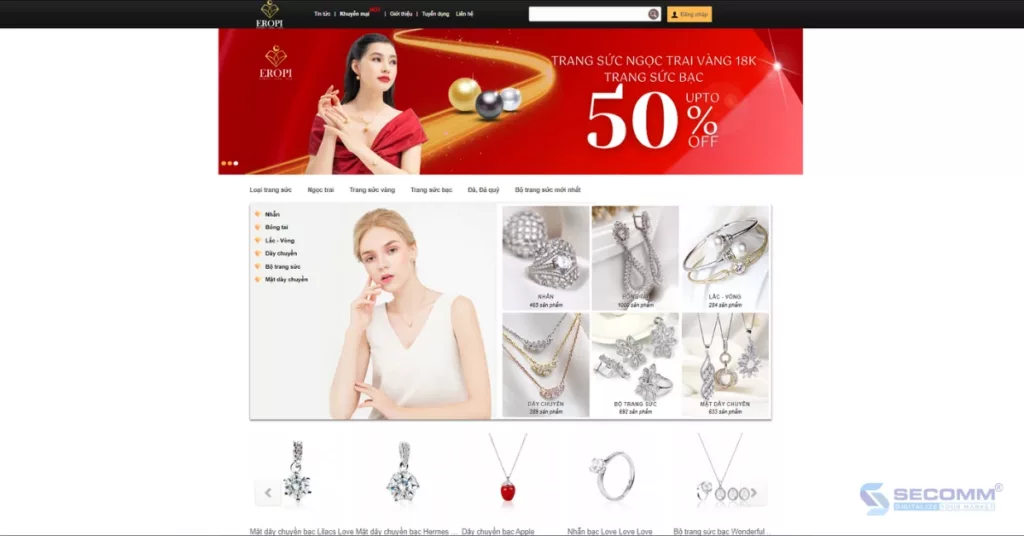
EROPI’s primary online channel is its eCommerce website, which has been invested in and built on the Magento Open Source platform. With excellent customization capabilities, this platform allows EROPI to create advanced features and flexible expansion capabilities, ensuring the long-term development goals of the business.
STONE AND STRAND is a jewelry brand established in 2013 in the United States. STONE AND STRAND offers a range of jewelry products, including rings, necklaces, earrings, and various other jewelry designs. All products are designed with exquisite craftsmanship and perfect details, reflecting the brand’s creative vision.
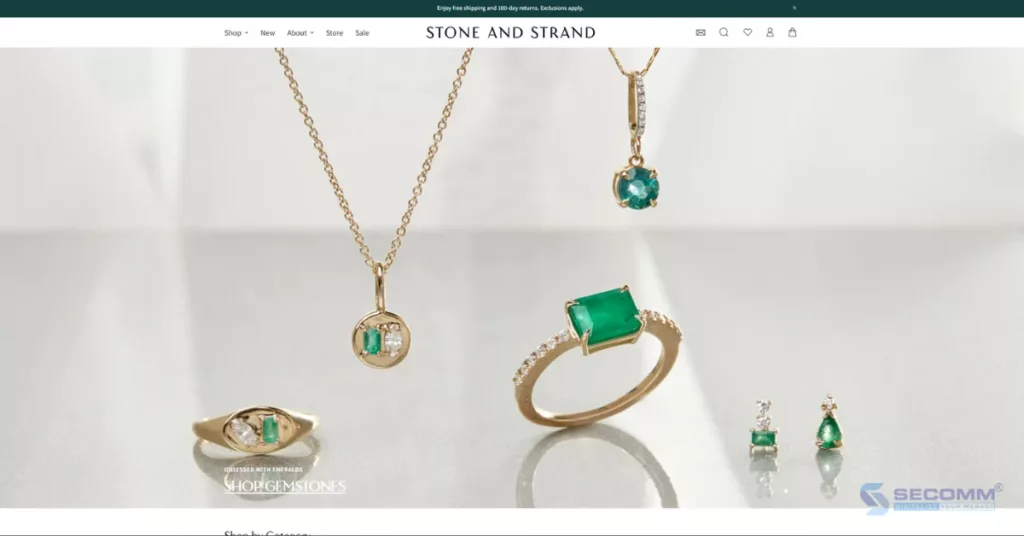
The STONE AND STRAND website is built on the Shopify eCommerce platform, one of the preferred platforms for many jewelry brands worldwide. In addition to an easily filterable and searchable product portfolio, the website also features order tracking via email and integrates multiple payment methods, including Buy Now Pay Later with Affirm.
Above are 10 amazing jewelry eCommerce websites in Vietnam and worldwide. This is evident that modern jewelry brands are not only focusing on developing their business through traditional retail channels but have rapidly embraced and expanded in the online space.
A well-designed and appealing eCommerce website not only helps these brands connect with a large pool of potential customers but also reflects their professionalism and vision.
With an in-depth understanding of eCommerce and a wealth of experience in successfully developing jewelry website projects, SECOMM will help you enhance your online presence quickly and effectively.
Contact us or call the hotline at 02871089908 to start deploying your first jewelry eCommerce website today!
 2
2
 8,888
8,888
 0
0
 1
1
In the ever-growing digital age, online drugstores have become an ideal destination for global users seeking convenient and safe ways to care for their health and purchase medications online. The robust growth of eCommerce and changes in user behavior have driven the expansion of this pharmaceutical eCommerce industry.
Below are some crucial insights into why pharmaceutical eCommerce has become an essential component of the modern healthcare system.
Pharmaceutical eCommerce has become a promising business model in recent years. According to the “Healthcare eCommerce Global Market Report” compiled by The Business Research Company, pharmaceutical eCommerce is categorized into three main models:
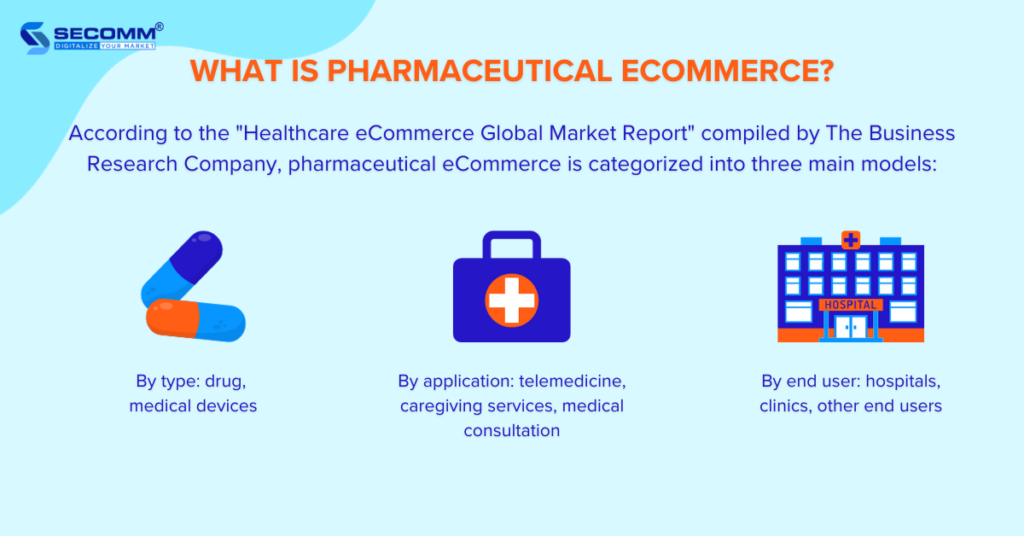
This is a model that enables consumers to order and purchase various products such as prescription drugs, over-the-counter medications, vitamins, dietary supplements, healthcare, personal care, etc., through online shopping channels.
Some well-known pharmaceutical eCommerce by type examples include Droga Raia (Brazil), Netmeds (India), Pharmacity (Vietnam), etc.
Consumers can access healthcare consultation, advice, and diagnostic services through various applications for this type of pharmaceutical eCommerce. Under this model, consumers typically subscribe to and pay for these services through packages or on a subscription basis (monthly or yearly).
Companies adopting this service-oriented eCommerce model include Teladoc (USA), iCliniq (India), SBB Healthcare (Vietnam), and others.
This pharmaceutical eCommerce model often involves websites or applications created by hospitals/clinics to assist patients in scheduling appointments, offering healthcare packages, prescription medications, and more.
Examples of hospitals/clinics following the eCommerce model by end-users include The Royal Melbourne Hospital (Australia), NYC Health+ Hospital (USA), Vinmec (Vietnam), and others.
Certainly, Covid has not only led to a rise in traditional healthcare expenditures but has also acted as a driving force for pharmaceutical eCommerce. In the United States, telehealth visits witnessed a remarkable surge of 2,600% in March 2020 (during the peak of the COVID-19 outbreak in the U.S.) compared to the same month in 2019.
The growth of the pharmaceutical eCommerce market seems unabated. According to a recent report by CMS, total healthcare spending in the United States reached $3.8 trillion, marking a 4.6% increase in 2022. The Asia-Pacific region is anticipated to experience rapid growth in healthcare eCommerce, with a projected CAGR of 20.5% from 2020 to 2027.
Nielsen predicts that the pharmaceutical eCommerce market in Vietnam will attain a value of $10 billion by 2025.
Some other reasons for the rise of pharmaceutical eCommerce include:
Apollo Pharmacy is a well-known retail pharmacy chain in India, affiliated with the Apollo Hospitals. After years of operation in the healthcare sector, Apollo decided to establish an eCommerce website to serve millions of customers nationwide. The Apollo eCommerce website is built on the Magento platform, ensuring the capability to manage an extensive product catalog.
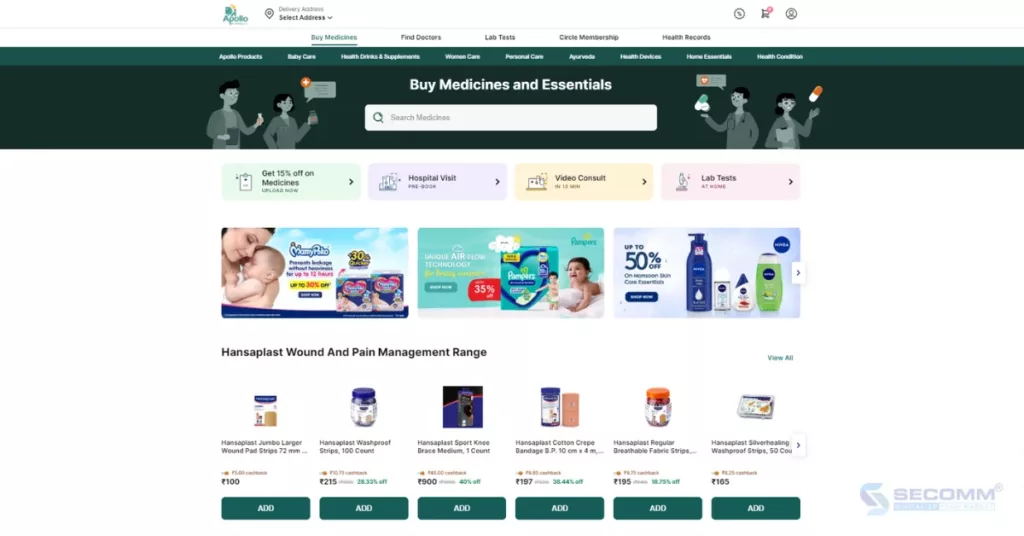
Beyond selling prescription and non-prescription drugs, as well as health care products, Apollo also provides various related services. Among these, notable offerings include online consultation services, health check-up appointments, vaccination appointments, and insurance sales.
Teladoc Health, Inc. is an American healthcare technology company headquartered in Purchase, New York. The company provides remote healthcare services, including video consultations, phone consultations, and remote health monitoring.
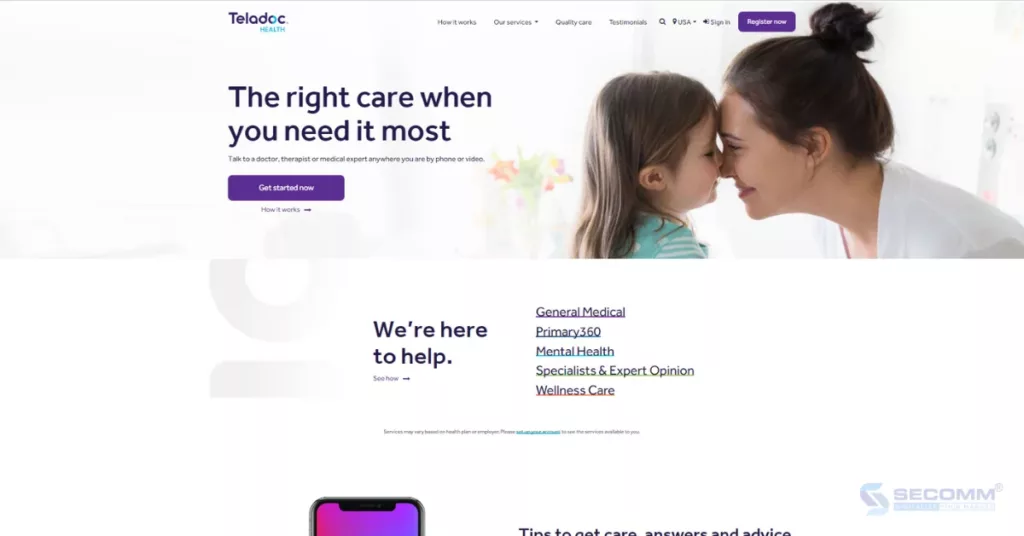
By rapidly deploying a website and eCommerce application, along with the utilization of cutting-edge technologies such as artificial intelligence (AI), machine learning (ML), and data analytics, Teladoc has been able to enhance customer experience and deliver improved remote healthcare services.
Mayo Clinic was founded in 1889 by Dr. William W. Mayo and his two sons, Dr. Charles and Dr. William J. Mayo. Initially, Mayo Clinic was a small clinic specializing in providing healthcare services to the local community. However, the hospital quickly expanded and became one of the leading hospitals in the world.
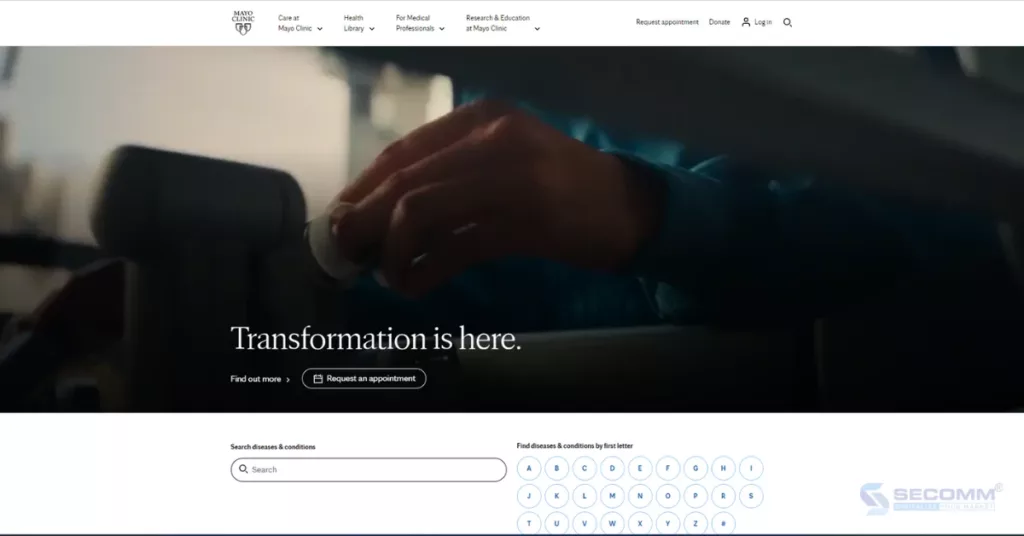
Much of Mayo Clinic’s success can be attributed to the early adoption of eCommerce, allowing patients to schedule appointments, check test results, and purchase medications online. This has helped patients save time and effort, contributing to Mayo Clinic’s overall success.
Learn more: The 10 Best Remarkable Pharmacy eCommerce Websites
The Bottom Line
Pharmaceutical eCommerce not only brings convenience and diverse choices for consumers but also presents attractive business opportunities for healthcare enterprises. If invested systematically and guided correctly, businesses in this field can seize significant opportunities in this promising market.
With extensive experience in implementing eCommerce for customers in various countries, SECOMM understands the difficulties and challenges that businesses face during the deployment process.
Contact SECOMM now or call directly at the hotline number (02871089908) today for a free consultation
 2
2
 13,765
13,765
 0
0
 1
1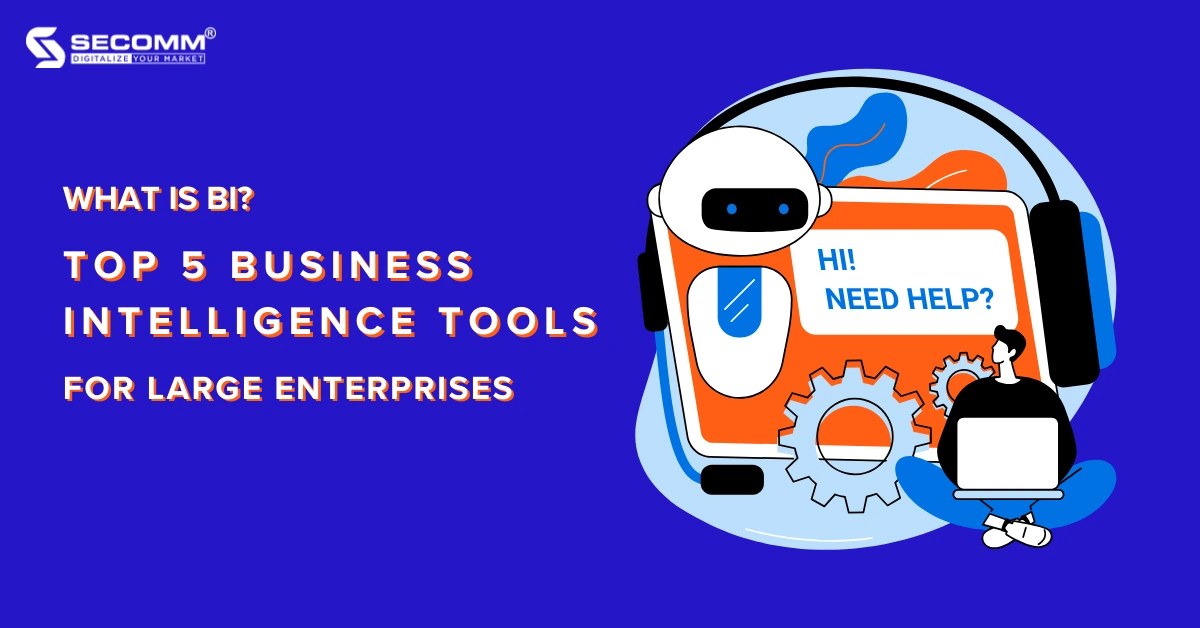
Trong thời đại thương mại điện tử đang ngày càng lên ngôi như hiện nay, việc thu thập, phân tích và ứng dụng thông tin kinh doanh là một yếu tố quan trọng để nắm bắt được các cơ hội mới trong thị trường.
In the current era dominated by eCommerce, gathering, analyzing, and applying business information is crucial to seize new opportunities in the market. Business intelligence (BI) can be an invaluable tool for managing corporate data for enterprises.
So, what is Business Intelligence, and what makes it the perfect choice for large businesses?
Business Intelligence (BI), often referred to as intelligent business or corporate intelligence, is an information technology management system involved in collecting, organizing, analyzing, and transforming business data into valuable information to support decision-making and guide business strategy for enterprises.
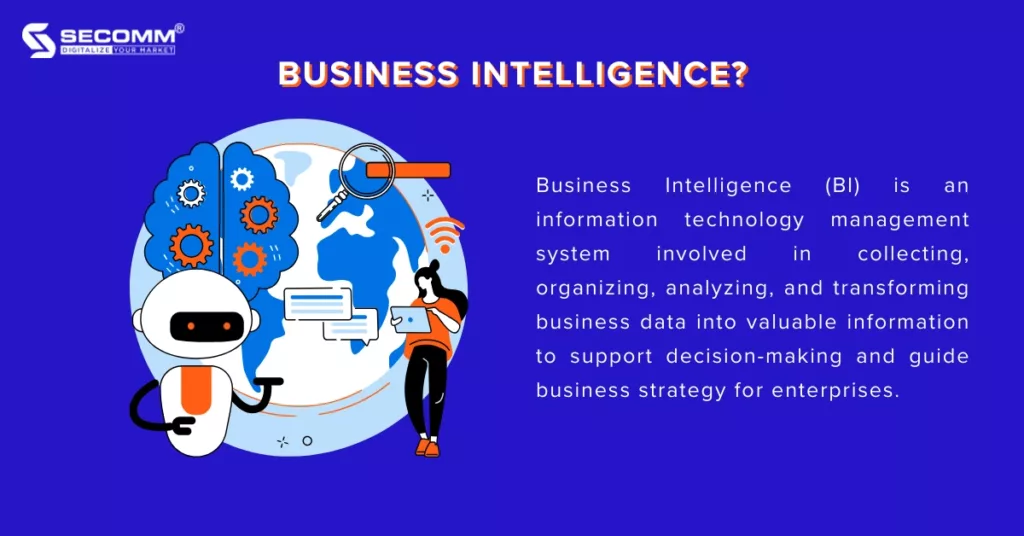
BI systems help businesses track and measure key business performance indicators such as revenue, profit, profitability, customer satisfaction, consumer behaviour, favourite products, etc. Through the analysis and comparison of this collected data, BI systems enable the visualization of trends and the most suitable business models, thereby assisting corporate managers in developing appropriate business strategies.
A BI system is a collection of technologies, tools, and methods used to deploy the BI process in a business. This BI system typically includes components such as:
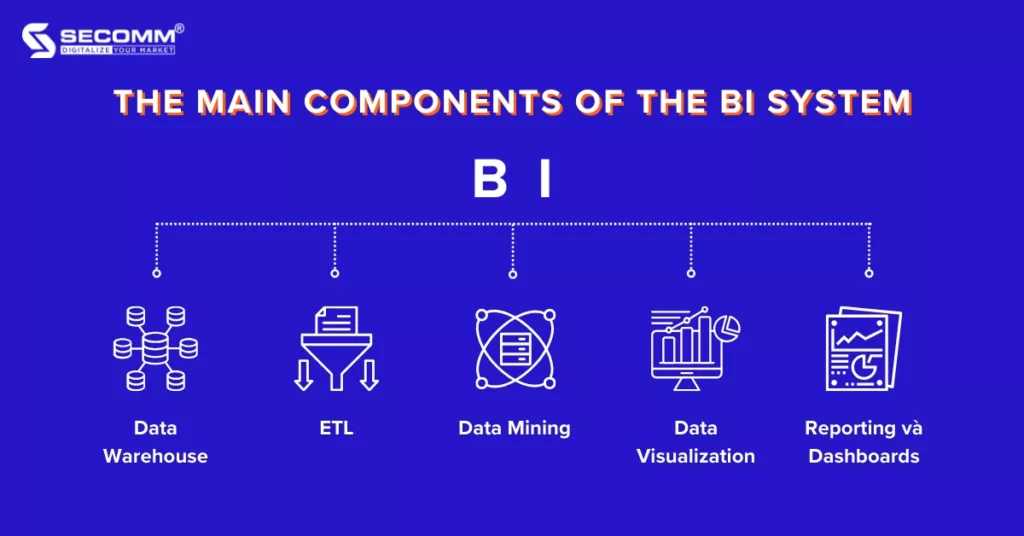
Tableau is an interactive data visualization software focused on business intelligence. Established in 2003 in Mountain View, California, and now headquartered in Seattle, Washington, Tableau was acquired by Salesforce in 2019 for $15.7 billion.
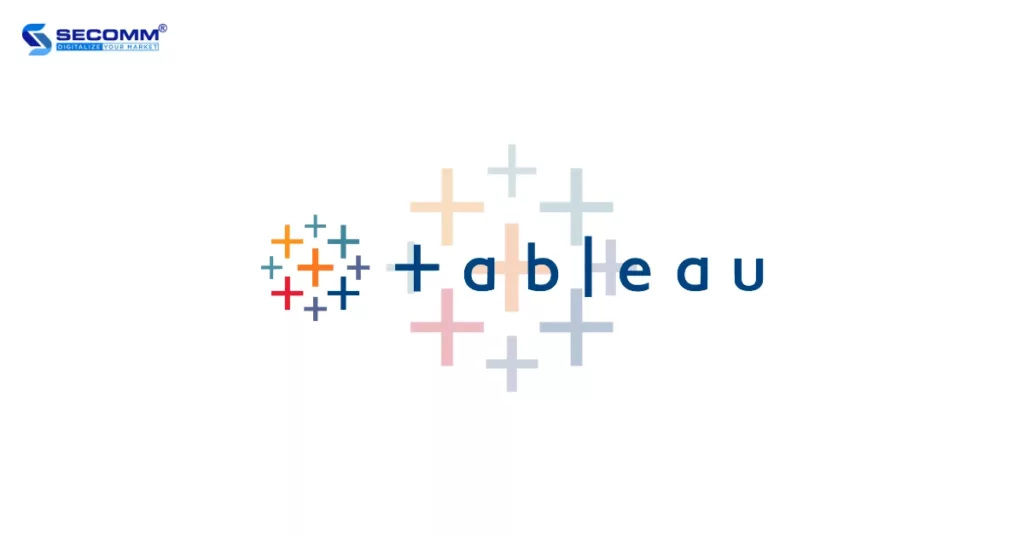
Advantages:
Disadvantages:
Microsoft Power BI is an interactive data visualization software developed by Microsoft in 2011, with a primary focus on business intelligence.
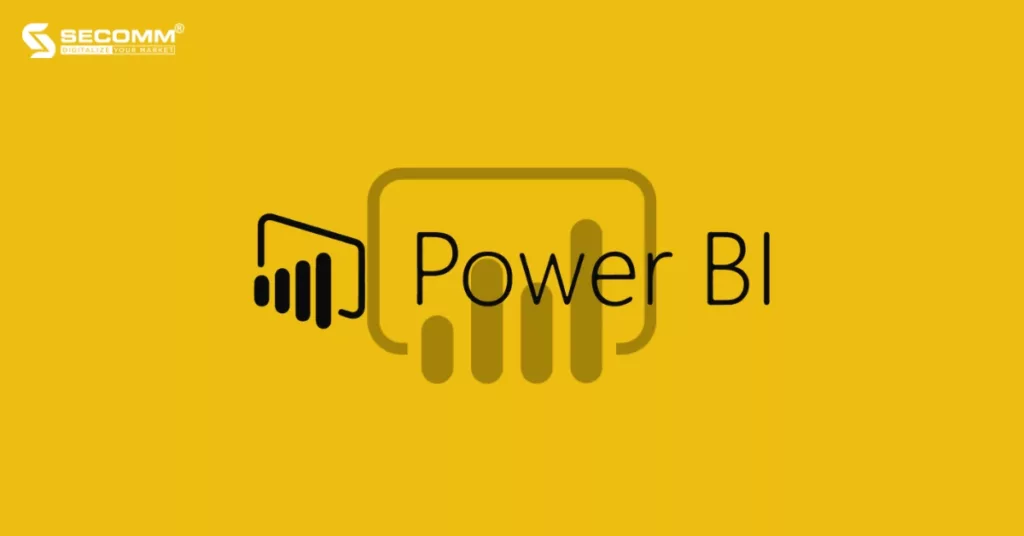
Advantages:
Disadvantages:
Looker is a popular BI system used for data visualization and analysis in large enterprises. This system allows users to access, explore, and analyze data most intuitively.
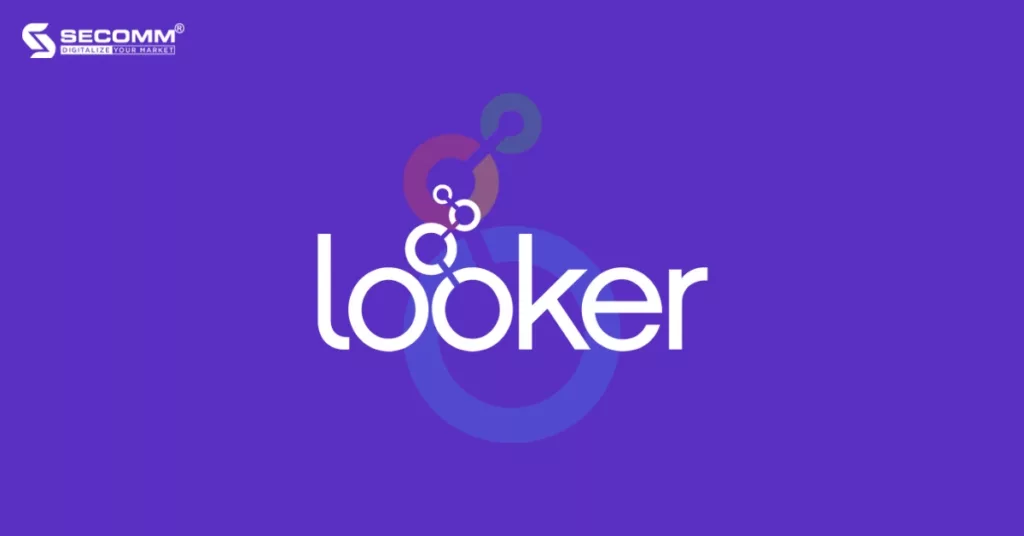
Advantages:
Disadvantages:
Amazon QuickSight is a serverless BI service operating on the cloud, developed by Amazon and released on February 22, 2022. Amazon QuickSight provides tools for data visualization, interactive dashboards, and machine-learning-supported data analysis.
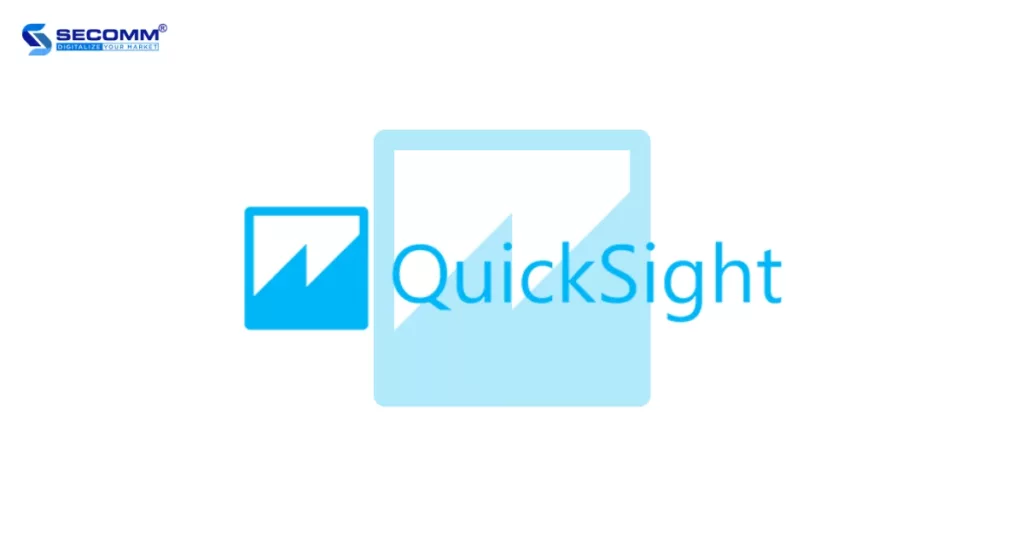
Advantages:
Disadvantages:
ThoughtSpot is a self-service BI system developed in 2012. This system allows users to easily search, query, and visualize data, making it a popular choice among businesses.
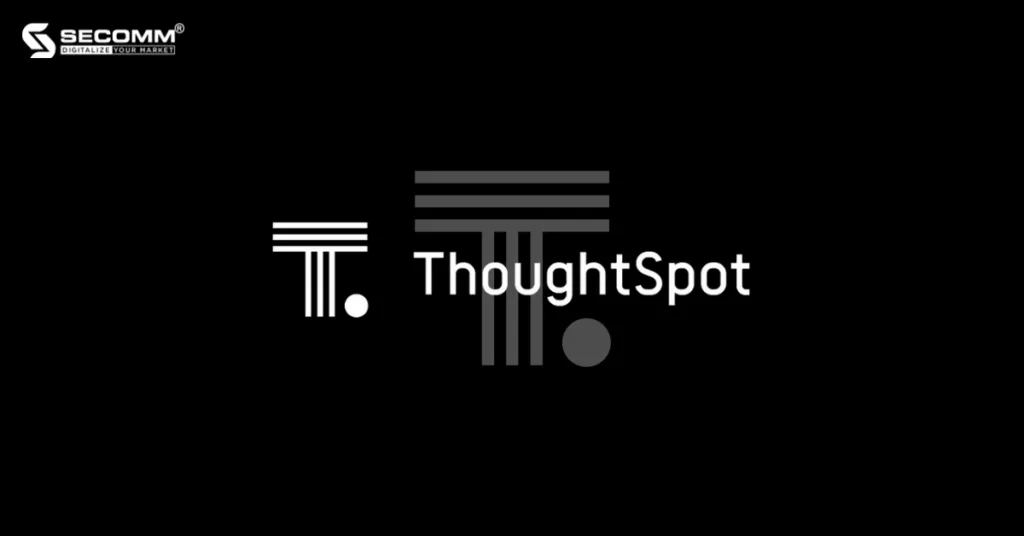
Advantages:
Disadvantages:
View more: What is PIM? The 5 best PIM software for large enterprises
The above is a summary of 5 BI software options for large-scale enterprises, detailing the individual advantages and disadvantages of each system. Depending on the needs for BI system development and budget planning, businesses can consider and choose the most suitable BI solutions.
Contact SECOMM to learn more detailed information!
 2
2
 12,400
12,400
 0
0
 1
1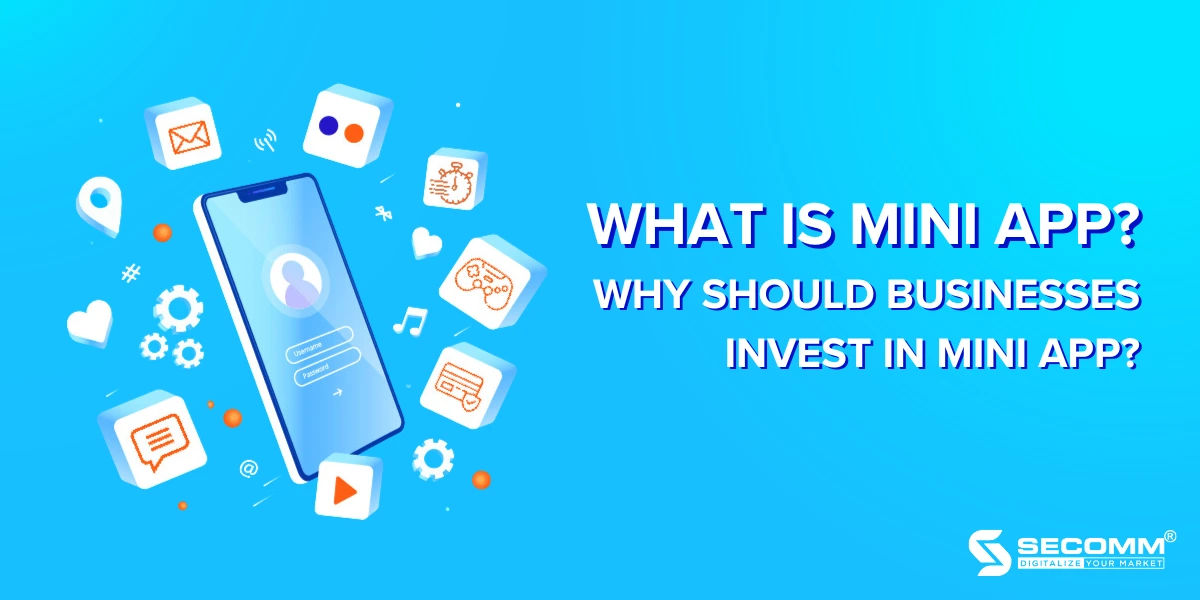
Mini Apps or Mini Programs are small applications developed within Super Apps, allowing users to access them without the need for frequent downloads or updates like Native Apps (applications for Android and iOS) or Hybrid Apps (cross-platform applications)
Currently, there are various types of these apps, but the most popular ones include:
For example: Mini App on Momo
In addition to internal apps like ‘Heo Đất Momo’ or ‘Đi bộ cùng MoMo,’ MoMo has ambitious plans to expand its ecosystem by integrating these apps from partner brands. This e-wallet has allowed the integration of these apps from various brands in different sectors such as 7Eleven, AhaMart, Highlands Coffee, etc.
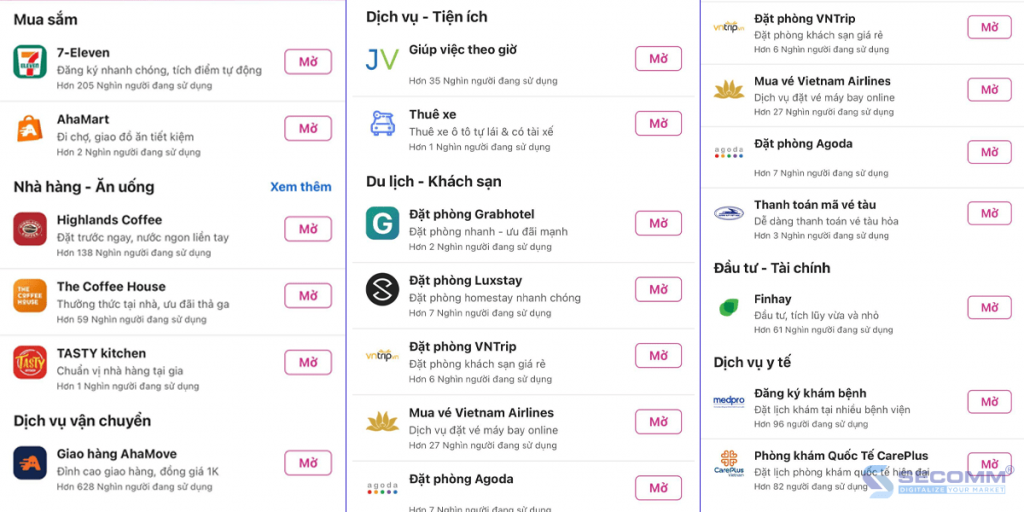
All Super Apps such as MoMo, Tiki, Shopee, Lazada, and Zalo allow other brands to register for free. However, businesses must pay for in-house IT teams or outsource to external units to develop these apps.
Compared to Native Apps or Hybrid Apps, Mini Apps have a simpler framework (pre-written code segments) and useful APIs (Application Programming Interfaces), enabling developers to deploy applications quickly within a cost-effective budget.
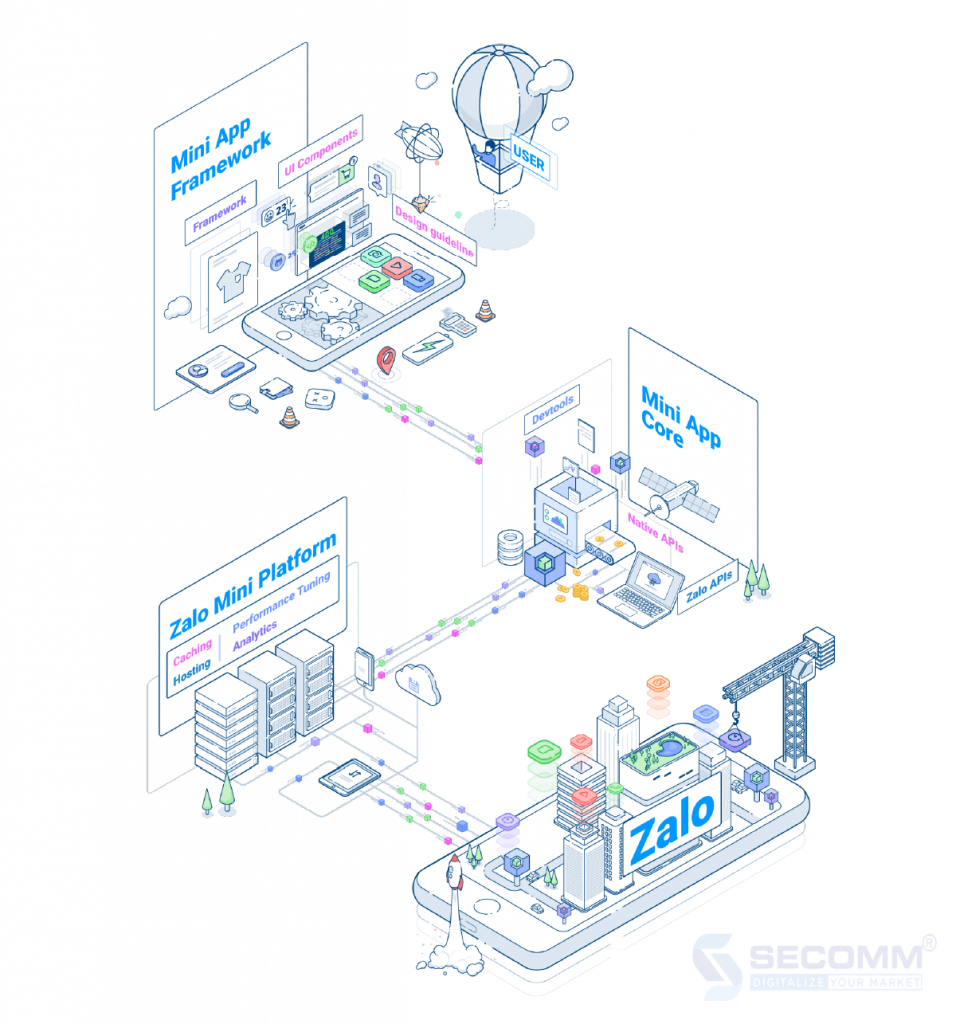
When businesses release these apps on Super Apps such as MoMo, Zalo, Tiki, Lazada, and Shopee, these brands gain access to and leverage millions of existing users. Here are the user statistics for some of these platforms:
Moreover, these apps can also take advantage of the existing utilities within the ecosystem of these “Giant” Apps, such as online payment, delivery services, marketing tools, etc.
These apps typically have very low file sizes, averaging around 10MB. This allows these applications to deliver a smooth user experience. By leveraging the ecosystem provided by “Giant” Apps, customers can have a seamless experience encompassing various activities such as shopping, payment, order tracking, customer support communication, voucher accumulation, etc., all within a single application.
During the eCommerce journey, businesses go through various stages: Social media commerce (Facebook, Zalo) → Selling on eCommerce platforms (Shopee, Lazada, Tiki, Sendo) → Mini App → Basic eCommerce website and app → Advanced eCommerce website and app.
Among these, these apps serves as a perfect stepping stone for businesses to adapt to technological infrastructure, navigate the eCommerce environment, and launch more effective online business campaigns.
While these apps are no longer unfamiliar globally, the term is still relatively new in Vietnam. Currently, in Vietnam, only Tiki has a dedicated team developing Mini Apps for businesses on the Tiki platform (Tini App). To develop these apps on other Super Apps, businesses must engage with development teams or agencies specialising in this area.
When releasing a Mini App, businesses must trade off the risk of customer data being in the hands of the ‘big players’ because all source code and data are stored on the servers of the “Giant” Apps.
Not expressing the full uniqueness of the business: Although each app is unique to individual businesses, it has to adhere to certain standards set by the “Giant” Apps, including frameworks, APIs, UI components, etc., to synchronize the interface with the ‘parent app.’ While this can provide a consistent user experience, it may not showcase the brand’s distinct personality.
In general, these apps serve as a perfect stepping stone for any business looking to enter the eCommerce market by leveraging the advantages of “Giant” Apps. However, limitations such as technical resources, user data, and brand positioning need to be carefully weighed before making a final decision.
 2
2
 17,712
17,712
 0
0
 1
1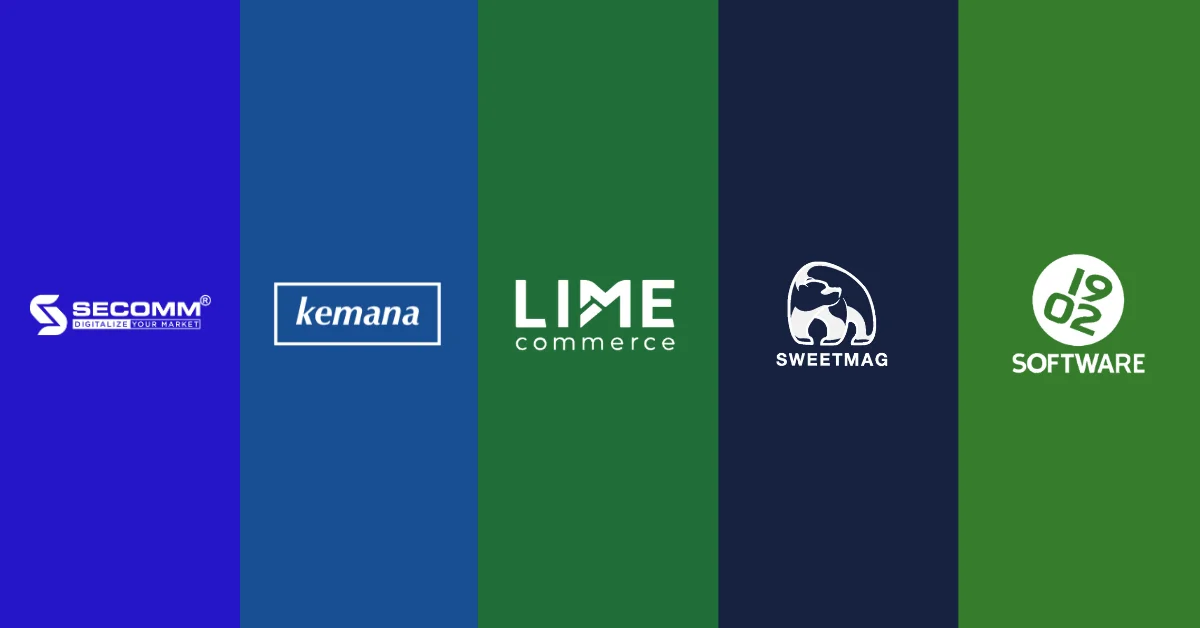
The eCommerce landscape in SEA is experiencing robust growth, with a CAGR of 11.43%. The anticipated total revenue for 2023 is projected to reach USD 109 billion, as reported by Statista. Moreover, there are over 2000 eCommerce websites built on the Magento platform within this market.
For most Magento deployment projects, collaboration with experienced developers on this platform is crucial. This partnership ensures joint planning, design, and development of customized websites tailored to the specific requirements of each business.
This article will delve into why Magento remains the preferred platform for eCommerce website development and spotlight the top 5 Magento developers in the SEA region, including Kemana (Indonesia), Lime Commerce (Indonesia), SECOMM (Vietnam), Sweetmag (Malaysia), and 1902 Software (Philippines).
Magento is an open-source eCommerce platform built using the PHP programming language and the Zend Framework. In 2018, Adobe officially acquired Magento and rebranded it as Adobe Commerce, aiming to integrate this platform into Adobe’s suite of digital solutions.
This merger has enhanced Magento’s capabilities and provided businesses with a more comprehensive eCommerce solution powered by Adobe.
Magento has two main versions: Magento Open Source – a free version (formerly known as Magento Community Edition) and the paid version called Adobe Commerce (formerly Magento Commerce).
The paid version offers users two options: on-premise and on-cloud, with numerous upgraded features and enhancements to meet higher demands for customization and scalability.
Being an open-source platform, Magento provides businesses with the flexibility to access and modify source code, functionalities, themes, and extensions. Moreover, Magento can efficiently handle up to 500,000 daily visits and imposes no restrictions on annual sales volumes.
According to BuiltWith, there are currently over 144,000 active Magento websites including several global brands experiencing significant traffic, such as:
Notably, some high-traffic eCommerce websites in the Southeast Asian market are also using Magento, such as:
These leading brands leverage the Magento platform to execute complex customizations for their eCommerce systems, enhancing their capabilities in handling high traffic, extensive product catalogs, and substantial sales volumes. Therefore, for any business seeking a highly customizable and scalable eCommerce platform, Magento is likely the first name that comes to mind.
Headless Commerce is an eCommerce trend with 80% of businesses planning to adopt this approach within the next two years, according to Salesforce’s “State of Commerce” report.
For the demands of Headless architecture, the open-source Magento platform stands out as an optimal choice. Unlike traditional Magento architecture, Headless Magento utilizes GraphQL API to support various frontend designs for different devices and screens. This setup is optimized and integrated into the existing backend system to deliver a seamless omnichannel experience.
Moreover, Adobe offers enterprises an advanced suite to enhance the efficiency of Headless Commerce operations. This suite includes Adobe Experience Manager (Content Management), Adobe Analytics (In-depth analytics reporting), and Adobe Marketo Engage (Marketing automation).
According to Emergen Research, the global Progressive Web App (PWA) market is expected to reach 10.44 billion USD by 2027. Therefore, it’s not surprising that many businesses are turning to Magento’s PWA Studio features. This toolkit facilitates the rapid development, launch, and maintenance of PWAs.
Moreover, businesses adopting Headless Commerce can seamlessly integrate with PWA Studio to customize frontend designs. PWAs are often combined with Headless architecture to create Headless PWAs, replacing conventional frontends with PWA storefronts to enhance website performance.
Moreover, Magento PWA utilizes Service Worker technology for device caching, significantly boosting page load speeds by 2 to 3 times.
Magento boasts a thriving and engaged community comprising developers, designers, and users. This community consistently generates modules, themes, plugins, and integrated add-ons for the Magento platform.
Moreover, there are many Magento developers in the market, making it easy for businesses to find a suitable partner.
In addition, prominent forums like Reddit, Quora, Substack, Slack Groups, and online conferences provide platforms for Magento users to exchange knowledge and experiences.
Hence, beyond direct support from collaborative partners, these forums serve as invaluable resources whenever businesses face challenges or require assistance throughout the Magento deployment journey.
Magento is designed to meet almost every need when it comes to creating professional and custom eCommerce websites.
However, not all businesses have the technical expertise and understanding of Magento to start and successfully implement this platform. This is why many businesses seek to collaborate with Magento developers to bring their ideas and business goals to life.
Below are 5 Magento agencies in South East Asia, boasting exceptional experience and expertise.
SECOMM (Vietnam)
SECOMM is known as a provider of comprehensive and specialized eCommerce solutions tailored to each business model and requirement.
Established in 2014, SECOMM has successfully collaborated on and developed Magento eCommerce websites for numerous major clients spanning from Australia, Singapore, Hong Kong to Vietnam, including LaybyLand, Changi Airport Group, My Market, Annam Group, and Vinamilk.
Going beyond Magento website development collaborations, SECOMM and its clients strategically outline sustainable short and long-term development plans, ensuring continued leadership in the targeted markets.
With vast experience in executing over 300 custom Magento website development projects for clients worldwide, SECOMM has firmly established itself as a premier professional Magento developer in Vietnam.
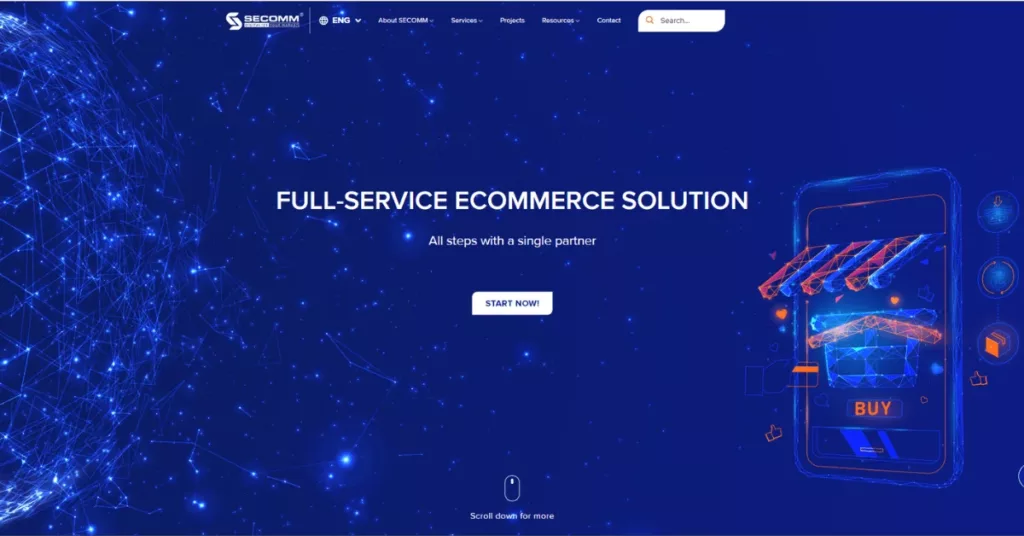
Established in 2011, Kemana Technology is a private company consisting of a team of experts with over a decade of experience in the eCommerce industry. Recognized as an official Silver partner of Adobe, Kemana stands out as a leading Magento developer in the broader APAC region and specifically in Indonesia.
When it comes to eCommerce website development services, Magento is the core technology solution that the company suggests to its clients.
Moreover, Kemana leverages Magento’s exceptional customization capabilities to deliver Omnichannel deployment solutions for retailers, offering two primary services: Click & Collect (Pick Up In-store) and Ship From Store.
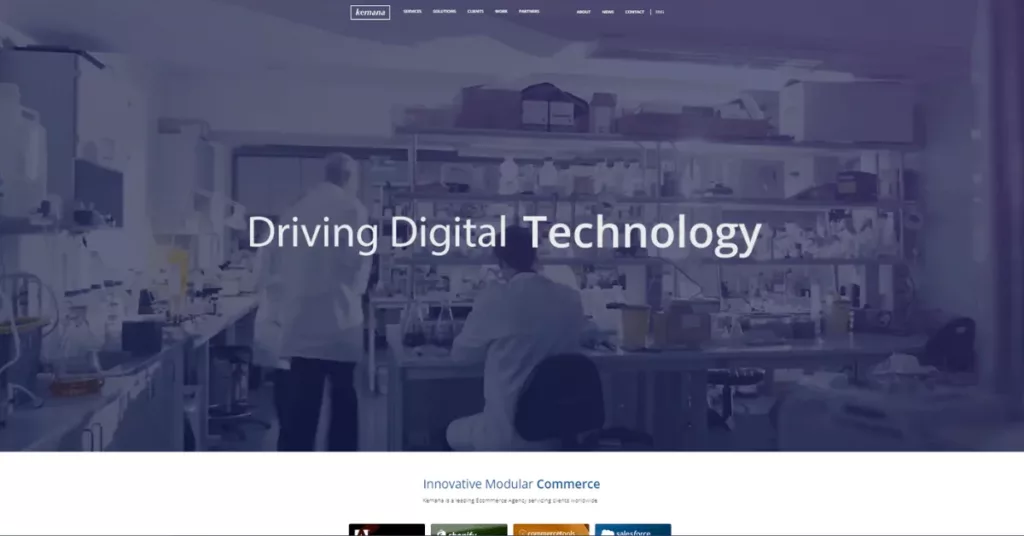
Similar to Kemana Technology, Lime Commerce is also among the top Magento developers in Indonesia. Established in 2014, the company holds the Bronze partnership status in the Adobe Solution Partner Program. Lime Commerce provides personalized solutions tailored to meet the deployment needs of each customer segment.
As a dedicated eCommerce development company focusing on Magento, Lime Commerce offers a range of comprehensive services and solutions related to the Magento platform.
This includes custom design and development of Magento eCommerce websites, system maintenance and updates, optimization of website performance and security, and implementation of various crucial integrations.
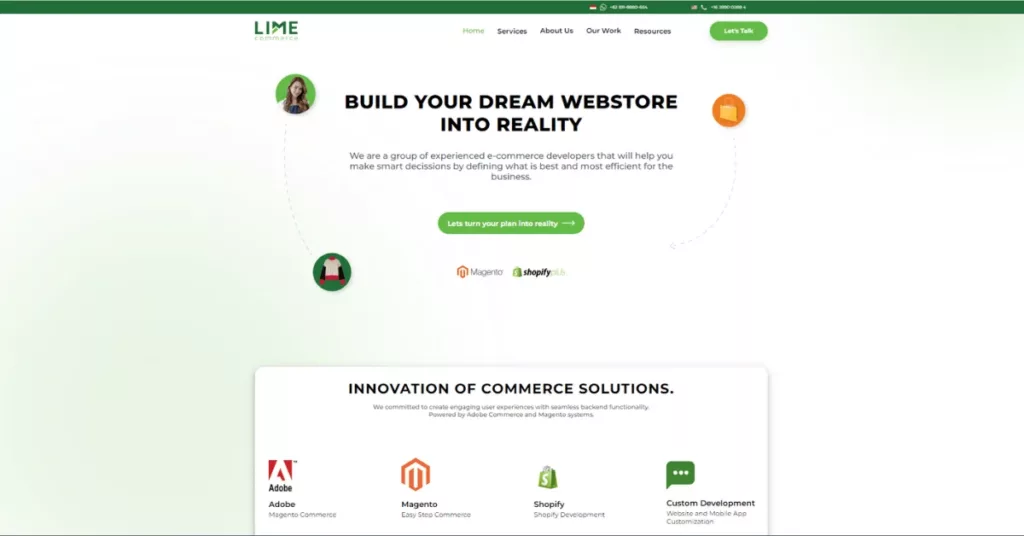
Established in 2008, Sweetmag Solutions has distinguished itself as a premier provider of Magento website development solutions in Malaysia, offering a range of associated web services. Over the years, Sweetmag has achieved Bronze-level partnership status in the Adobe Solution Partner program.
Sweetmag provides a seasoned team to build Magento eCommerce websites to meet specific requirements and objectives related to customer experience and conversion.
Through collaborations with prominent brands like Padini, Innisfree Malaysia, Parkson Online, and Caring Pharmacy, the company has firmly established its position in the Malaysian eCommerce market.
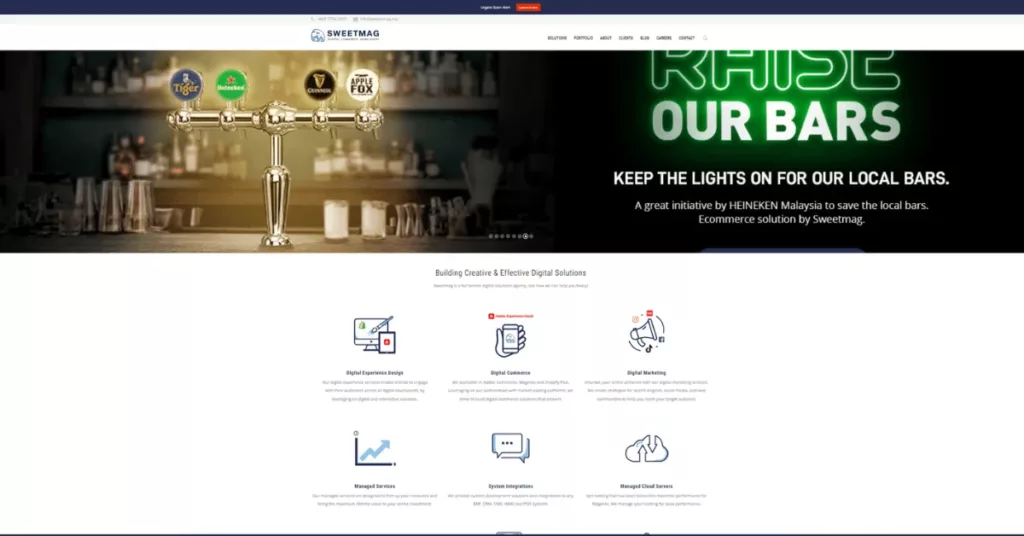
Founded and operated since 1998 by Danish programmer Peter, 1902 Software has evolved into a prominent software development and eCommerce solutions company in the Philippines. Their key services include AI development, eCommerce solutions, custom software development, and innovative design, all of which contribute to their notable reputation.
In the realm of eCommerce development, the company excels in delivering solutions for creating powerful, flexible, and scalable Magento websites. With a track record of successful projects, 1902 Software has earned positive reviews from satisfied clients.
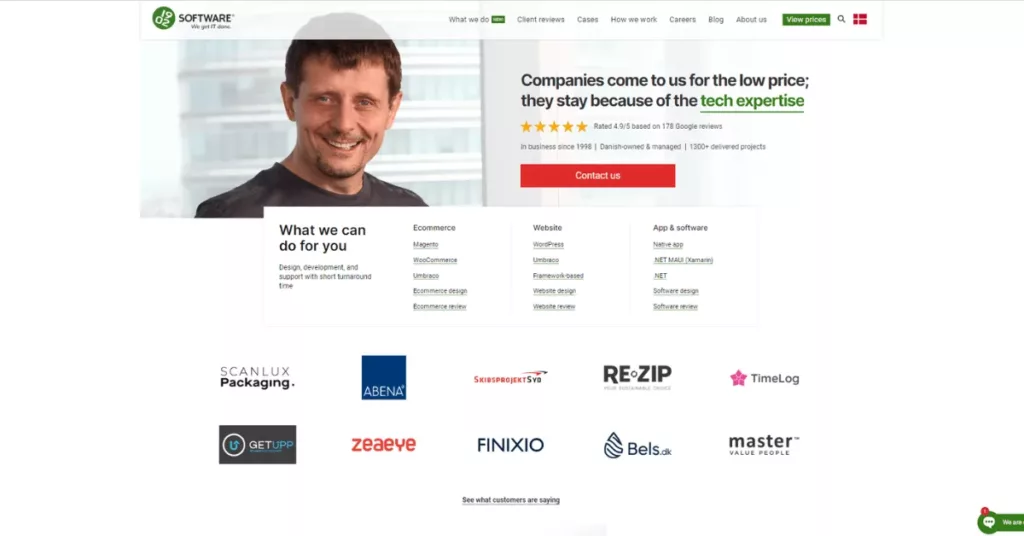
The effectiveness and popularity of Magento are demonstrated by the numerous businesses, spanning from medium-sized enterprises to large corporations, that have successfully implemented and operated their eCommerce websites on this platform. Moreover, the global Magento developer community is extensive, and the Southeast Asian region is no exception, featuring top-notch specialists with high technical expertise and extensive experience in Magento, as mentioned in the article.
Contact or call SECOMM’s hotline at (+84)28 7108 9908 to build your Magento eCommerce website today!
 2
2
 7,914
7,914
 0
0
 1
1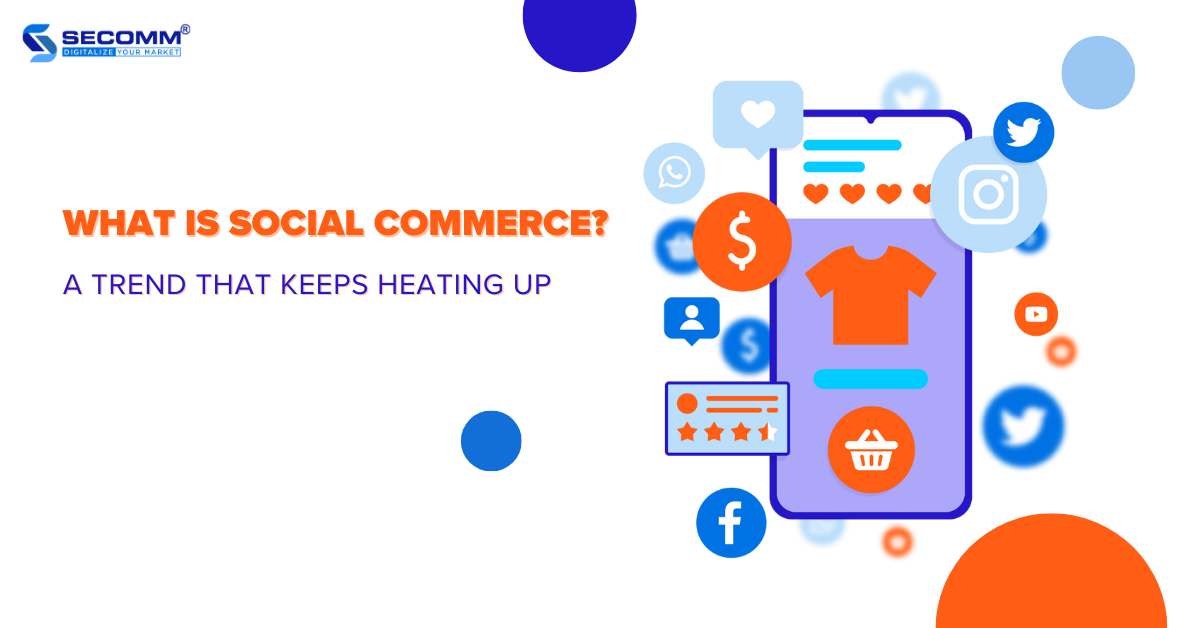
As per Statista’s data, Social Commerce worldwide generated 992 billion USD in revenue in 2022, with projections indicating a potential surge to 2.9 trillion USD by 2026. This positions Social Commerce as a highly valued and potential trend in the future of eCommerce.
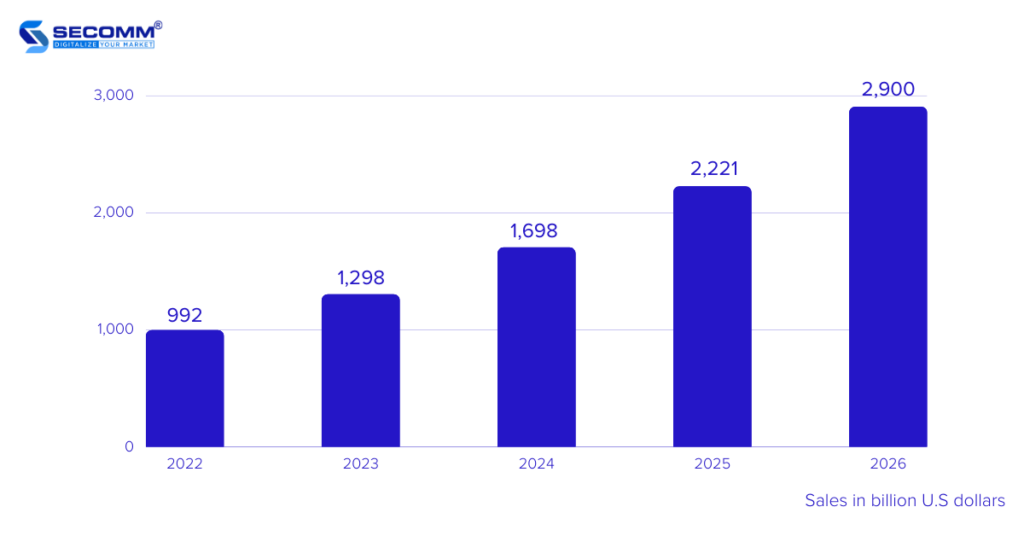
Social Commerce is a term that combines two key concepts: “Social” and “Commerce”.
It represents a business model that seamlessly integrates social media and eCommerce, aiming to create a shopping experience that is more interactive and connected for customers.
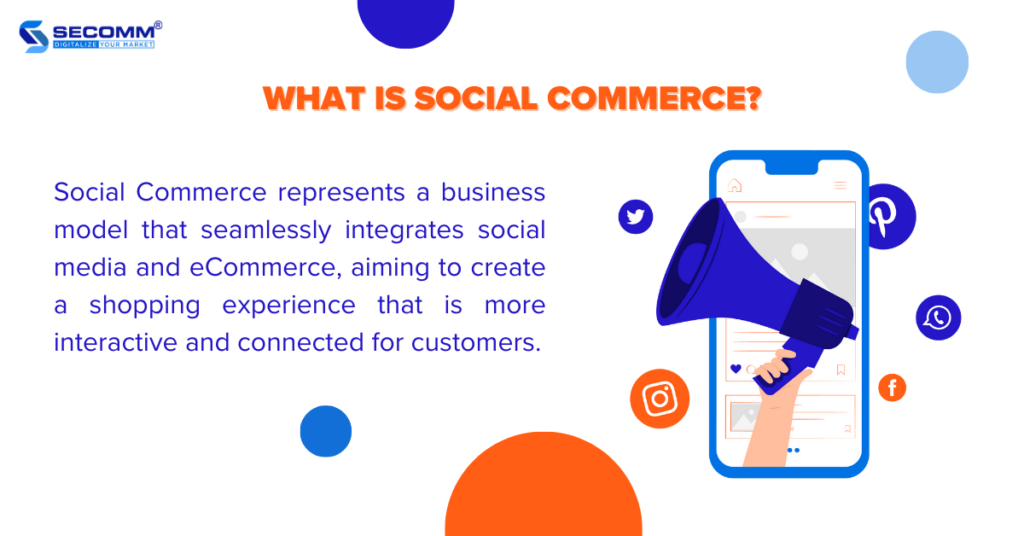
Social Commerce enables users to view and purchase products directly through social media platforms such as Facebook, Instagram, TikTok, etc.
This approach allows customers to delve into product details, read reviews, engage with comments from other users, and even make direct purchases through business posts, advertisements, or social platform storefronts.
The Social Commerce model often comes with interactive features, product-sharing capabilities, and personalized product recommendations.
Social Commerce takes advantage of the widespread popularity and extensive user base on social media platforms to naturally amplify the reach and influence of products and brands.
Social Commerce and eCommerce are two distinct online business models, yet they share the common goal of online commerce. Here are the differences between these two models:
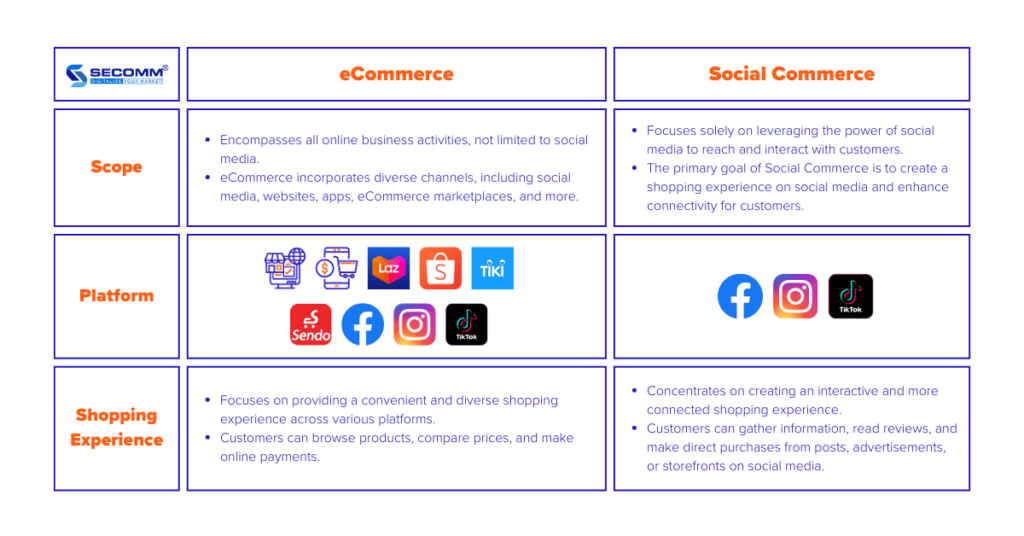
There are various popular types of social commerce, and the choice depends entirely on the scope and objectives of each business. Here are some common types of social commerce:
Social Commerce facilitates businesses in reaching millions of users across various social media platforms, particularly globally popular ones like TikTok, Facebook, Instagram, and Pinterest.
This approach not only boosts brand awareness but also promotes businesses’ products and services to the extensive user base on these platforms, creating organic traction through user sharing and interaction.
The renowned sportswear brand Nike has successfully implemented Social Commerce by leveraging engaging posts, videos, and advertisements on social media platforms such as Facebook, Instagram, and Twitter.
The brand consistently runs advertising campaigns encouraging users to share their product experiences. Through user-generated posts and the strategic use of specific hashtags, Nike has sparked natural virality, resulting in an increased level of brand recognition.

A key feature of social commerce is its focus on creating a seamless online shopping experience for users, simplifying the transition from product browsing to actual purchases. Customers can buy directly from posts, advertisements, or online stores on social media platforms.
This not only streamlines the shopping process but also enables businesses to optimize customer experiences, save time, and boost the eCommerce sales volume for the brands.
The cosmetics brand L’Oréal has created various TikTok channels for each target market in its beauty chain, such as lorealparis (global), lorealparisusa (U.S. market), lorealparis_vn (Vietnamese market), lorealparisid_shop (Indonesian market), lorealparisth_store (Thai market), and so on.
This approach not only allows the brand to reach the right target audience but also takes advantage of TikTok Shop, enabling customers to purchase products directly through L’Oréal’s TikTok channel.
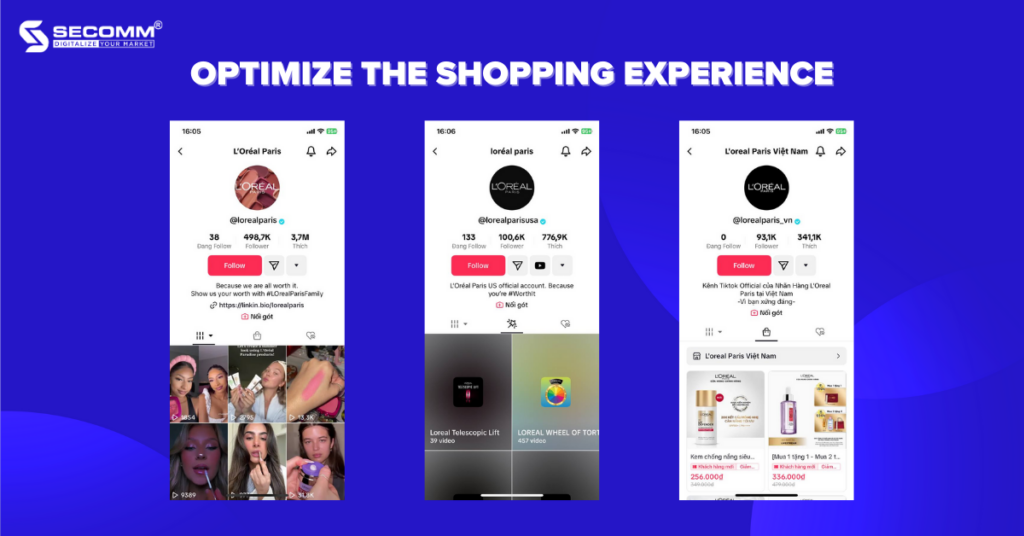
Presently, social media platforms offer comprehensive analytics and data measurement tools for businesses. For instance, Instagram Insights provides demographic information such as gender, age groups, and geographic locations.
Facebook Audience Insights goes a step further in collecting detailed data about a business’s target audience, while TikTok Pixel allows tracking vital metrics like clicks, views, and conversion rates, and assessing the effectiveness of advertising campaigns.
Leveraging these data sources assists businesses in creating more efficient social commerce campaigns compared to traditional retail operations. A noteworthy example of the successful implementation of Social Commerce with optimized tracking and measurement is Fashion Nova.
This prominent American fashion brand specializes in offering women’s clothing and accessories. Fashion Nova’s Instagram posts often incorporate sharing and user tracking features, enhancing the dissemination of information about products and the brand.
Furthermore, Fashion Nova utilizes Instagram’s measurement features and analytical tools to evaluate the effectiveness of the brand’s marketing and advertising campaigns.
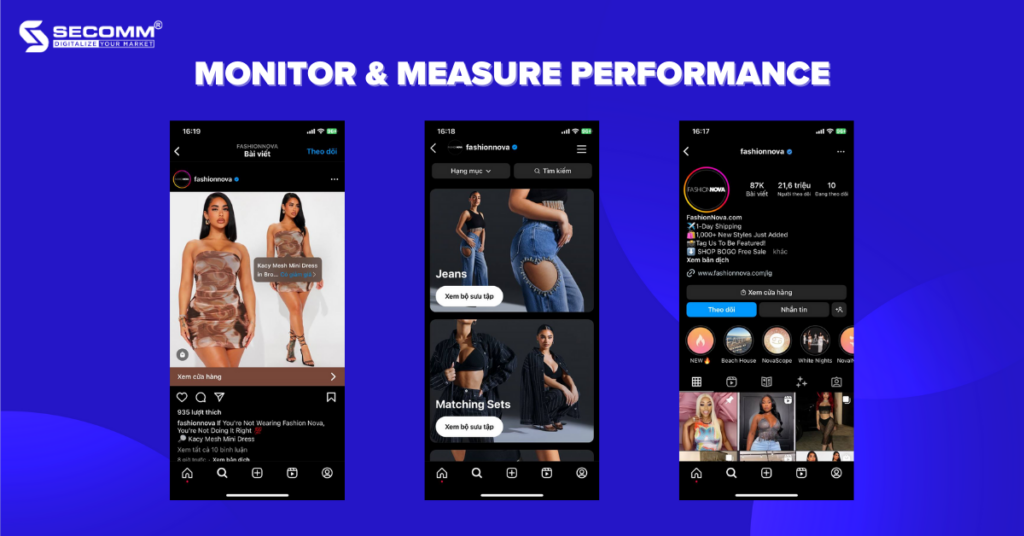
Embracing social commerce enables businesses to seamlessly engage in direct interactions with customers and gather their feedback regarding the brand or product through posts, direct conversations, comment responses, and messages.
This facilitates quick customer support, addresses inquiries promptly, fosters satisfaction and fortifies customer relationships. Moreover, based on this valuable customer feedback, businesses can refine their products/services to align with customer expectations.
Tarte Cosmetics, a renowned cosmetics brand specializing in makeup and skincare products, has effectively utilized social media platforms such as Instagram, Facebook, and Twitter to implement social commerce. The brand consistently engages with customers across social media channels.
The administrative team promptly responds to user comments and messages, addressing inquiries and offering technical support. This approach builds trust and satisfaction among customers, actively strengthening positive customer relationships.
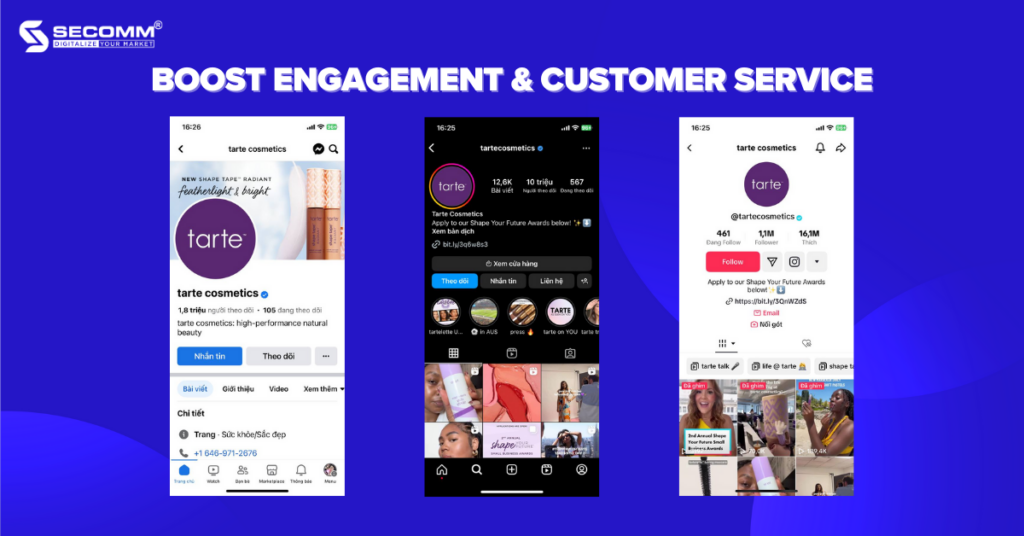
Here are insights, advantages, and examples of businesses effectively embracing Social Commerce. Depending on each business’s strategy, administrators can blend social media and eCommerce to engage customers and establish a brand in the current digital era.
Related Reading: eCommerce: Inbound Marketing vs Outbound Marketing
Contact SECOMM or directly call the hotline at 02871089908 today for complimentary guidance on implementing eCommerce Marketing overall and Social Commerce specifically.
 3
3
 8,692
8,692
 0
0
 1
1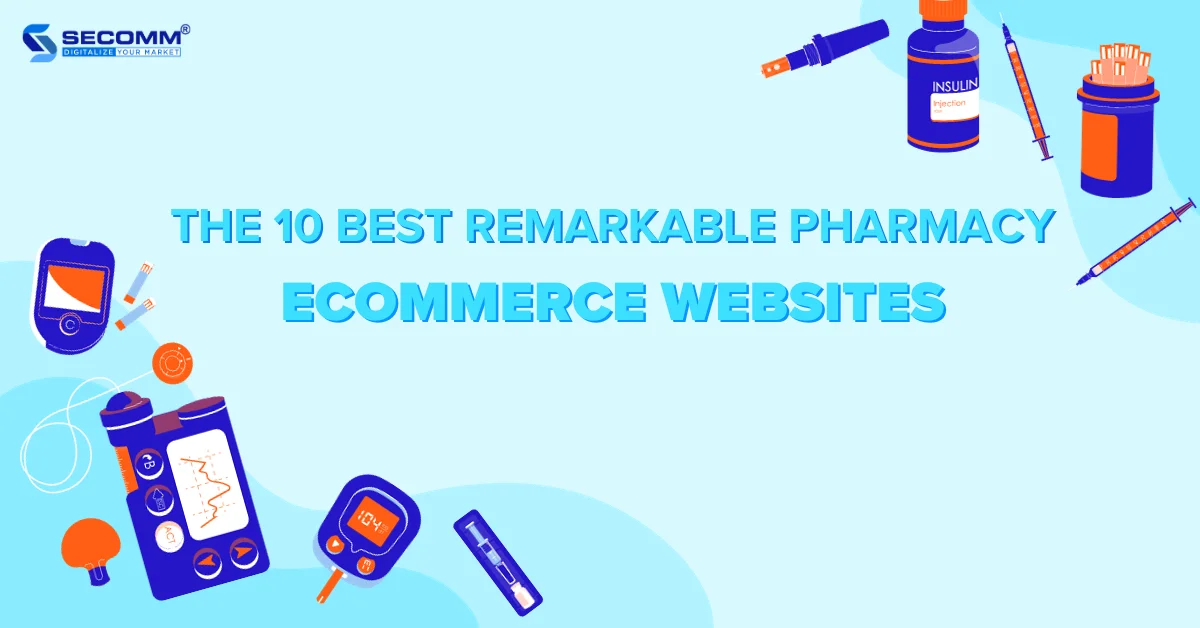
The eCommerce trend has quickly extended to various sectors of the economy. The explosion of online pharmacies, both domestically and internationally, demonstrates the significant impact this trend is having on the pharmaceutical industry.
Typically, the first step in the online presence strategy of these pharmacies is the professional establishment of an eCommerce website.
Here are 10 pharmaceutical brands in Vietnam and on the global stage that have effectively launched eCommerce websites and swiftly captured a significant share of this market.
CVS Health is a major player in the U.S. healthcare sector and stands as the largest retail pharmacy chain in the country, boasting over 9,900 physical stores. CVS also offers an array of healthcare services, encompassing general health check-ups, diagnostics, and dental care.
The CVS pharmacy eCommerce website is built upon the Oracle Commerce platform, equipped with numerous features to ensure an optimal user experience and scalability for the future. Notably, it includes a prescription management feature that empowers customers to oversee their prescriptions through their CVS accounts, request prescription refills, and receive medication deliveries at their doorstep. Furthermore, the online drugstore allows customers to schedule appointments with two options: in-person clinic visits or remote telehealth consultations via video calls.
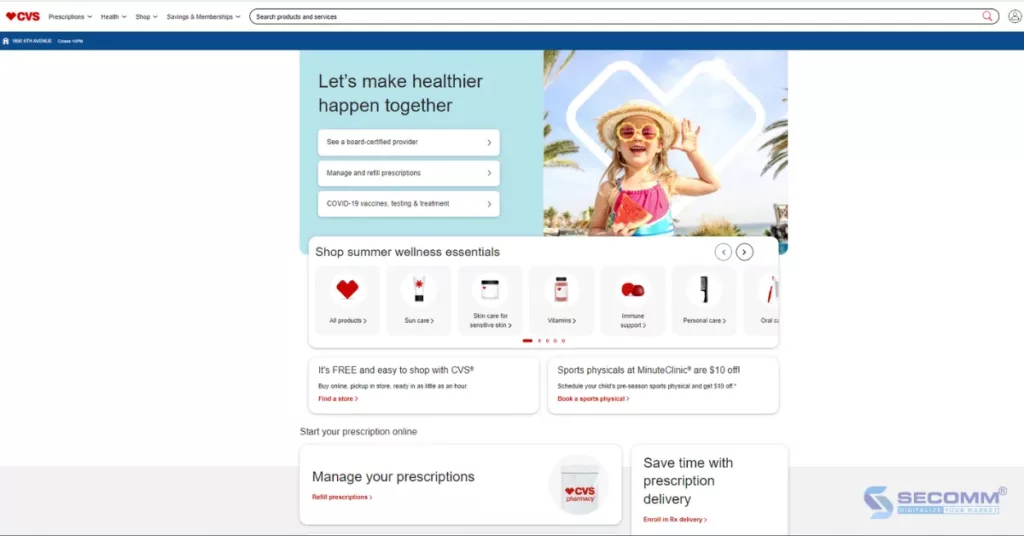
Established in 1890, Droga Raia has continually grown and, over the years, has become one of the foremost pharmacy chains in Brazil. Despite its long-standing legacy, Droga Raia hasn’t lagged in the eCommerce trend.
With an average monthly website traffic of 19.8 million, Droga Raia opted for Magento to facilitate its pharmacy eCommerce website. This choice was well-founded, given the platform’s superior flexibility for customization and scalability, ensuring the capability to manage high traffic volumes and cater to future system expansion needs.
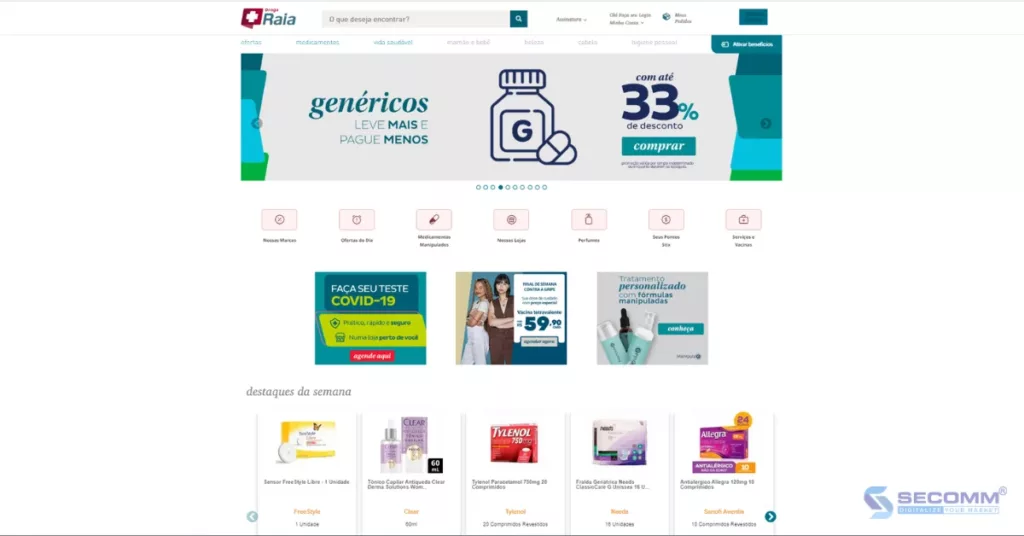
Apollo Pharmacy, a well-known retail pharmacy chain in India, operates as a subsidiary of Apollo Hospital. Over the years, Apollo has expanded its chain of stores to thousands, serving cities and towns across India.
Apollo built its online pharmacy on the Magento platform, equipped to manage a vast product portfolio. In addition to offering both prescription and non-prescription medications, as well as healthcare products, Apollo provides various related services. These services encompass online consultations, health check-up appointment scheduling, vaccination bookings, and insurance sales. Currently, the website garners 12.7 million monthly visits.
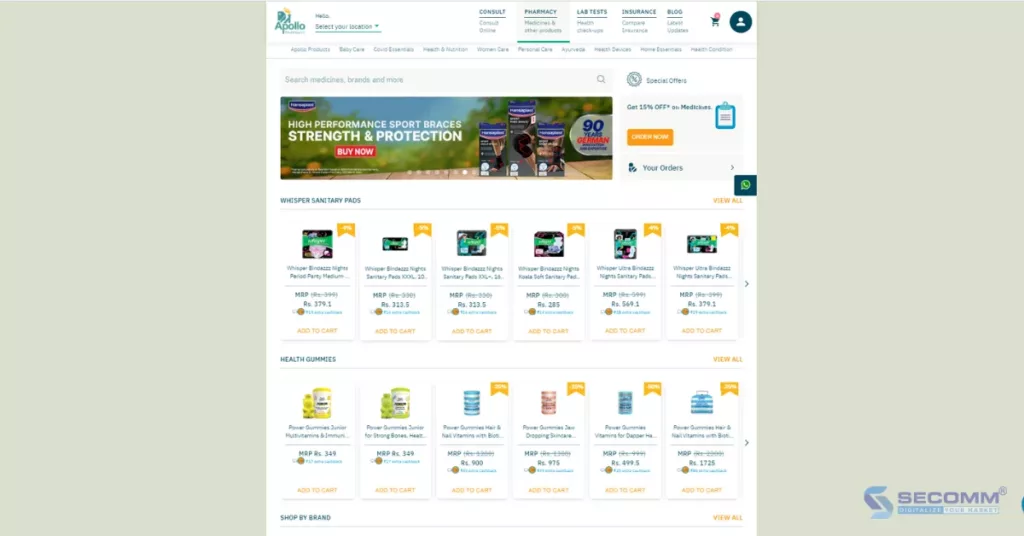
Another well-known online drugstore in India is Netmeds. In addition to prescription and non-prescription drugs, this brand offers a diverse range of healthcare products, including items for maternity and baby care, medical equipment, and dietary supplements for fitness enthusiasts, vegetarians, and those with diabetes. Netmeds also relies on Magento to develop its pharmacy eCommerce website, featuring various capabilities to enhance the user experience. These include product categorization with accompanying images, non-prescription product search recommendations, real-time product availability checks at specific stores, prescription upload options, and home delivery requests. At present, Netmeds’ website averages around 10.4 million monthly visits.
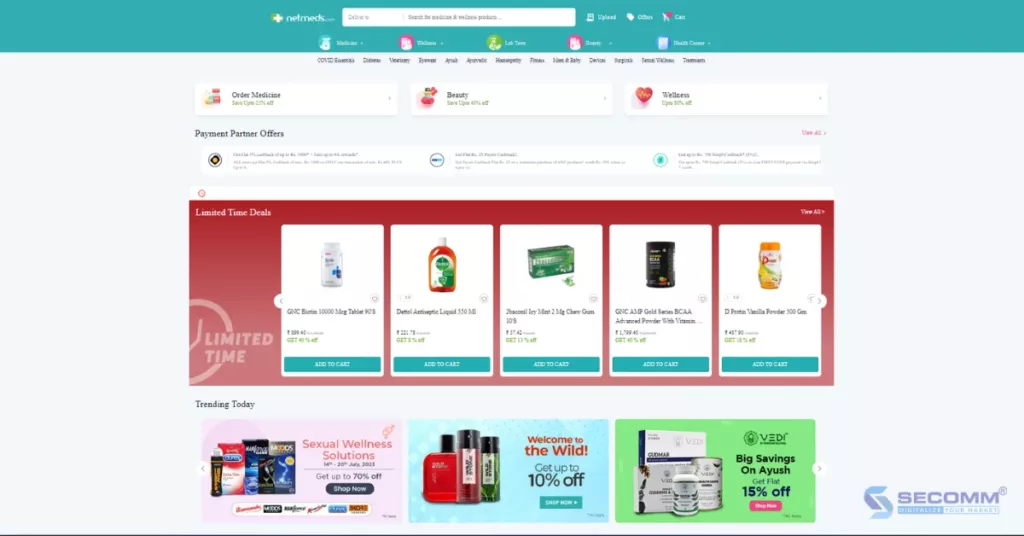
Nahdi Online is the leading pharmacy eCommerce website in Saudi Arabia and ranks among the region’s largest retail pharmacy chains. This marks the fourth pharmacy on the list utilizing the Magento platform to craft a user-friendly website enriched with advanced features, facilitating product-specific searches, in-depth product descriptions, and price comparisons for customers. Moreover, through Nahdi’s online pharmacy, users can access various online consultation and healthcare services or book appointments at the clinic.
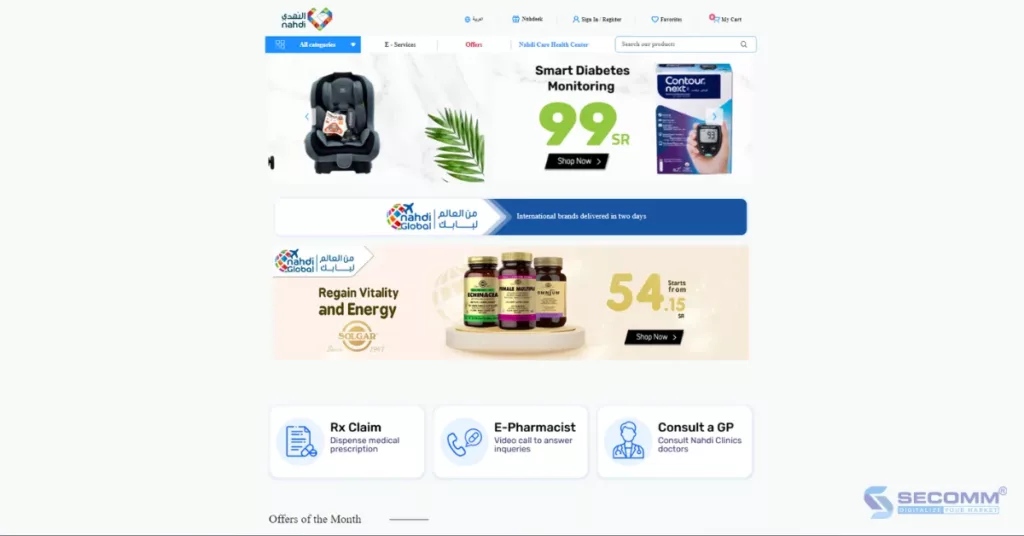
An Khang Pharmacy, one of the most trusted pharmacy chains in Vietnam, was established in 2012 and has since expanded to over 500 pharmacies nationwide. Additionally, the brand has introduced a pharmacy eCommerce website and a mobile app to cater to consumers’ online pharmaceutical needs, complete with a variety of enticing offers.
An Khang provides a wide array of products, including medications, dietary supplements, medical equipment, personal care items, and cosmetics. Moreover, the An Khang website features a dedicated section for disease lookup, allowing customers not only to make purchases but also to access information on various common diseases, including their causes, symptoms, treatment methods, and prevention.

FPT Long Chau, established in 2015, has a presence in over 1,000 stores across all 63 provinces in Vietnam and is a pioneer in the modern online pharmacy model. Both its pharmacy eCommerce website and app have gained strong favor from consumers for their rich and seamless shopping experience.
Notably, Long Chau leads the way in offering a Buy Now, Pay Later service with 0% interest, helping to ease the financial burden on patients. Furthermore, customers can access guidance from Long Chau’s experienced pharmacists through a hotline or chat service. Currently, the Long Chau website attracts approximately 5.2 million monthly visitors.

In the pharmaceutical market of Vietnam, Pharmacity is the third name mentioned in the fierce “three-horse race” taking place in both the online and offline channels. This company was founded in 2011 and currently has over 1,000 stores nationwide. Similar to An Khang and Long Chau, Pharmacity has also launched an eCommerce website and app with various promotional programs to provide customers and patients with a convenient and quick shopping experience, along with online consultation services from a team of highly professional pharmacists. Currently, the Pharmacity website attracts an average of 2.7 million monthly visitors.
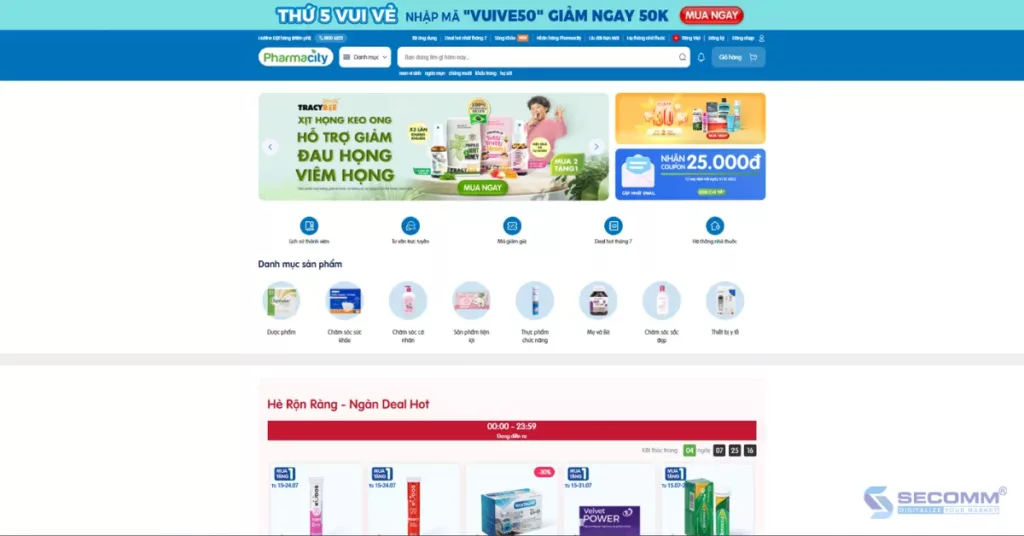
This is one of the most reputable and high-quality online pharmacy systems in Vietnam. The pharmacy offers a wide range of genuine pharmaceutical products, dietary supplements, health, and beauty care items from major global brands. Central Pharmacy’s drugstore provides various features to enhance the shopping experience for customers, such as search suggestions, search filters, and integration of messaging applications (FB Messenger and Zalo) on the website for customer support, prescription uploads, and home delivery requests. To date, the website has attracted more than 587,000 monthly visitors.
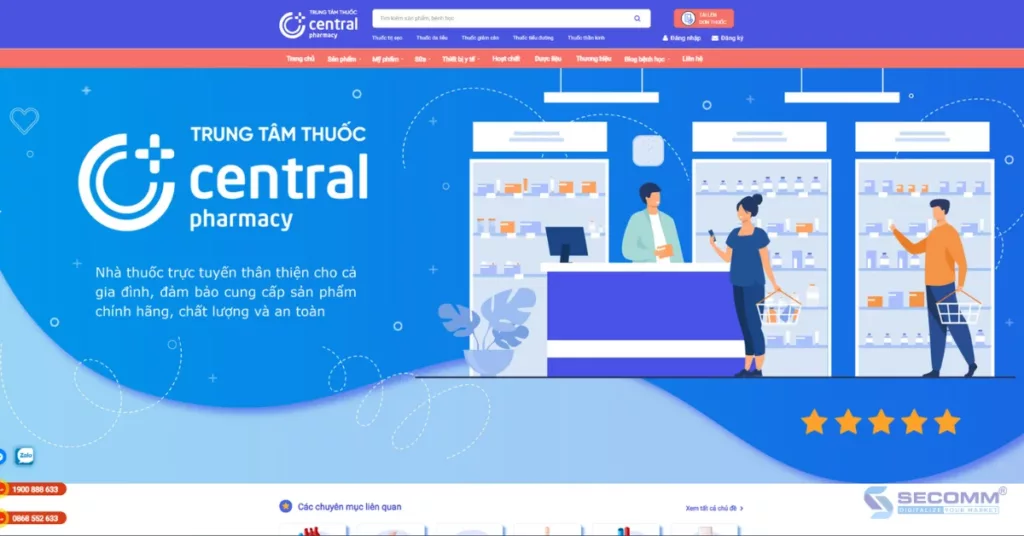
Nha Thuoc Than Thien is a retail chain that meets GPP standards in Vietnam. Specializing in prescription and over-the-counter medications, as well as various healthcare products, this establishment has embraced a hybrid model, combining both offline and online pharmacy services. The primary sales channel is its user-friendly eCommerce website, developed using WooCommerce. The website is intuitively designed, incorporating essential features to facilitate customer product searches, seamless transactions, and order tracking. With around 410 thousand monthly visits, the website continues to serve a significant audience.
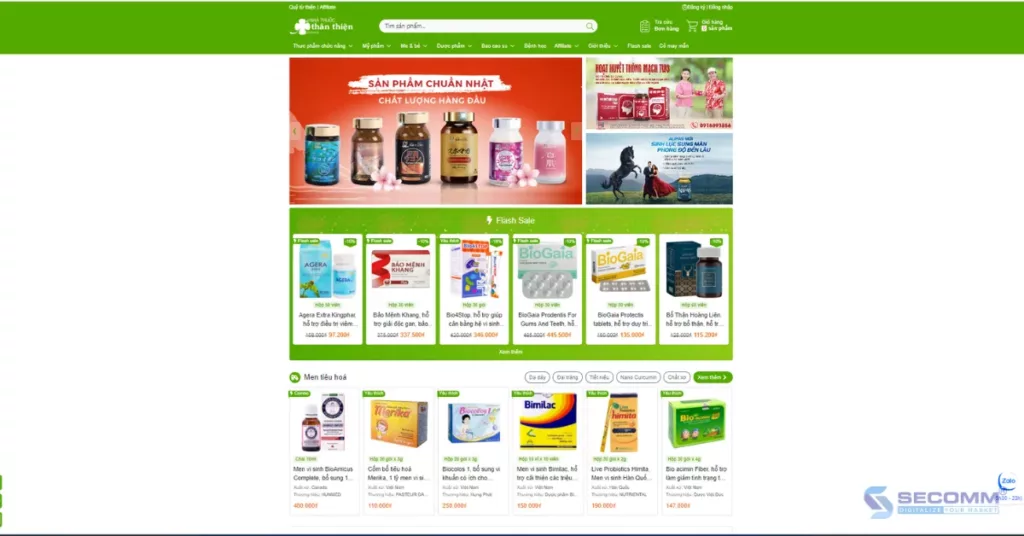
Here are the top 10 eCommerce websites, including leading online pharmacies, in both the Vietnamese and international markets. These brands demonstrate their adaptability to consumer trends and their efforts in developing technological infrastructure to compete in the multibillion-dollar market.
With a wealth of experience in successfully implementing eCommerce solutions for numerous clients across various countries in recent years, SECOMM specializes in providing consulting services with professional eCommerce deployment solutions tailored to the specific needs of each industry.
Feel free to contact or call SECOMM’s hotline directly at (02871089908) for a free consultation.
 2
2
 13,212
13,212
 0
0
 1
1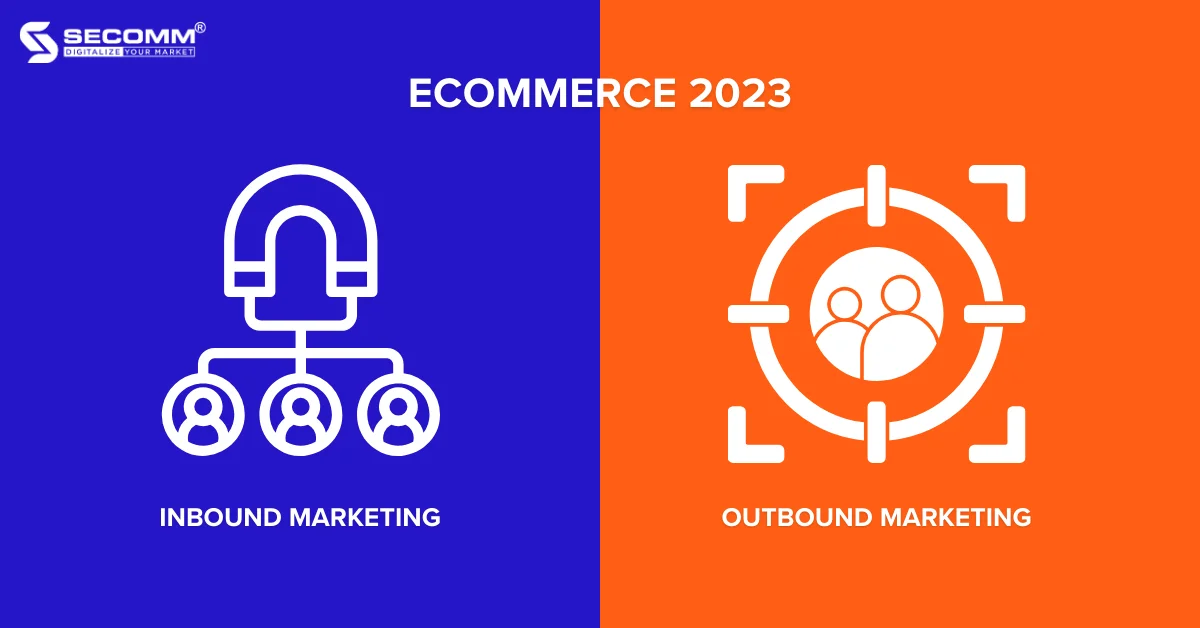
Inbound Marketing and Outbound Marketing are two widely used marketing approaches that businesses often mix. Although they are common, many businesses still need to distinguish between these two types of marketing. Which is the most suitable strategy for businesses to implement Inbound Marketing and Outbound Marketing in the eCommerce world?
Inbound Marketing is a marketing approach that focuses on engaging customers by offering valuable content and delivering a meaningful customer experience.
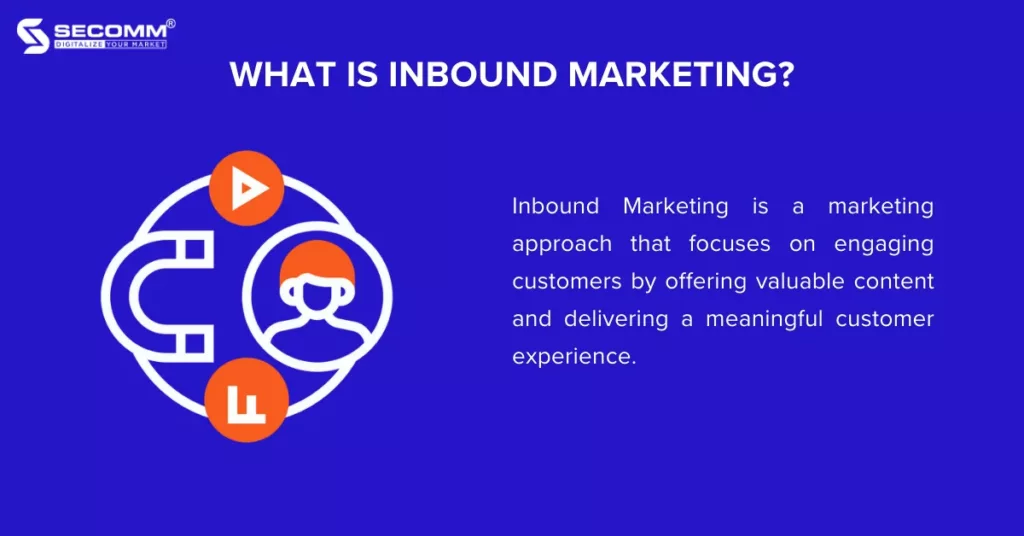
Key strategies employed in Inbound Marketing include:
Outbound Marketing is a conventional marketing approach where businesses proactively reach out to customers by sending marketing messages to a broad targeted audience.
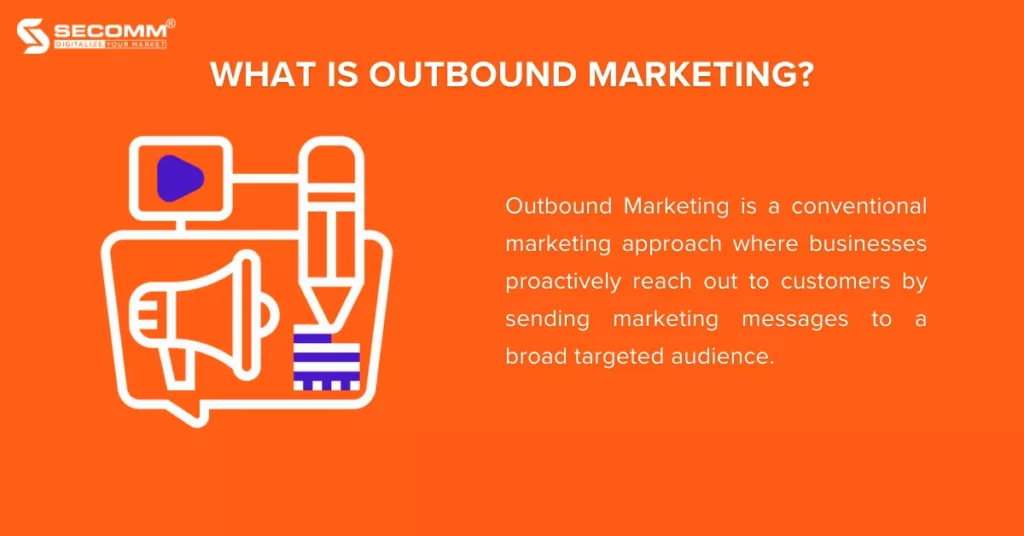
Here are some primary methods employed in Outbound Marketing:
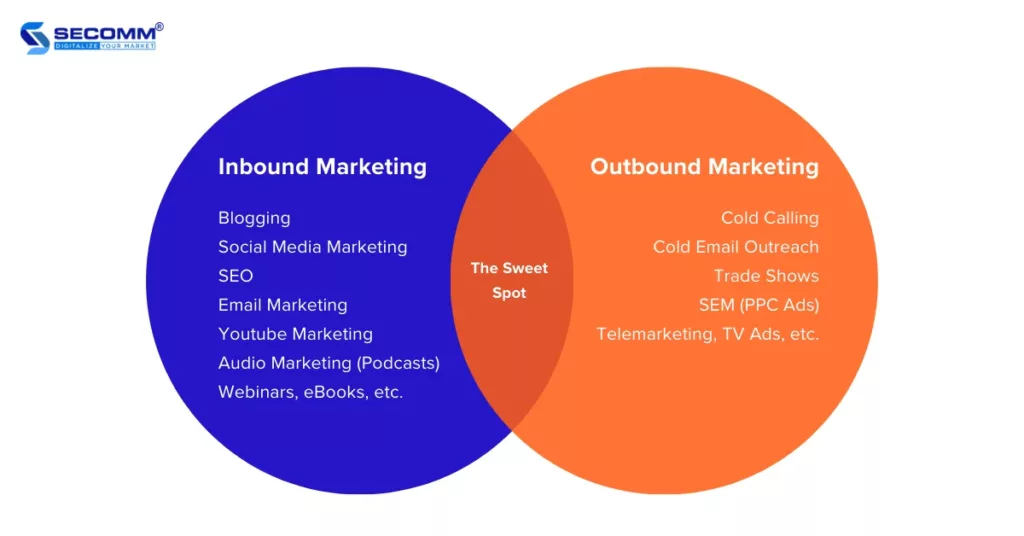
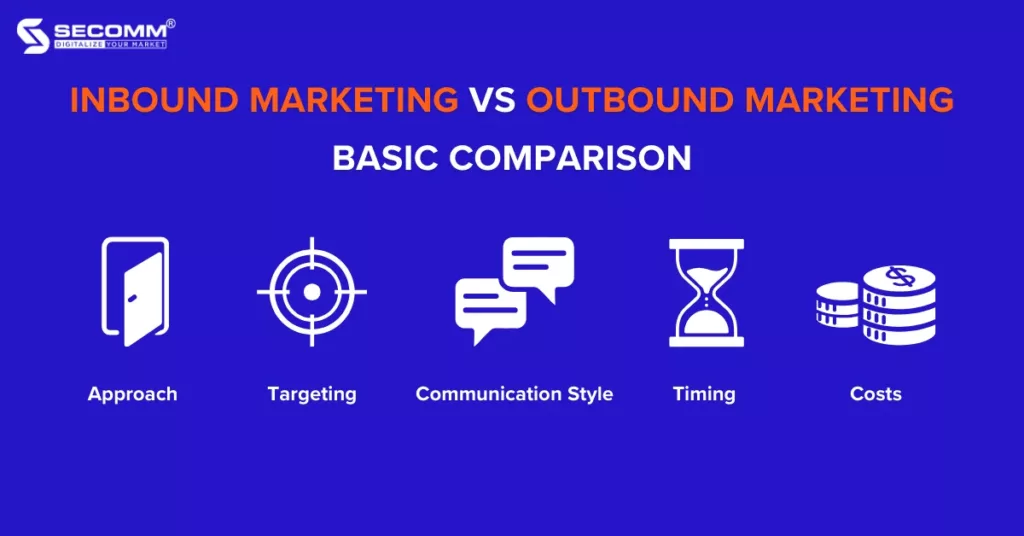
Inbound Marketing centers around the customer, prioritizing the attraction of potential customers through valuable content and experiences. In the realm of eCommerce, Inbound Marketing primarily revolves around establishing relationships and engaging with customers through the business’s website or eCommerce app.
Conversely, Outbound Marketing takes a product-centric approach, aiming to send marketing messages to a wider audience. Outbound Marketing involves reaching potential customers through diverse channels like advertising, direct mail, or telemarketing.
Inbound Marketing focuses on attracting and connecting with specific, targeted audiences through the creation of relevant and valuable content. Its goal is to draw in potential customers actively seeking information or solutions related to the business’s products or services.
On the other hand, Outbound Marketing establishes a broader network and targets a wider audience, typically relying on demographics or general interests. The goal of Outbound Marketing is to reach a large number of people with the hope of grabbing the attention of potential customers.
Inbound Marketing promotes two-way communication, where businesses actively participate in conversations with potential customers, giving priority to listening, understanding customer needs, and offering valuable information or solutions.
Outbound Marketing typically involves one-way communication, with businesses delivering marketing messages to the audience without immediate interaction. The primary objective is to raise awareness and generate interest in the business’s products or services.
Inbound Marketing tends to have a long-term orientation as it revolves around building trust and credibility over time, nurturing potential customers until they are ready to make a purchase. However, it may require some time to see results.
On the other hand, Outbound Marketing is typically linked to immediate outcomes or short-term goals. Its primary focus is on generating potential customers or immediate sales by actively promoting products and services through channels such as paid advertising or telemarketing.
Inbound Marketing can offer long-term cost savings as this strategy relies on creating valuable content, optimizing online presence, and leveraging channels that the business controls, such as optimizing the eCommerce website/app, SEO, and managing social media pages. While it may require an initial investment of resources and time, the returns on this investment can be significant over time.
Conversely, Outbound Marketing often entails upfront expenses, such as advertising costs. The expenses can vary depending on the selected channels and the scale of the target audience.
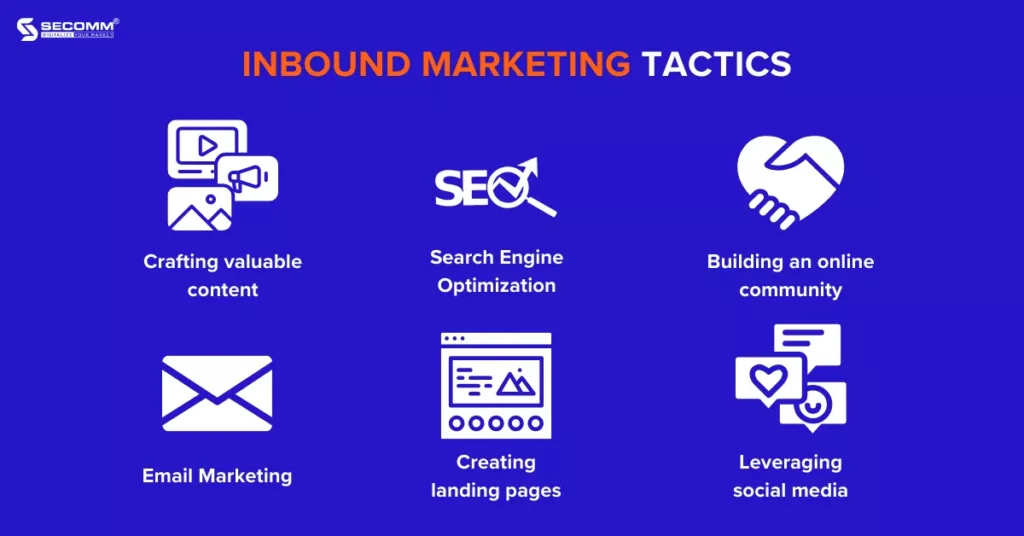
In the world of eCommerce, Inbound Marketing employs the principles and strategies of Inbound Marketing to attract and engage potential customers. Here are several common Inbound Marketing methods applied in eCommerce:
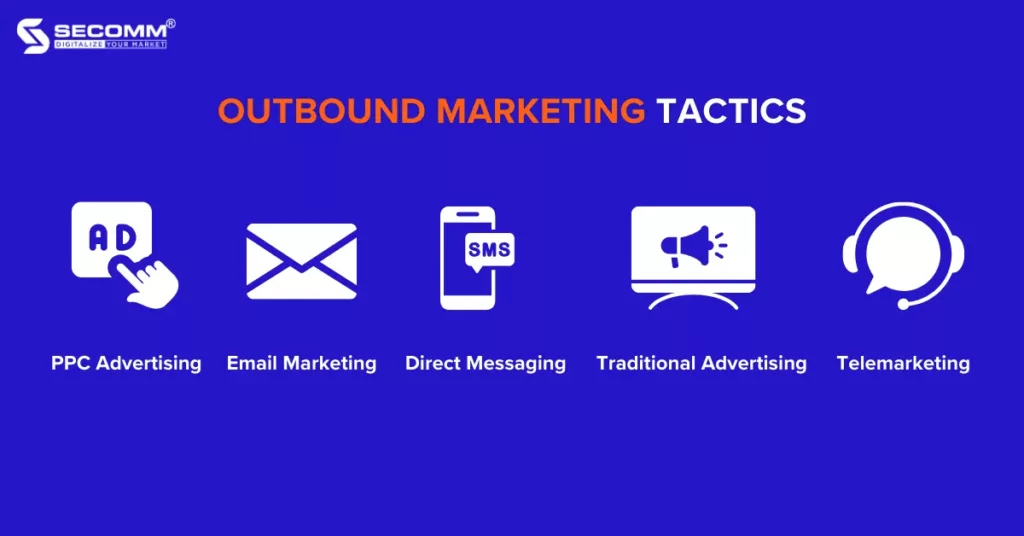
In the eCommerce world, Outbound Marketing employs the methods and strategies of Outbound Marketing to build brand recognition among a broad customer base with the objective of boosting online sales. Here are some common Outbound Marketing techniques typically utilized in eCommerce:
In essence, Outbound Marketing in eCommerce can rapidly establish brand recognition and reach a large online audience, but it also necessitates consideration of effectiveness and the response of potential customers, with the ultimate goal of increasing online sales.
Here is a summary of the basic information about Inbound Marketing and Outbound Marketing in eCommerce. Depending on their individual needs, businesses will allocate time and budget for Inbound Marketing and Outbound Marketing accordingly.
Contact or call the SECOMM hotline at 02871089908 today for a free consultation on the implementation of eCommerce Marketing.
 2
2
 11,123
11,123
 0
0
 1
1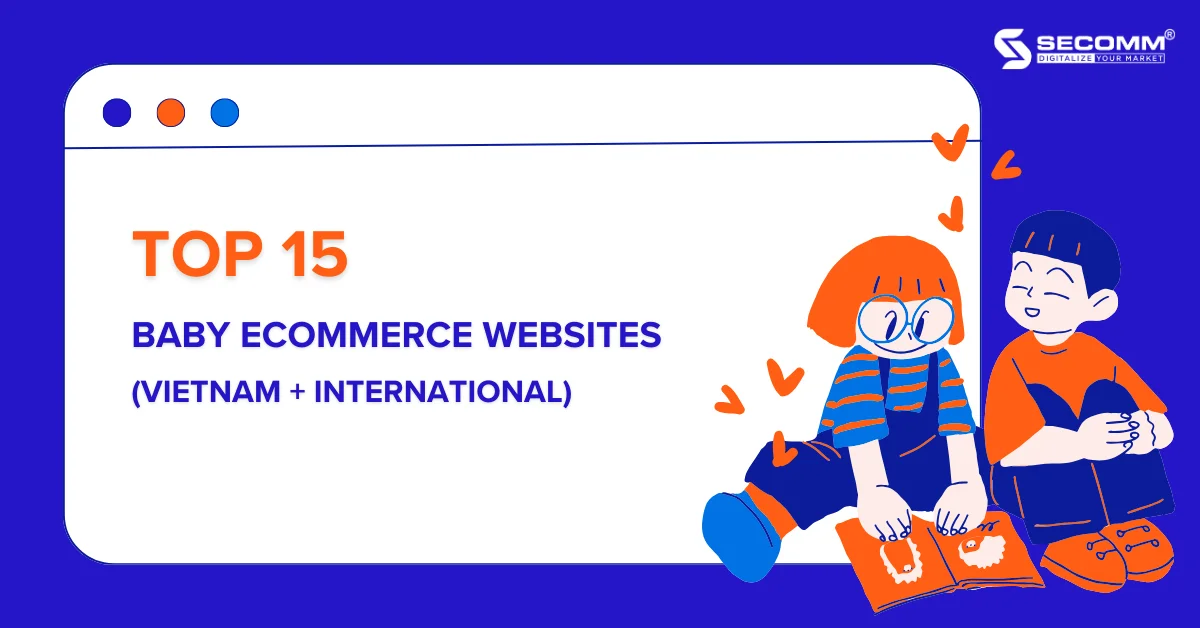
The global business landscape has faced significant challenges due to the Covid-19 pandemic. In response to this, many businesses across various sectors, particularly in the Baby industry, have prioritized the implementation of eCommerce strategies to connect with online customers and drive sales. Furthermore, to align with the broader economic trends, these retailers have transitioned from traditional business models to robust eCommerce operations to ensure growth and market expansion.
The following list showcases 15 successful Baby brands in Vietnam and around the world that have effectively adopted eCommerce websites, thus facilitating the swift participation of numerous other businesses.
Ava Kids is the Baby eCommerce website of The Gioi Di Dong Corporation, offering a range of enticing online shopping benefits to customers. These include a 1-month return policy, complimentary shipping, special discounts for new customers, a rewards program, and informative guides for maternal and child health care.
Having been in operation for over a year, Ava Kids’ eCommerce website now enjoys over 2.1 million monthly visitors and has expanded its offline store network from 5 to 66 outlets.
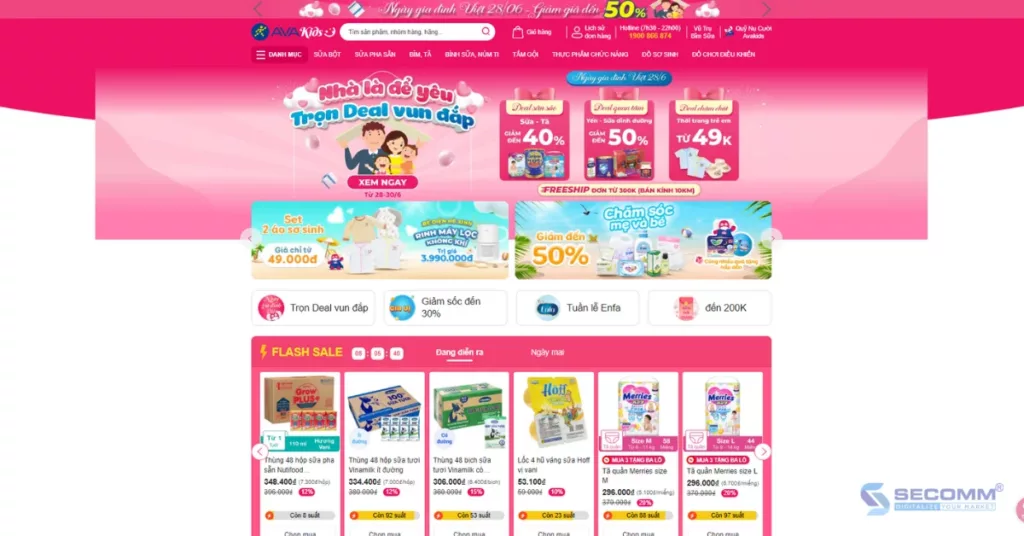
Established in 2011, Con Cung has grown to become Vietnam’s leading retail chain specializing in products for expectant mothers and babies, boasting over 700 stores across the country.
In recent years, Con Cung has made significant strides in developing its eCommerce website, catering to the online shopping demands of its customers. This expansion has enabled them to provide a rich shopping experience with a wide range of enticing offers, flexible payment methods, and 1-hour delivery services.
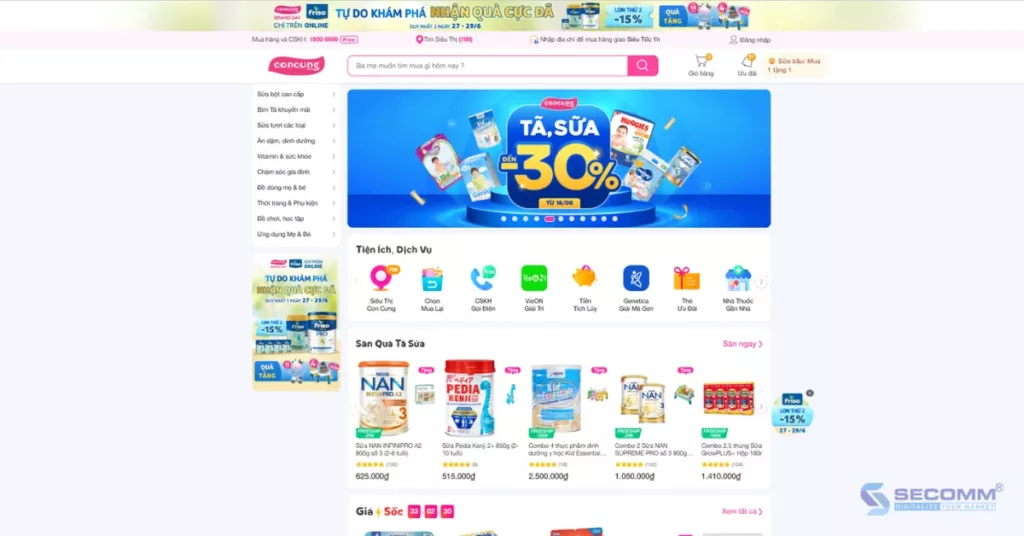
Founded in 2009, Kids Plaza is a major player in the eCommerce competition for the Baby industry. Kids Plaza has built an eCommerce website on the Magento platform to efficiently manage a vast and diverse product catalog. The brand consistently runs enticing promotional campaigns, offering gift-with-purchase deals, flash sales, buy-5-get-1-free offers, and a loyalty points system for redeemable rewards. These efforts have significantly driven up website traffic during promotional events, making Magento’s customization and scalability features indispensable for handling sudden surges in visitor numbers. On average, the website garners approximately 1 million visits per month.
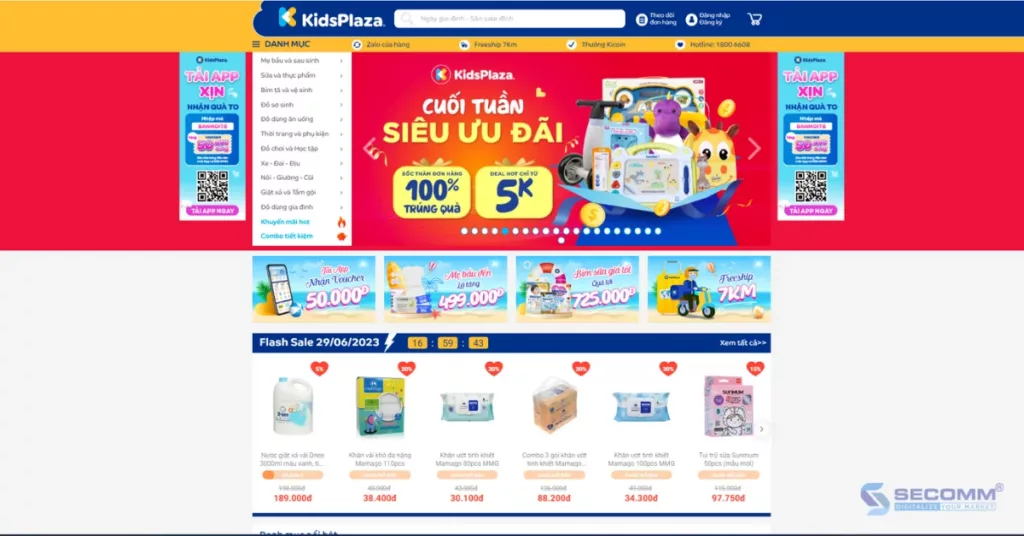
Founded in 2006, Bibo Mart, a retail chain dedicated to serving expectant mothers and babies, offers a diverse range of products, including maternity clothing, diapers, formula, and strollers. Just like its competitors, Bibo Mart is a strong contender in the eCommerce race.
To enhance the customer shopping experience, Bibo Mart opted for Magento Enterprise Edition (aka Adobe Commerce) to develop a custom eCommerce website. This platform enables the implementation of attractive promotions and a Loyalty Program. Presently, the website enjoys more than 500,000 monthly visitors.
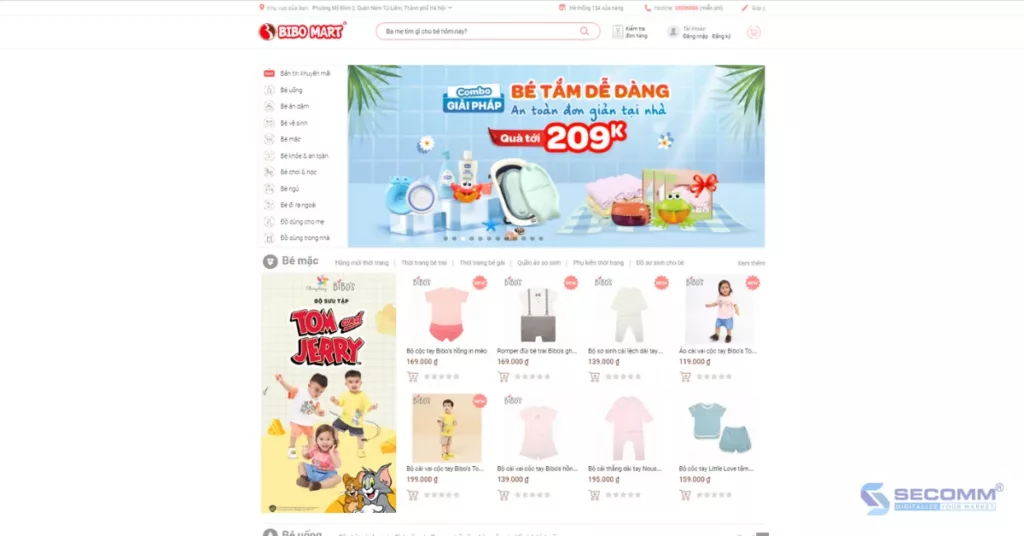
Shop Trẻ Thơ stands as a well-known brand in the Maternity & Baby sector. The company is dedicated to establishing and advancing its eCommerce website alongside its network of 22 physical stores. This strategic move is aimed at staying in sync with the online shopping trend and securing a competitive edge in the realm of eCommerce.
Beyond a diverse product catalog, Shop Trẻ Thơ offers various enticing incentives to encourage online shopping, such as Buy 1 Get 1, cost-saving combos, gifts with purchase, discounts for new customers, and more. Currently, the website maintains a stable traffic of over 100,000 visitors per month.
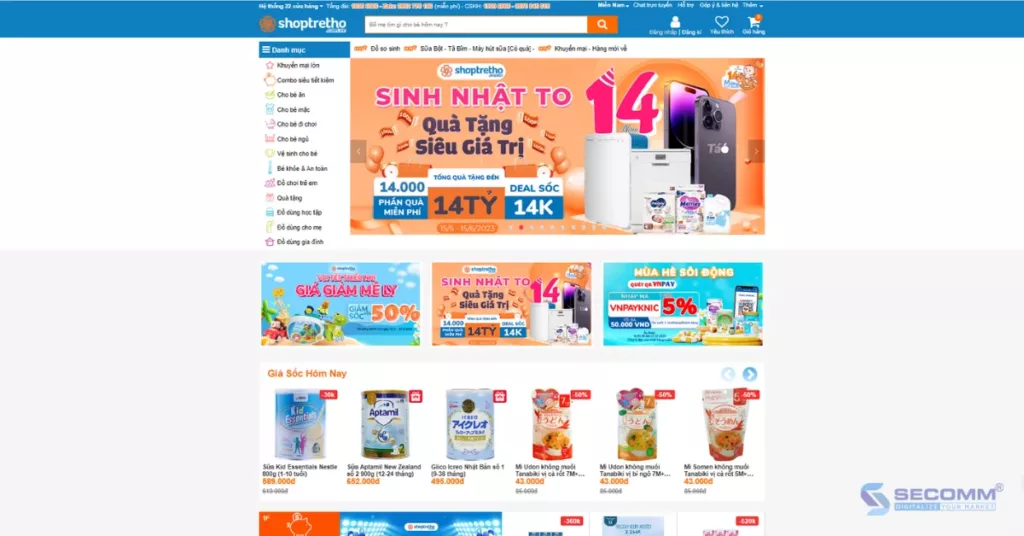
Tuticare is considered a prominent brand in the Maternity & Baby industry with a chain of 55 stores across Vietnam. Tuticare’s products undergo stringent checks, from their origins to their quality, providing a sense of assurance to mothers during their shopping experience.
The company has started an eCommerce website to provide customers with an optimized online shopping experience, along with various attractive programs and offers like a Tuti Gift Card, a subscription for diapers and milk, and more. Additionally, Tuticare offers diverse payment options, including eWallets and buy now pay later.
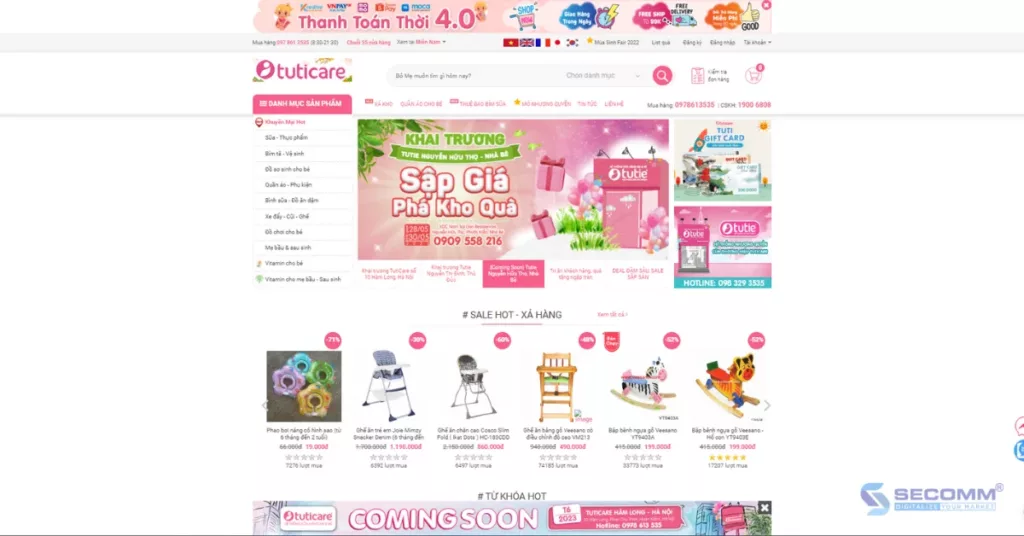
Mothercare, a brand focused on Baby products from the United Kingdom, offers a diverse range of fashion and essential items for expectant mothers and children of various age groups. Despite its recent inception, Mothercare has rapidly garnered attention, primarily due to its commitment to providing high-quality products at affordable prices.
The Mothercare website is strategically developed using the Magento platform, effectively catering to the online shopping preferences of their customers. Beyond attractive promotional programs, the Mothercare website also provides valuable insights on caring for newborns and young children through its dedicated blog section.

Soc & Brothers is a rising name in the Baby eCommerce market, offering a diverse range of products for expectant mothers and children, including clothing, formula, diapers, strollers, and toys. The company has built an eCommerce website using Haravan and receives approximately 28,000 monthly visitors. Moreover, Soc & Brothers has implemented a Loyalty Program with three tiers: Silver, Gold, and Diamond, which can be utilized for purchases and point accumulation both at their offline retail stores and various online channels.
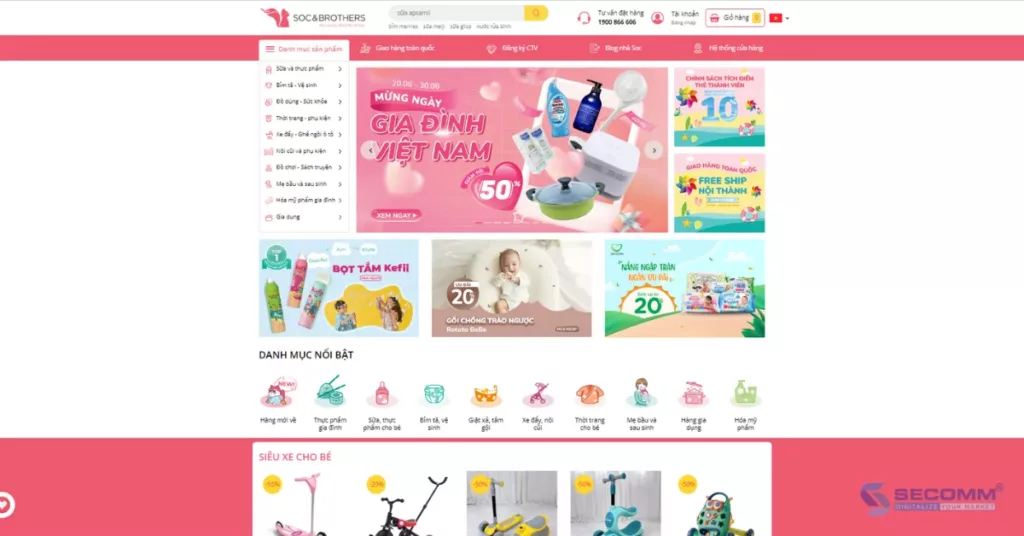
Carter’s is a well-known children’s clothing brand in the North American region. Carter’s offers a wide range of products suitable for children of all ages, heights, and weights. Their website is built on Salesforce Commerce Cloud and features a primary color scheme of blue and white, emphasizing minimalism and cuteness. Currently, the website receives about 8.4 million monthly visits. Moreover, customers can purchase physical or eGift cards through the website, which can be customized in terms of design, value, and personal messages.
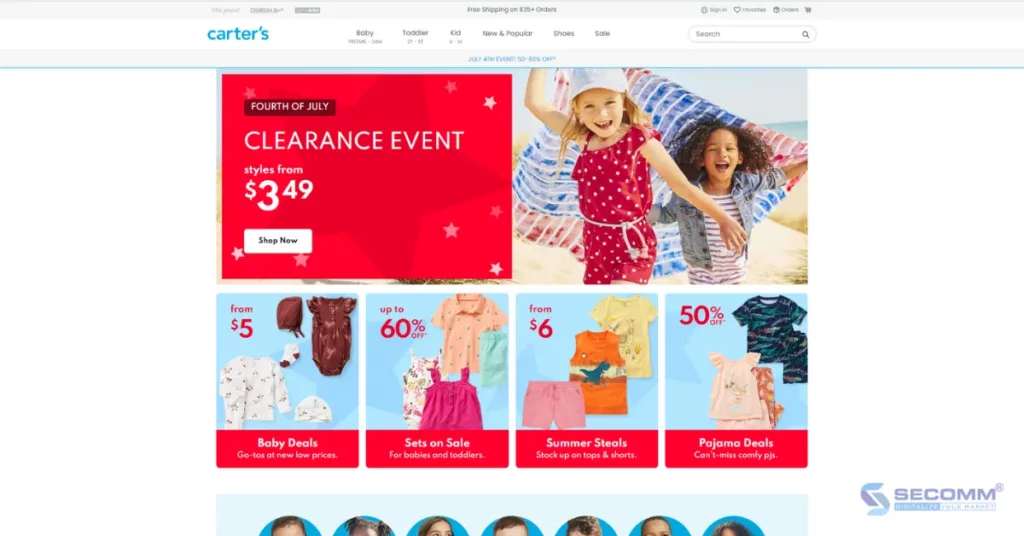
Hanna Andersson is a well-known Swedish brand that specializes in children’s clothing, offering beautiful designs and a wide range of styles, sizes, and types of clothing, from everyday wear to sleepwear and swimwear. Hanna Andersson’s eCommerce website is built and developed using the Salesforce Commerce Cloud platform and garners more than 1.4 million monthly visitors. Hanna provides a personalized shopping experience by inviting its customers to participate in clothing selection consultations, parenting advice, and direct communication for new customers.
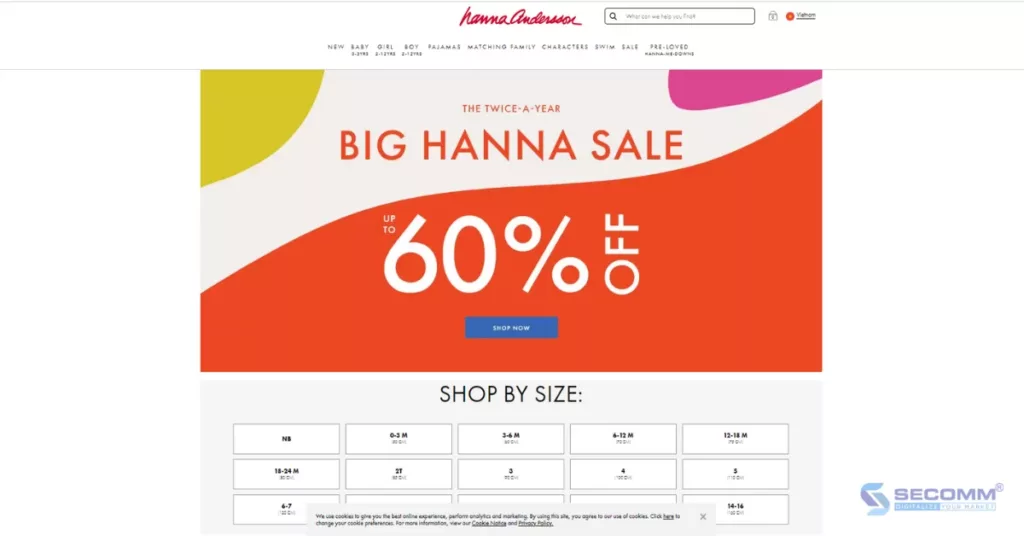
OshKosh, a globally beloved children’s clothing brand, has achieved significant success by utilizing Salesforce Commerce Cloud to create an eCommerce website that delivers an exceptional online shopping experience. Presently, the website receives more than 900,000 monthly visitors and provides numerous appealing shopping incentives to its customers, including a rewards program that offers unexpected gifts, birthday presents, and discount vouchers.
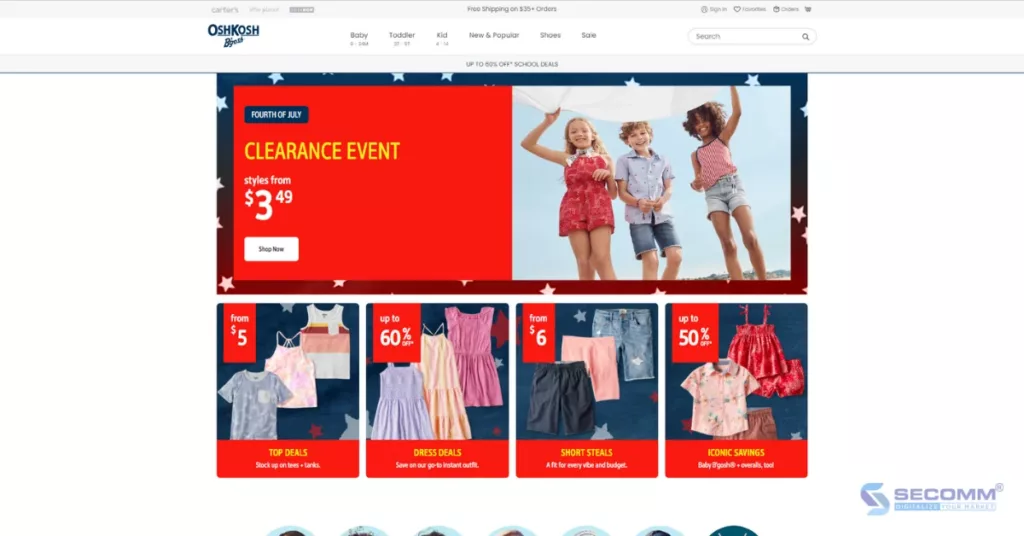
Janie and Jack, another children’s fashion brand, has built an eCommerce website using the Salesforce Commerce Cloud platform. The company provides a wide variety of products for boys, girls, infants, as well as items such as jewelry and home decor. Notably, Janie and Jack has entered into a collaboration with Disney to offer fashion items featuring beloved Disney characters for children.
Additionally, the brand offers a gift-wrapping service that allows customers to select their preferred products, gift boxes, wrapping paper, and greeting cards. Customers can choose to wrap gifts themselves or take advantage of Janie and Jack’s professional gift-wrapping service.
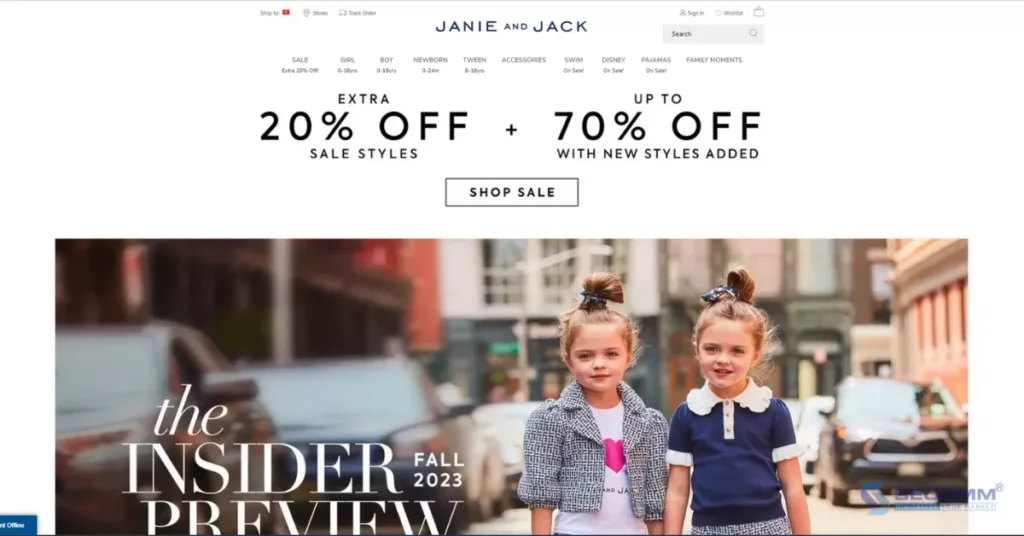
Children Salon, established in 1952, is one of the leading brands in high-end fashion for children. They offer many products, including clothing, shoes, and hats for boys, girls, and teenagers. The company specializes in designing and producing children’s fashion collections for top global brands such as Versace, Givenchy, Burberry, Dolce & Gabbana, Calvin Klein, and more. Additionally, customers who purchase these designer products on the Children Salon website can enjoy discounts of up to 60%.
Children Salon’s eCommerce website is built on the Magento platform, featuring advanced functions like filtering products by size and age, displaying available sizes, and currency conversion for product prices, among others. The website currently receives over 600,000 monthly visits.
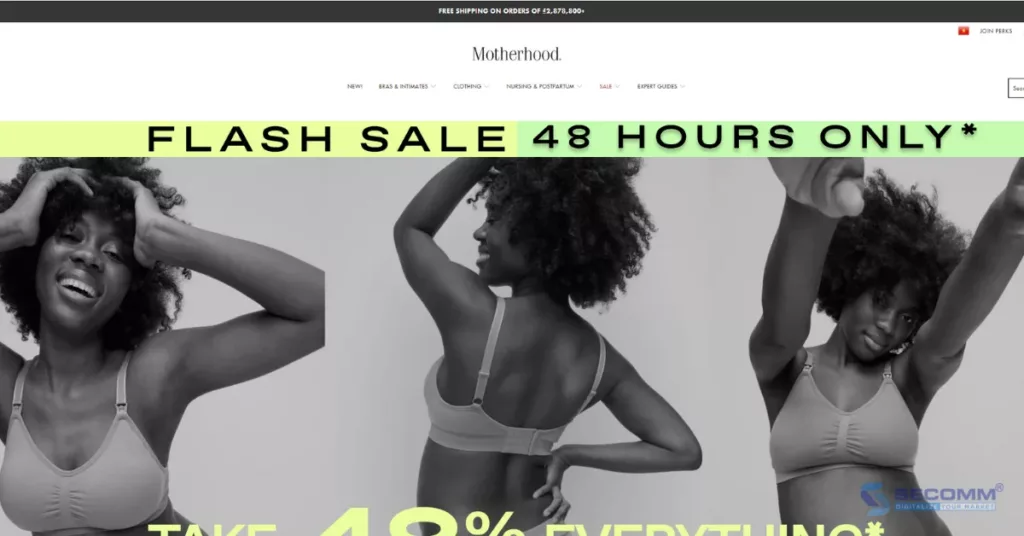
Motherhood Maternity’s eCommerce website is a well-known and trusted fashion shopping destination for expectant mothers. The website, built on the Shopify platform, garners around 400,000 monthly visits.
Beyond its wide array of clothing and supportive accessories, Motherhood offers an “Expert Guide” section dedicated to sharing valuable knowledge about prenatal healthcare. Furthermore, the “Preggie Perks” program allows customers who shop on the website to have the chance to receive discount vouchers or unique gifts, conveniently delivered with their products to their doorstep.

HATCH Collection, a renowned global brand, specializes in offering fashion and beauty products for expectant mothers. Despite its establishment in 2011, the brand has chosen to maintain only two physical stores in California and New York, as HATCH’s primary focus lies in online retail.
Operating through its eCommerce website, HATCH has introduced several programs for their customers. One notable initiative is “NIKKI’s List,” wherein customers respond to specific questions, enabling HATCH to generate personalized product recommendations. The HATCH website is constructed and managed using the Shopify platform and receives approximately 223,000 monthly visits.
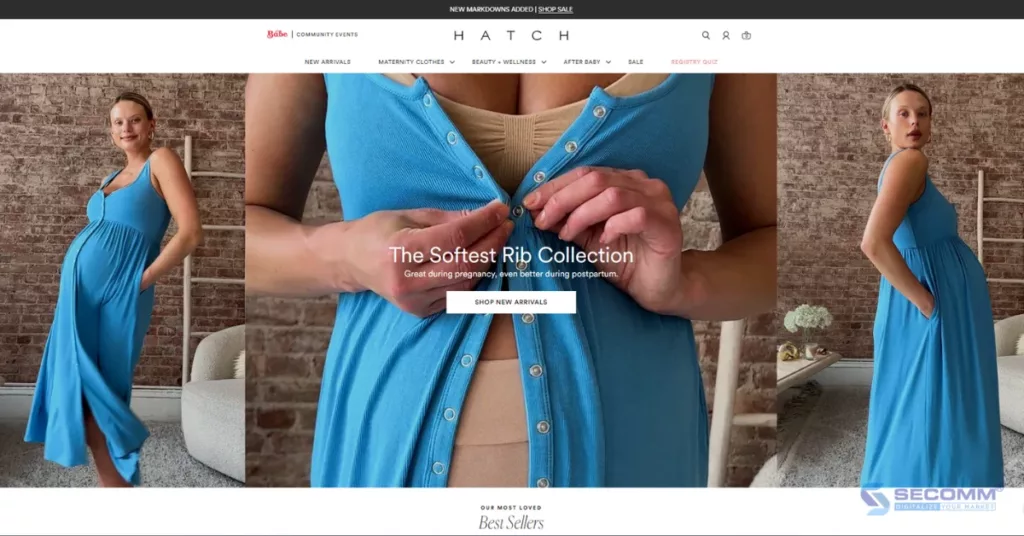
The surge of the Covid-19 pandemic has made a significant impact on consumer shopping habits, particularly in the Baby sector, where a profound shift from offline to online shopping has been witnessed.
Presented here are 15 eCommerce websites, showcasing leading brands in the Mother & Baby industry, both in Vietnam and internationally. These brands exemplify their adaptability in capturing consumer trends and their commitment to enhancing technological infrastructure to compete for a share in the billion-dollar market.
With a track record of successfully implementing eCommerce solutions for a diverse clientele across various countries in recent years, SECOMM specializes in offering expert consultation and tailored eCommerce deployment solutions, tailored to the specific requirements of each industry.
For a free consultation, contact us or call directly to the SECOMM hotline at (02871089908).
 2
2
 13,922
13,922
 0
0
 2
2
PIM is an essential management system that helps synchronize product information across various systems like ERP, POS, CRM, SCM, etc., and a brand’s global sales channels. It’s considered the powerful ‘right hand’ of large corporations for comprehensive information management.
PIM or Product Information Management is a system or platform used to collect, organize and manage detailed product information for businesses. PIM includes information such as product descriptions, images, prices, product attributes, customer ratings and reviews.
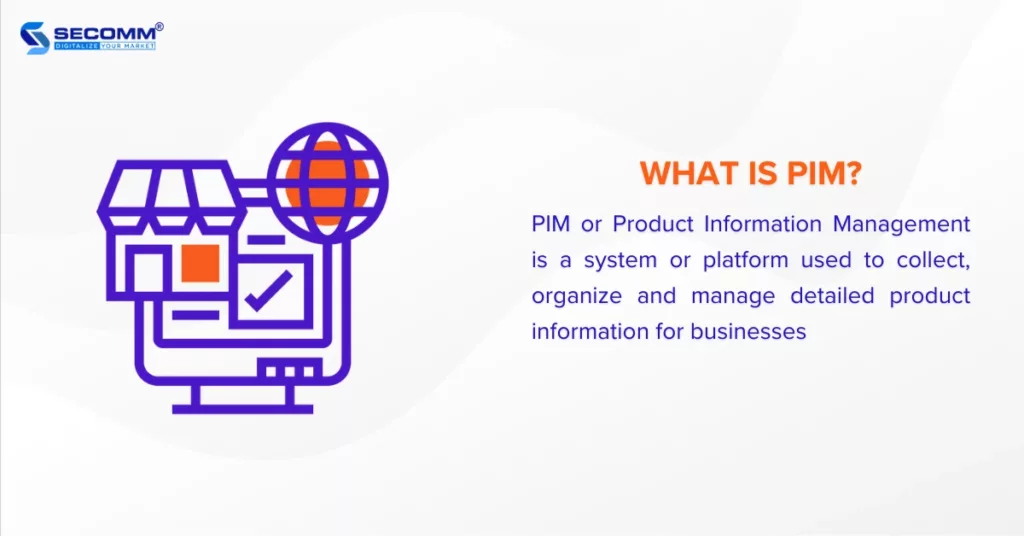
PIM systems often integrate data from ERP, CRM, POS, and other business management systems related to a company’s products. Once integrated, shared data.
Related article: What is POS? Why your eCommerce business need it?
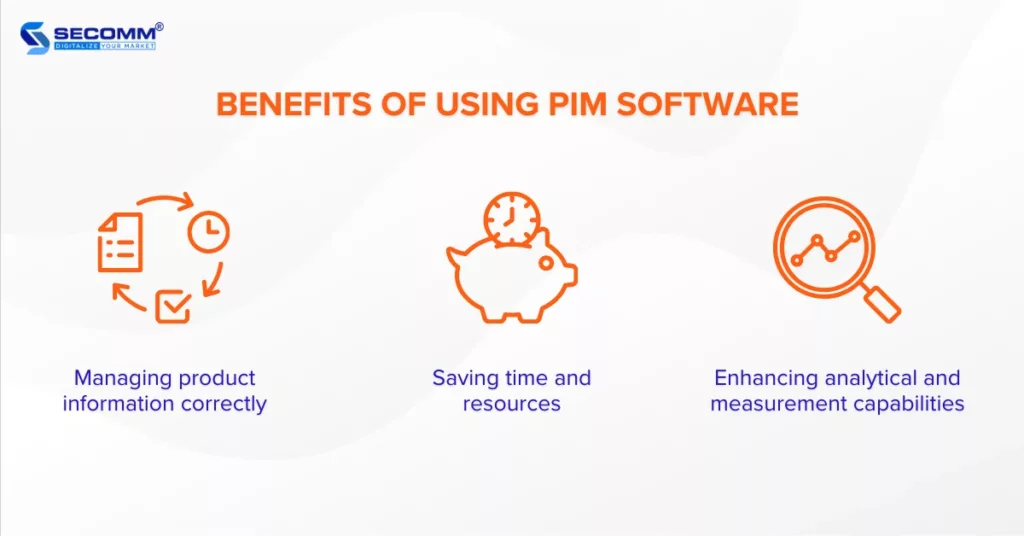
PIM software allows businesses to accurately and consistently collect, organize, and manage product information. This ensures that product information is updated correctly and comprehensively across all sales channels, from eCommerce websites, mobile apps, and social media to marketplaces like Shopee, Lazada, Tiki, Sendo, Amazon, and more. When accurate product information is provided to customers, businesses can enhance trust and reputation for their brand.
A PIM system automates the processes of data entry, processing, and product information distribution. This saves time and effort for employees while reducing the risk of errors compared to manual data entry. With more efficient workflows in place, PIM allows employees to focus on other, more critical tasks.
PIM software enables efficient analysis and measurement of product information. By monitoring, evaluation, and data analysis of product details, businesses can gain insights into the performance of marketing campaigns, consumer trends, customer behaviors, and more. Therefore, this empowers them to make more informed and effective business decisions for the future.
Akeneo is a widely embraced PIM platform known for its broad range of services, including open-source PIM and cloud-based PIM systems, etc.
Currently, Akeneo offers three primary PIM solution packages:

Pros:
Cons:
1WorldSync is a company that specializes in providing solutions for managing product information and synchronizing product data for large enterprises. Their platform is built on a global network for product data synchronization, connecting suppliers, retailers, distributors, and various stakeholders worldwide.
1WorldSync currently offers four customizable solutions tailored to the needs of large enterprises:

Pros:
Cons:
Sales Layer is a PIM platform tailored for efficient product data management across medium and large businesses on a global scale. This PIM solution is designed with customization in mind, and its pricing varies depending on specific business needs, with a starting cost of $1,000 per month.
Sales Layer currently offers several solution packages, including:
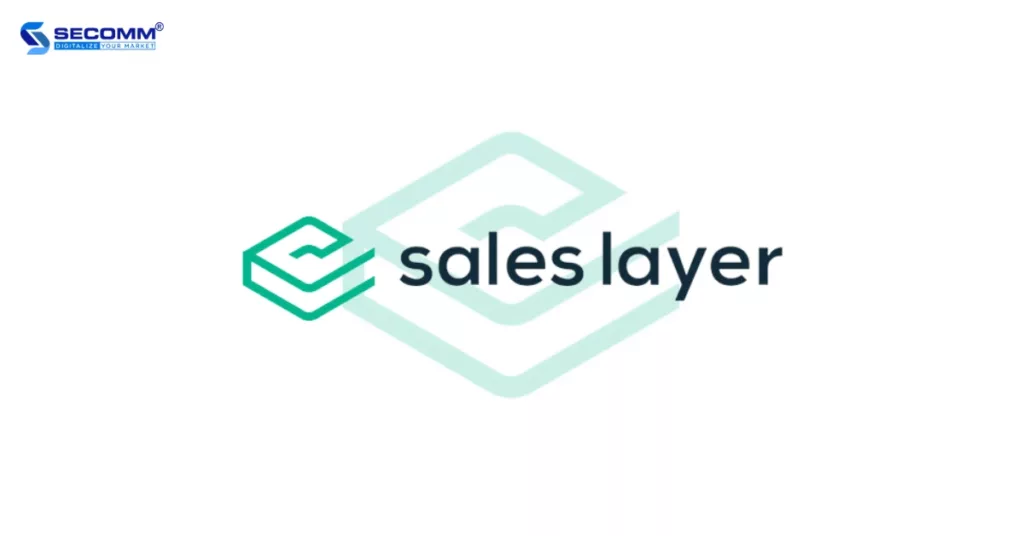
Pros:
Cons:
Salsify is a cloud-based product information management (PIM) platform that offers businesses a solution to efficiently manage and distribute product information across various sales channels. Salsify functions as a software a service (SaaS) application, with usage costs tailored to each business, typically ranging from $2,000 to $5,000 per month.
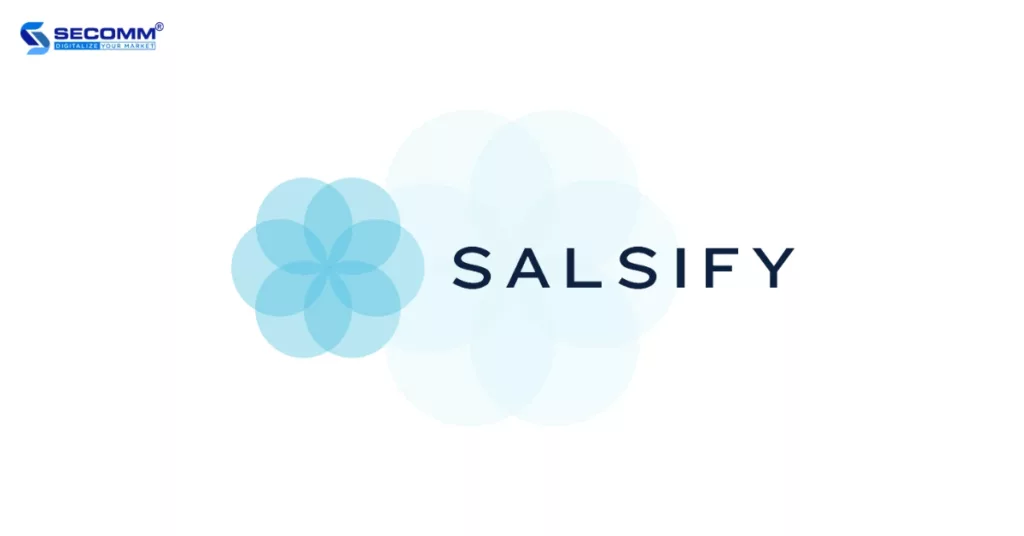
Pros:
Cons:
inRiver is a PIM system developed to efficiently manage and distribute product information across various sales channels and different eCommerce platforms such as Adobe Commerce, Shopify, WooCommerce, BigCommerce, etc. The cost of using inRiver is approximately $1,000 per month.
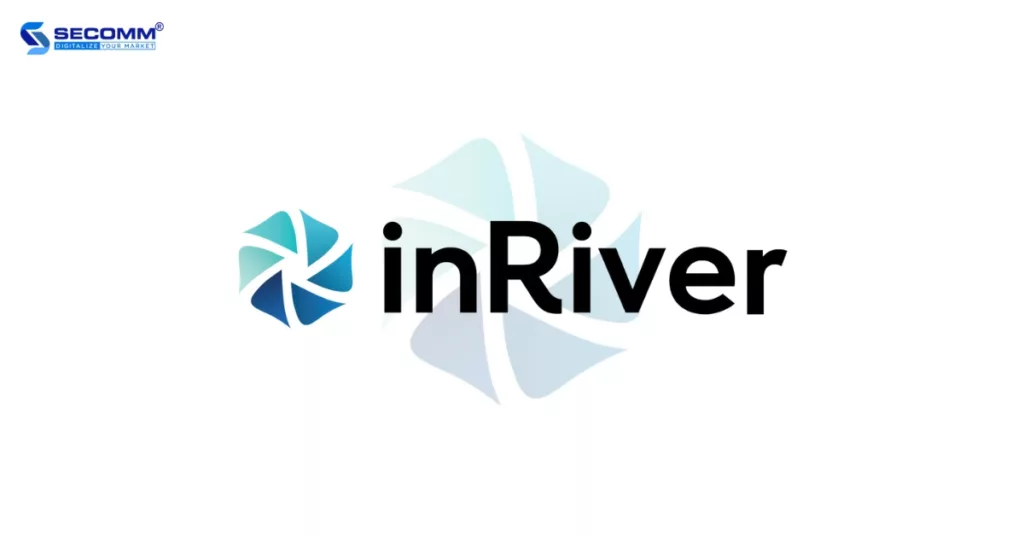
Pros:
Cons:
Above is a summary of the top 5 PIM software options tailored for large-scale businesses, each with its own unique set of advantages and disadvantages. Depending on the requirements for PIM system development and budget considerations, companies can explore and select the most appropriate PIM solution.
Get in touch with SECOMM for more information!
 2
2
 18,820
18,820
 0
0
 1
1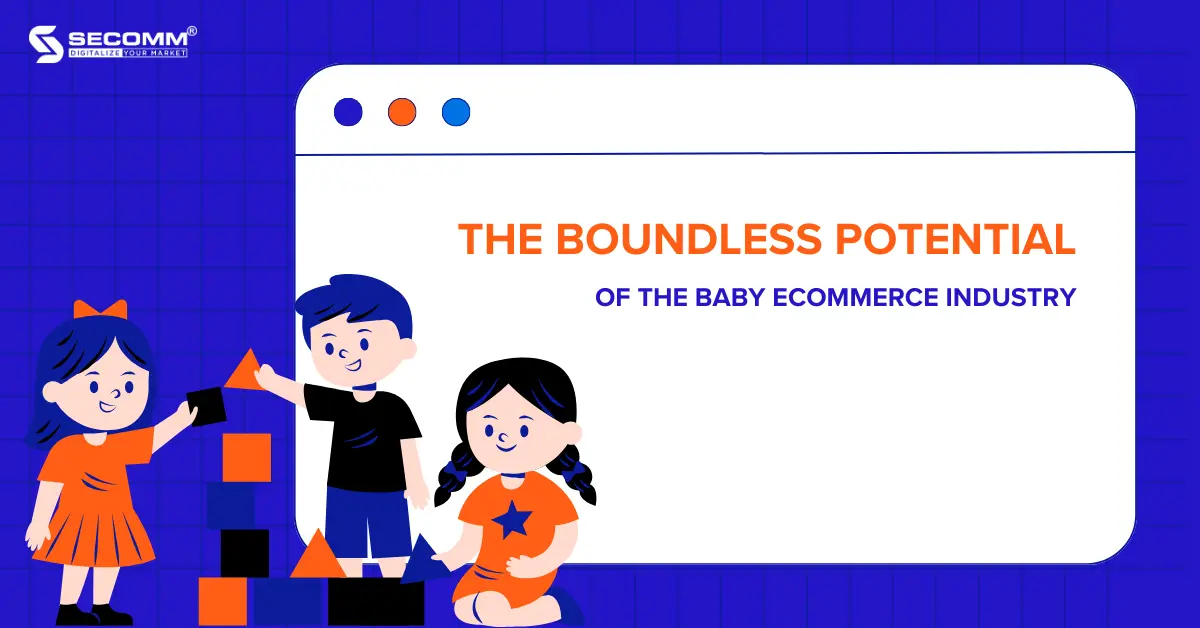
Recent statistics indicate that Vietnam has a population of 24.7 million children and roughly 24.2 million women of childbearing age. Moreover, with an annual birth rate of approximately 1.5 million children, Vietnam stands out as a prospective market for the baby industry. As a result, it comes as no surprise that many baby brands have been progressively establishing and expanding their stores year by year. Additionally, the industry benefits from the momentum created by the pandemic and the evolving trend of transitioning from offline to online shopping.
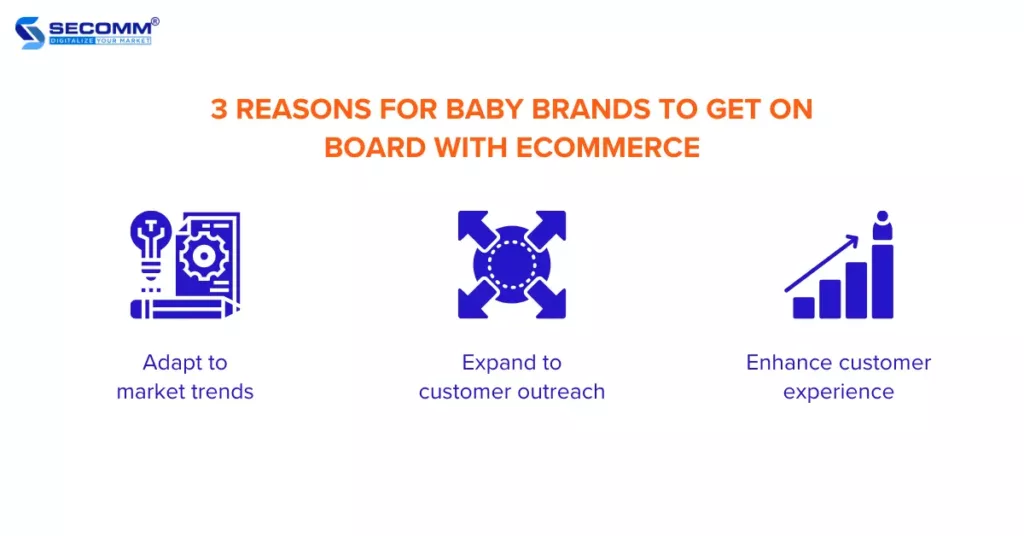
While offline businesses experienced a downturn during the period of social distancing, leading to the contraction of many retail chains, online commerce has been flourishing. Even as society progresses towards a “reopening” phase in the post-pandemic world, the preference for online shopping remains strong. The demand for various products, spanning from timepieces, cosmetics, and groceries, to mom-and-baby essentials, on eCommerce websites and marketplaces continues to steadily surge.
Hence, the solution for Baby enterprises to align with market trends involves the implementation of an O2O (Online to Offline) model. This approach integrates offline sales (leveraging existing physical store networks) with online channels. Among these channels, establishing an eCommerce website is paramount for businesses to promptly deploy sales and marketing strategies, attracting customers and preventing potential loss to competitors.
When physical stores are constrained by location, staffing, and operating hours, online stores remain open and accessible from anywhere worldwide. This offers Baby businesses the opportunity to extend their reach to a large pool of potential customers on the Internet.
By implementing effective strategies like optimizing SEO, running advertising campaigns, or leveraging social media, Baby businesses can swiftly boost their brand recognition, attract a diverse clientele to their eCommerce website, and facilitate round-the-clock product sales.
Launched in 2011, the Con Cung retail chain quickly gained recognition and became the top choice for many Vietnamese families to shop for mom-and-baby products, offering a catalog of over 2000 items. In 2016, with the investments received, Con Cung significantly expanded its store chain from 100 in 2016 to 400 in 2020 (currently at 700 stores).
Recognizing the evolving consumer landscape with a shift from offline to online shopping, the brand proactively intensified its online retail efforts through its eCommerce website and mobile app, enriching the shopping experience for its customers. With this in mind, Con Cung has set an ambitious target of reaching 1 billion USD in revenue by 2023 and aims to capture a 30% market share, envisioning a 2 billion USD in revenue by 2025, with at least 30% coming from eCommerce.
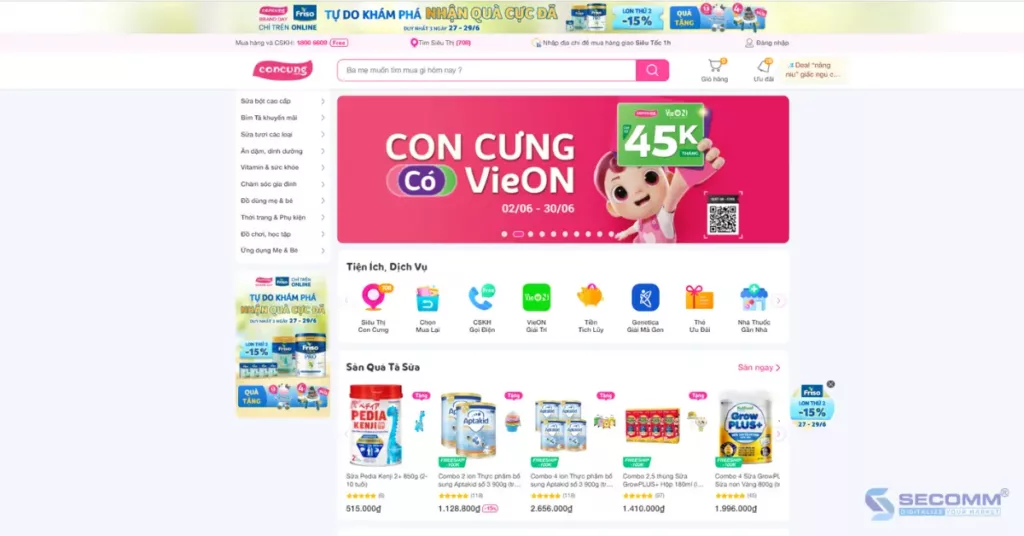
Therefore, in recent times, Con Cung has made an effort to attract customers to its eCommerce website. They consistently promote various enticing programs, including “Monday Freeship Day” and the “Stuffed Animal Fiesta for 99K.”
Additionally, Con Cung has kept pace with the Mobile Commerce trend by introducing the ‘Con Cung’ mobile app, available on both App Store and Google Play. This app has garnered highly positive user feedback and currently ranks 24th in the Shopping category.
Particularly, this retailer’s delivery service has earned high praise from customers. With a network of over 700 stores across the country. Con Cung offers lighting-fast 1-hour delivery through its “Pink Warrior” delivery team. Beyond partnering with third-party delivery providers such as Grab Expres, Giao Hang Nhanh, Giao Hang Tiet Kiem, the brand also maintains a dedicated team of delivery warriors who cater to customer’s specific time preferences.
Established in 2009, Kids Plaza offers more than 10,000 mom-and-baby products, certified safe for babies from top-notch brands in Vietnam and around the world. In the competitive race, Kids Plaza has consistently fortified its position by embracing the O2O business model.
This strategy involves harmoniously blending traditional in-store retail with a variety of online channels, including a dedicated website, eCommerce platforms, Zalo stores, mobile applications, and more. Kids Plaza has rolled out enticing customer loyalty programs such as Kicoin, the convenient Freeship policy covering a 7km radius for all purchasing channels, and exclusive discounts for expectant mothers when shopping in brick-and-mortar stores.
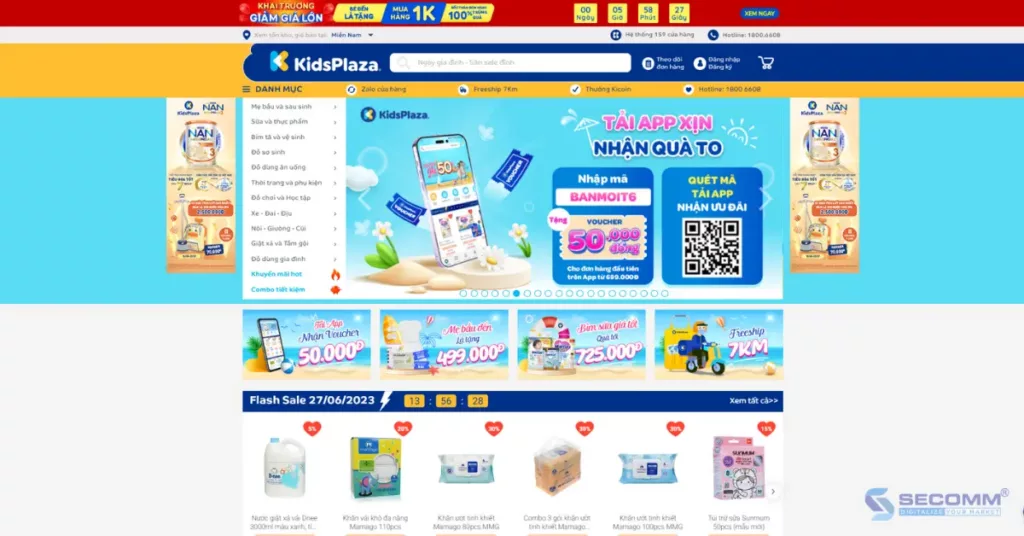
Customers aren’t only satisfied by the seamless shopping experience, affordable prices, and appealing promotional offers but also by exceptional product quality. All products undergo strict quality control before being officially offered for sale to provide the best experience and service, ensuring customers’ peace of mind while shopping.
Kids Plaza also demonstrates its care for expectant moms and babies through programs like the free antenatal classes, which have been conducted for over a decade and have successfully aided numerous mothers during their childbirth journeys. Moreover, the brand hosts annual community events and maintains an insightful knowledge-sharing blog to help elevate health awareness among both mothers and children.
The mom-and-baby retail chain, Bibo Mart, was established in 2006 and specializes in offering a wide range of products for mothers and babies, including maternity clothing, diapers, formula, and strollers. Similar to Con Cung and Kids Plaza, Bibo Mart hasn’t lagged behind in the eCommerce race. After years of operation and growth, Bibo Mart has identified a new vision for investing in an eCommerce system to meet the online shopping needs of its customers.
Currently, online sales at Bibo Mart account for 14.5% of the total revenue and are expected to increase to over 30% in the next five years. Beyond frequently offering attractive incentives to encourage customers to shop on their website and app, Bibo Mart has introduced a loyalty program with four tiers: Loyal, Silver, Gold, and Diamond. Customers are assigned membership ranks based on their specified spending levels and earn BiXu points for continued exclusive benefits.
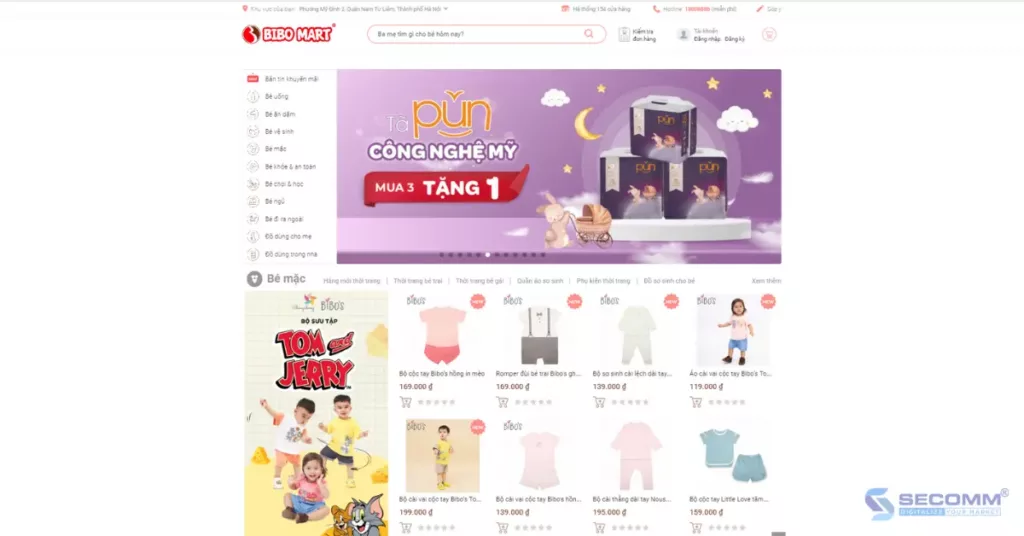
Notably, customers can use a QR code on the app to scan for product info or accumulate points when shopping in physical stores. Bibo Mart also demonstrates its commitment to its customers by providing maternal and childcare knowledge through blogs and free online seminars and classes for mothers as well as those caring for their health during pregnancy and postpartum.
The potential of the Baby eCommerce market in Vietnam is enormous, and the success of major players like Con Cung, Kids Plaza, and Bibo Mart has encouraged the participation of other businesses. However, for a Baby eCommerce business to succeed, it’s important to build a comprehensive and feasible strategy, both short-term and long-term. Particularly, eCommerce websites and mobile apps are the two crucial keys that determine the success or failure of a business in the eCommerce race.
Having partnered with many businesses in implementing eCommerce websites and apps over the years, SECOMM has accumulated practical experience to assist businesses in swift and effective deployment.
Feel free to contact us or call SECOMM’s hotline at (02871089908) for a free consultation.
 2
2
 16,051
16,051
 0
0
 1
1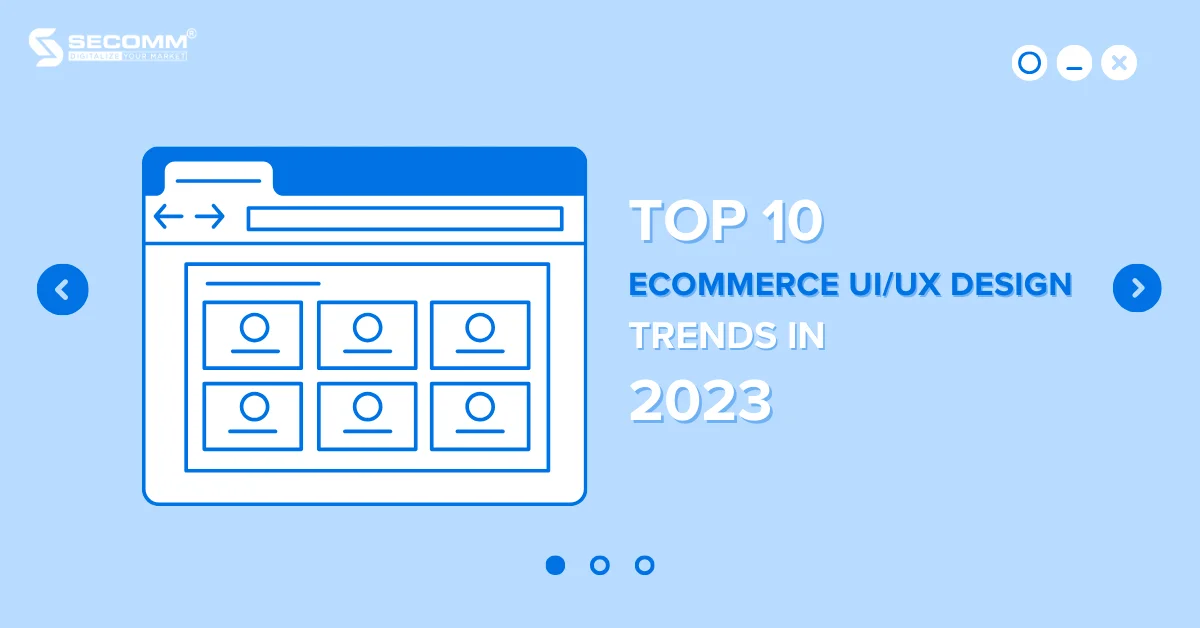
As new UI/UX design trends emerge, designers must stay up-to-date to create the most engaging and user-friendly interfaces for businesses. UI/UX design plays a vital role in crafting excellent user experiences and improving online business efficiency.
In this article, SECOMM will discuss the latest UI/UX design trends for the year 2024 and beyond
User Interface (UI) and User Experience (UX) are often regarded as two interrelated aspects when it comes to designing interfaces for any online product or service, especially in the case of eCommerce websites.
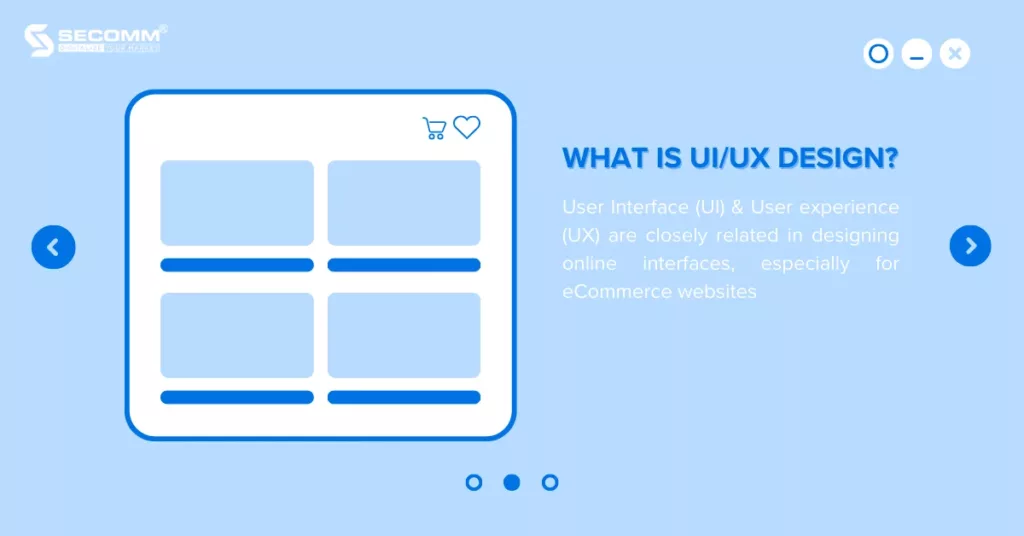
UI design encompasses the creation of various elements like call-to-action buttons, navigation bars, charts, and images, all based on choices of colors, layouts, fonts, and more, to craft an intuitive, appealing, and visually engaging user interface. In design, UI serves as a means to convey messages from businesses and brands to their users.
On the other hand, User Experience (UX) involves the process of shaping the overall experience for users during their interaction with a product or service. This encompasses meeting user requirements for ease of use and functionality, strategizing and structuring information, designing interaction workflows, and assessing effectiveness through research on user habits and behaviors within eCommerce websites.
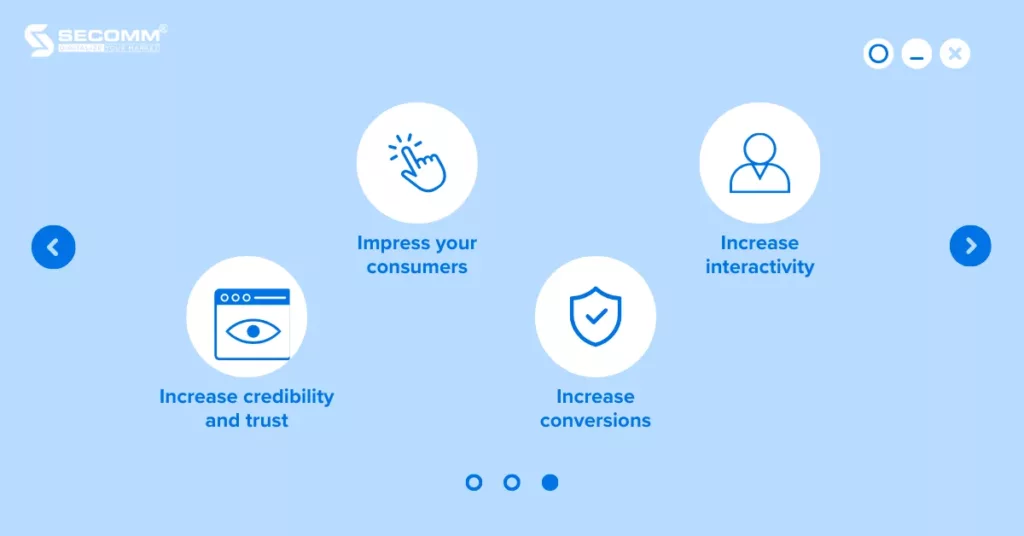
Expertly crafted UI/UX design can leave a lasting impact on users when they visit your eCommerce website. In the highly competitive eCommerce landscape, a remarkable UI/UX design can set your business apart and create a distinctive identity among market rivals.
Effective UI/UX design can help you enhance your interaction capabilities with consumers. For example, creating social media sharing buttons, user reviews, and intuitive search tools can streamline the customer’s journey to products and more.
A professional UI/UX design helps you establish trust with customers and cultivate a positive brand image. By offering clear security information, SSL certificates, and secure payment procedures, you can instill confidence in customers while mitigating the risks of personal data breaches and financial fraud.
Starting with an investment in UI/UX design helps convert potential customers into actual customers. Through data analysis and user feedback, businesses can gain a deeper understanding of customer behavior and make interface adjustments to improve the user experience and overall business performance.
Related article: The 10 biggest eCommerce trends set to dominate in 2023
Although the Dark Mode design trend isn’t new to website developers, it continues to be popular in 2023. The option to switch between light and dark modes offers users more flexibility when visiting an eCommerce website. Dark Mode enhances the browsing experience, especially for users who spend extended hours in front of screens. Furthermore, it can contribute to saving battery life on mobile devices or screens equipped with OLED displays.
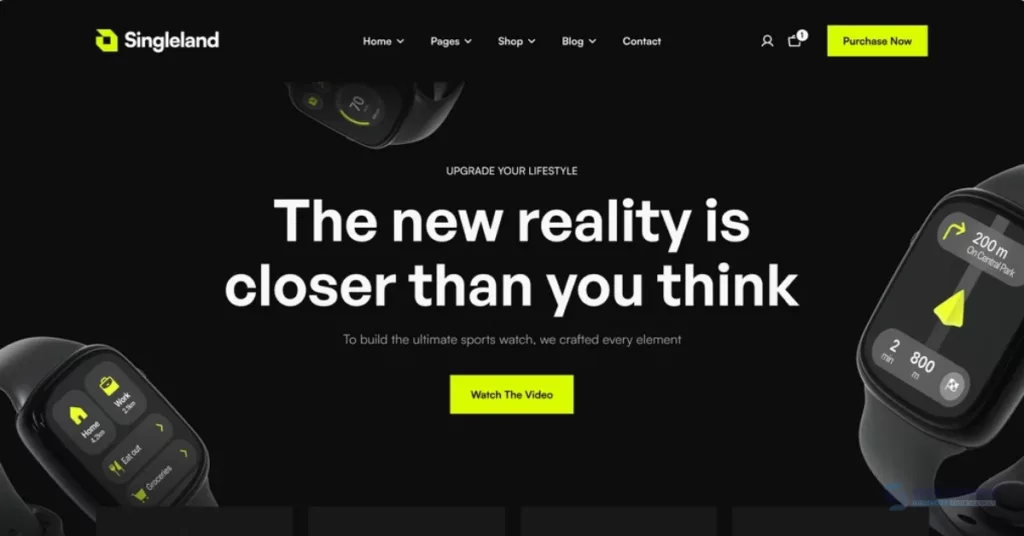
The 3D design trend is gaining more popularity in UI/UX design. 3D elements bring depth and realism to website interfaces, making them visually appealing and improving user interaction. UI/UX designers frequently utilize 3D elements for website components like CTA buttons, icons, banners, and backgrounds, or employ 3D animations for feedback and transition effects, creating a more engaging user experience that fosters a visual connection with users.
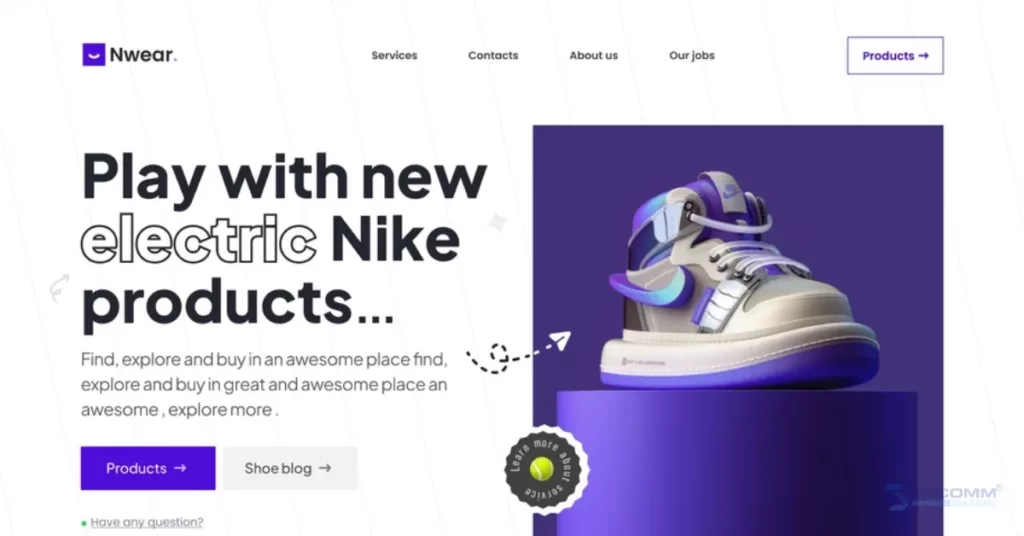
Neumorphism is a design trend that blends aspects of both skeuomorphism and flat design. It creates a 3D effect by using shadow and highlight effects to achieve a sleek, modern look for websites. However, UI/UX designers must be cautious not to overuse neumorphism, as it can result in a cluttered, confusing interface or create effects contrary to what a business intends to convey.
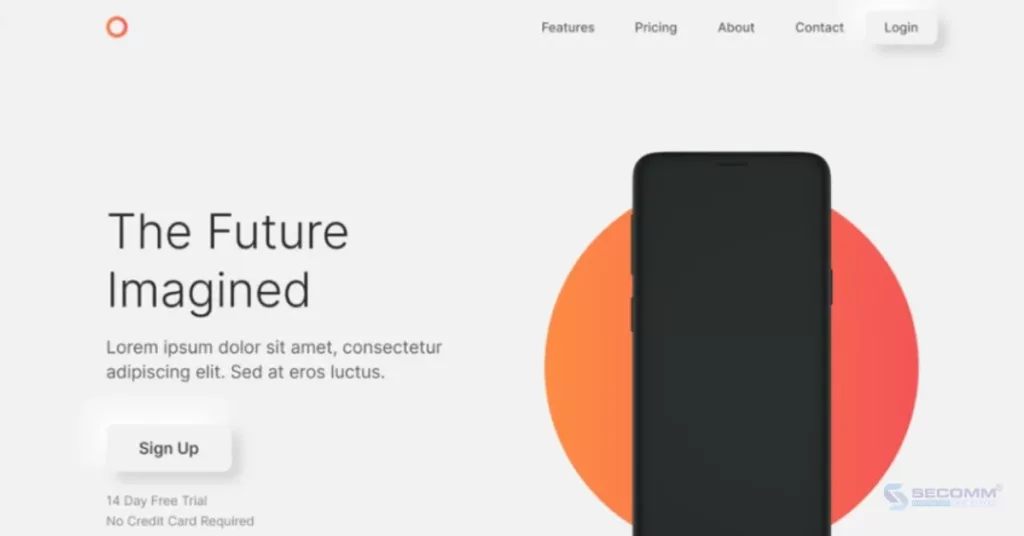
Modern Minimalism represents a UI/UX design trend that centers on crafting straightforward, user-friendly interfaces by removing extraneous elements and highlighting vital content. This style combines simplicity with modernity, providing users with a refined and user-friendly experience. The main challenge in implementing Modern Minimalism is finding the balance between simplicity and aesthetics, ensuring that the design remains both visually appealing and easy for users to navigate.

Dynamic Gradient is a design trend that produces color gradient effects that adapt according to user interactions or the time of day. It can offer users a more personalized and sophisticated experience. However, when implementing Dynamic Gradient in UI/UX design, it’s crucial for designers to strike a balance so that color intensity doesn’t become overpowering and doesn’t compromise readability.
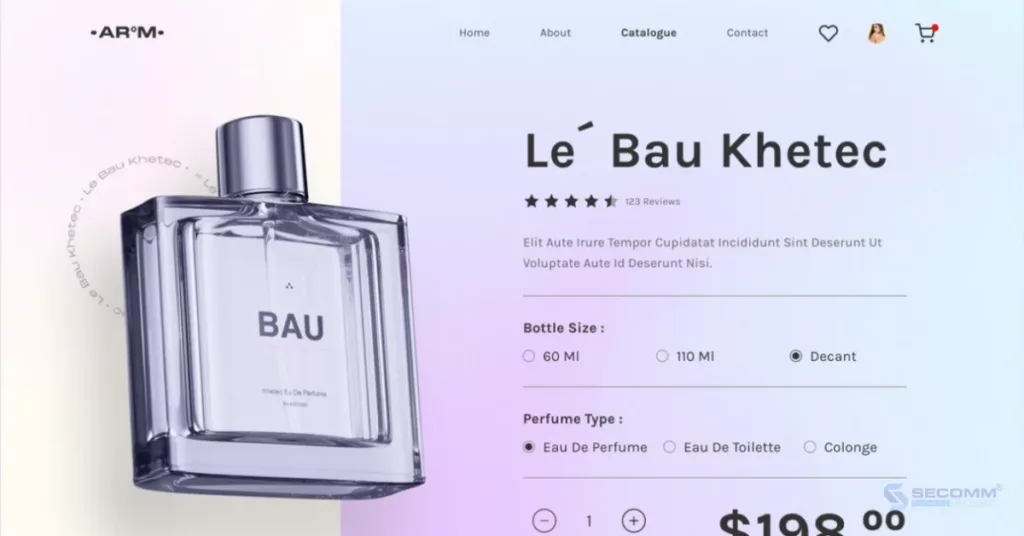
Voice Interface represents a UI/UX design trend where users can interact with an eCommerce website system using voice commands rather than traditional input methods such as keyboards, mice, or touchscreens. Voice Interface employs voice recognition technology to comprehend and respond to user commands, requests, or queries. In UI/UX design, Voice Interface introduces a fresh and user-friendly mode of interaction, thereby unlocking a plethora of opportunities for tailoring the user experience and delivering personalized services.

Micro-interactions are a design style that incorporates small elements, including subtle animations, specific sound effects, image responses to user actions or voice commands, and more, to create an engaging experience and enhance interaction on a website. Micro-interactions can also help guide users through the website interface effortlessly. When applying Micro-interactions, UI/UX designers need to ensure they won’t distract or annoy users.

Augmented reality (AR) is becoming increasingly popular in the UI/UX design community, especially in eCommerce websites related to technology, interior design, cosmetics, gaming, and more. AR allows users to interact with products/services as if they were in the real world, bridging the gap between online and offline shopping. However, due to its advanced technology, AR can sometimes pose challenges for older or less tech-savvy customers. Therefore, when designing the UI/UX, businesses must ensure that AR elements are intuitive and user-friendly.
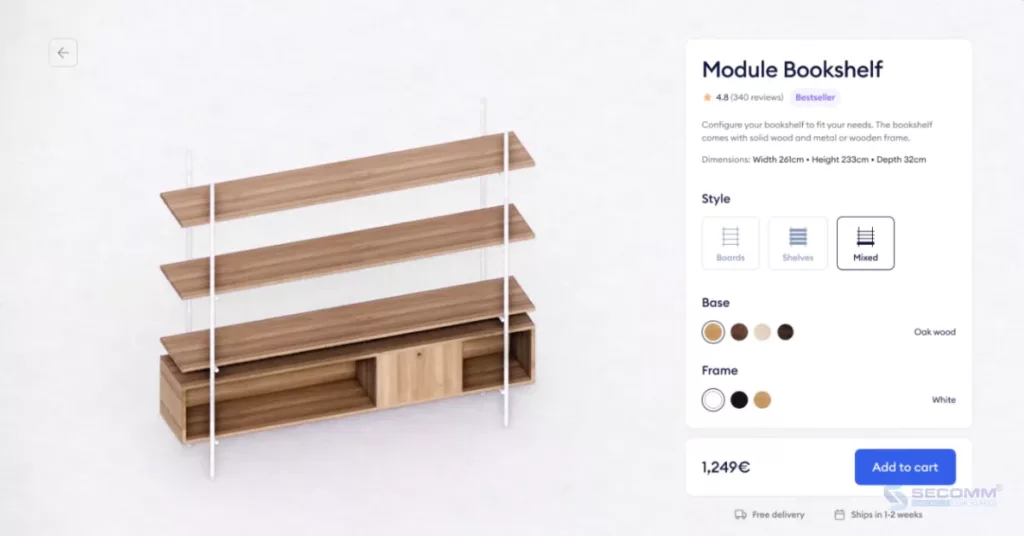
Asymmetric Layouts is a UI/UX design trend where elements and components aren’t arranged in the traditional symmetrical structure. Instead, elements are placed asymmetrically and inconsistently, creating a sense of balance and noticeable uniqueness in the design.
The strength of Asymmetric Layouts lies in their ability to capture users’ attention and create a distinctive experience through images and emphasis on essential content. However, when using Asymmetric Layouts, it’s essential to consider ensuring that the eCommerce website interface remains user-friendly, easy to navigate and maintains its aesthetic appeal.
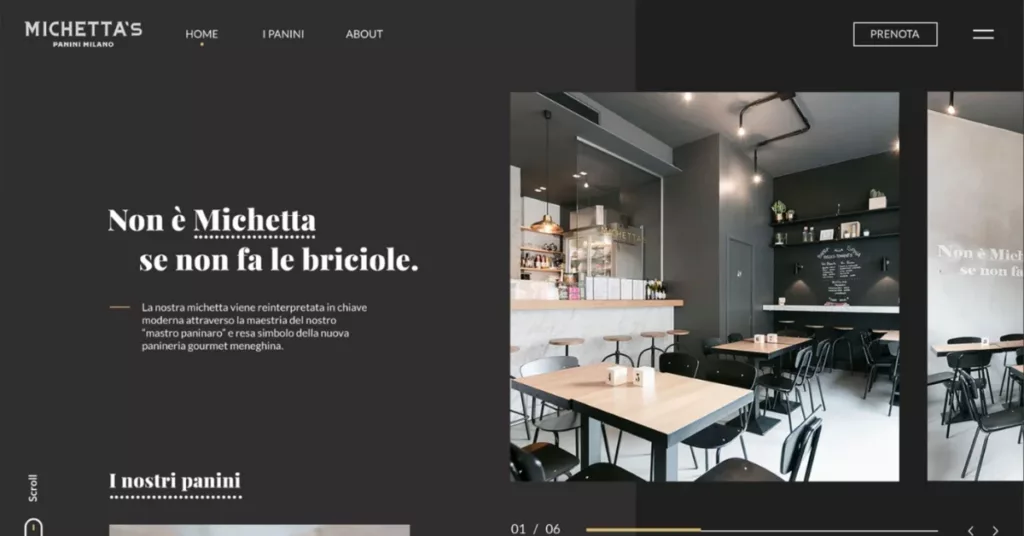
Data Visualization is a design trend that involves presenting complex data in a clear and visual manner using graphs, charts, and images. In UI/UX design, Data Visualization is used to transform intricate information into engaging visuals, simplifying data comprehension and interaction for users.
Therefore, when incorporating Data Visualization into UI/UX design, it’s essential to carefully choose appropriate data representation methods, utilize colors and graphical elements effectively, and ensure information is conveyed clearly and attractively.
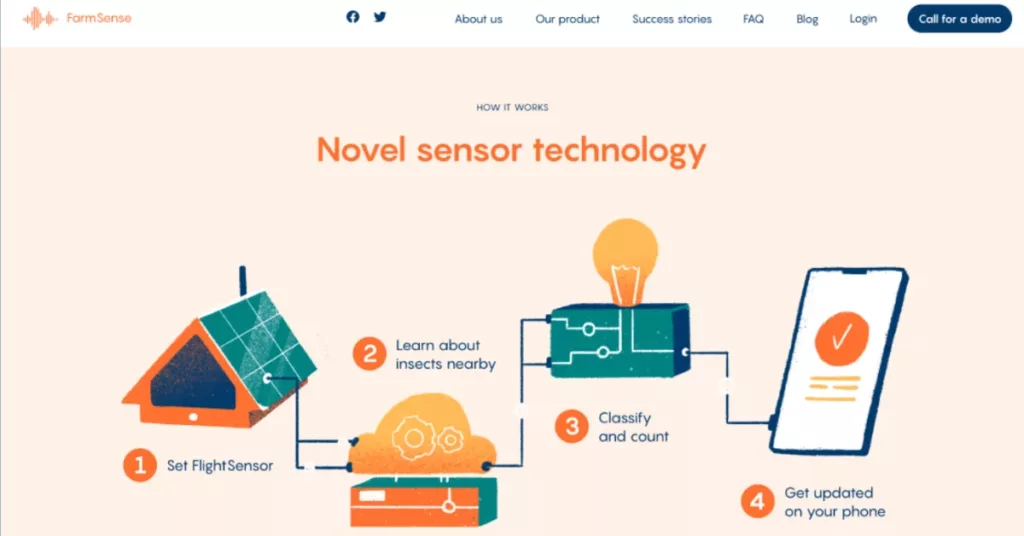
Those are the top 10 UI/UX design trends for eCommerce website in 2023. We hope that the valuable information in this blog will help you choose your best-fit style that conveys your brand’s essence.
Contact us now or call directly to the SECOMM hotline at (028) 7108 9908 for eCommerce consulting and implementation.
 2
2
 12,557
12,557
 0
0
 1
1
In the cloud infrastructure service market, there are many large enterprises, but the first name that comes to mind for large enterprises is AWS.
AWS (Amazon Web Services) is a cloud solution developed by the “giant” Amazon, trusted by millions of businesses, including fast-growing startups, colossal corporations and top-tier government agencies.
At present, AWS provides a comprehensive array of over 200 fully-featured services, accessible from data centers scattered across the globe. These services encompass blockchain, cloud computing, DevOps, storage, backup, recovery, and more.

According to estimates published by the Synergy Research Group, Amazon’s market share surged to 32% during the initial quarter of 2023, maintaining its lead in the global cloud infrastructure market and surpassing all other tech titans, including Microsoft Azure, Google Cloud, Alibaba Cloud, IBM Cloud, Salesforce, Oracle, and Tencent Cloud
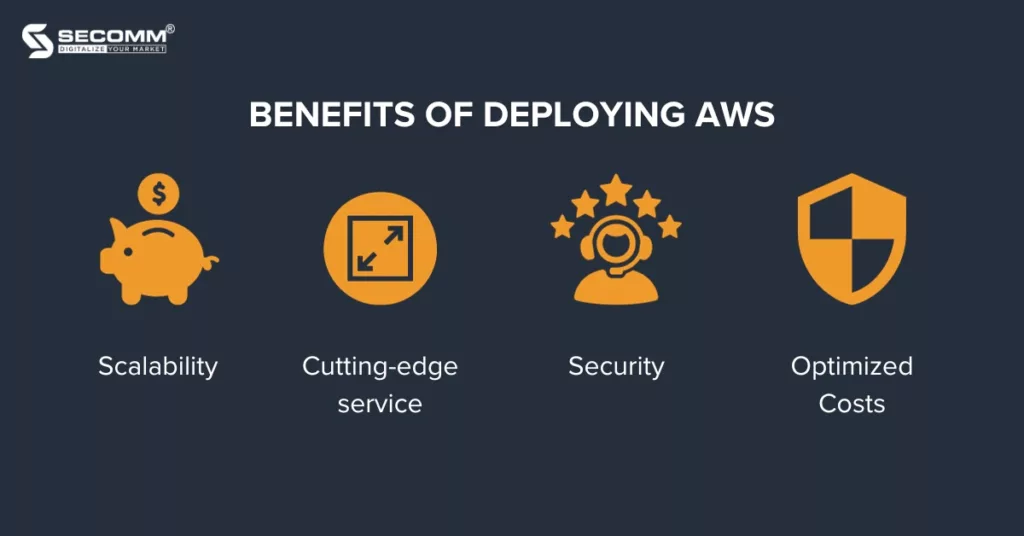
AWS provides flexible scalability, enabling businesses to adjust resources according to their needs, whether it involves scaling up to handle high traffic or accommodating growth, all without the need for investments in physical infrastructure.
Moreover, AWS offers effortless integration with various services and technologies through APIs and management tools. This allows AWS to seamlessly integrate its applications with third-party services and incorporate new technologies into the existing system.
With AWS, businesses can leverage cutting-edge technologies to experiment and innovate more swiftly. Since its inception, AWS has consistently introduced novel technologies that businesses can utilize for their digital transformation.
For example:
Back in 2014, AWS led the way in serverless computing with the introduction of AWS Lambda, enabling developers to execute code without the need to provision or manage servers.
In 2017, AWS launched Amazon SageMaker, a managed machine learning service that empowers both developers and data scientists, regardless of their prior experience.
AWS employs an end-to-end approach to secure and fortify its infrastructure, encompassing physical systems, operational systems, and software. AWS adheres to international security standards, offering compliance checks for rules and regulations such as:
Furthermore, AWS extends support to various other security standards and compliance certifications such as CSA, ISO 27017, ISO 27018, SOC 1, SOC 2, SOC 3, and more.
AWS employs a pay-as-you-go payment model, allowing businesses to use resources as needed without overspending their budgets.
Furthermore, AWS has earned the trust of many large enterprises due to its optimized costs. For instance, when businesses commit to using an AWS service or a bundle of services up to a specific monetary threshold (measured in USD per hour) over a 1 or 3-year duration, AWS offers more cost-effective solutions than the On-Demand pricing.
Furthermore, businesses can receive volume-based discounts based on the amount of services and resources they utilize within AWS. For example, in the case of Amazon S3, pricing is tiered, meaning the more a business uses, the less it pays per GB.
AWS offers a range of cloud services, below are some key AWS services:
Amazon EC2 (Amazon Elastic Compute Cloud) is a flexible cloud computing service that provides virtual servers for running applications. It allows businesses to rent and manage virtual machines to meet their specific needs.
Use cases for Amazon EC2:

Amazon Simple Storage Service (S3) is a cloud storage service that enables businesses to easily store and access data with durability and high reliability.
Use cases for Amazon S3:

Amazon Aurora is a high-performance managed relational database service built with compatibility for MySQL and PostgreSQL, outperforming other relational database management systems.
Use cases for Amazon Aurora:
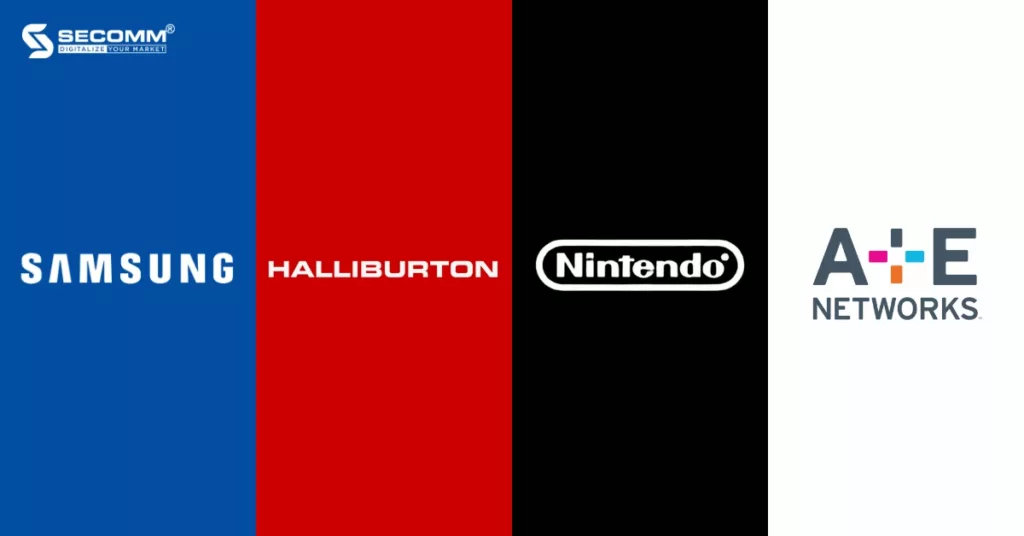
DynamoDB is a NoSQL database designed to handle high scalability and low-latency response time applications. Amazon DynamoDB is fully managed, serverless, and designed to run high-performance applications at any scale.
Additionally, DynamoDB provides integrated security features, continuous backups, automatic multi-region replication, in-memory caching, and data loading and exporting tools.
Use cases for Amazon DynamoDB:
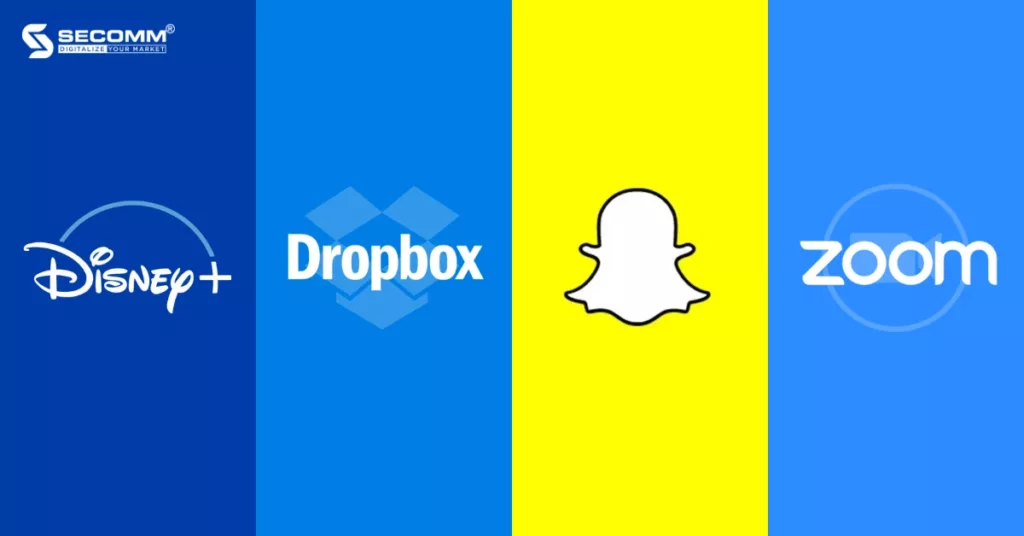
Amazon RDS (Amazon Relational Database Service) is a managed relational database service for MySQL, PostgreSQL, Oracle, SQL Server, and MariaDB, designed to set up, operate, and scale relational databases in the cloud with just a few clicks.
Use cases for Amazon RDS:
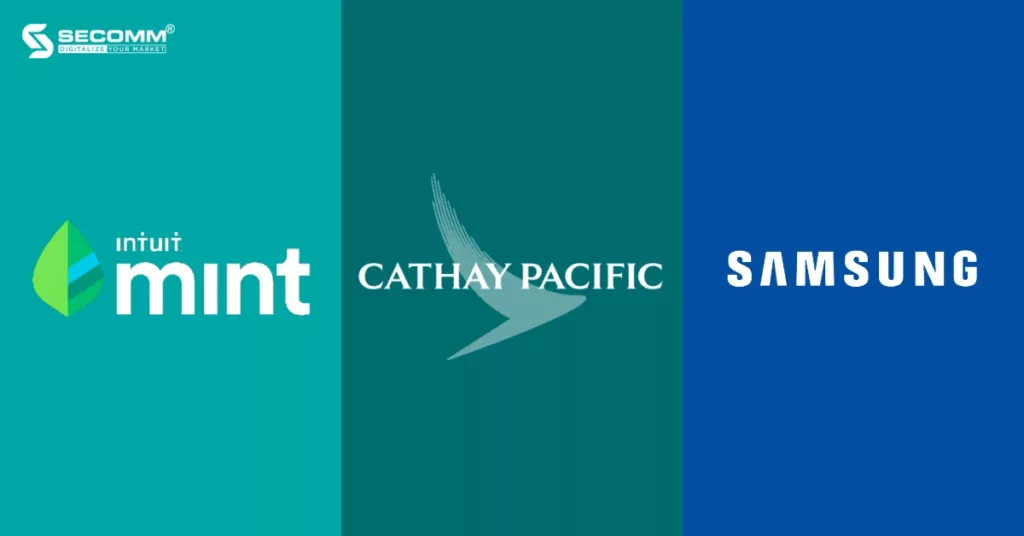
AWS Lambda is a serverless computing service that allows businesses to run code without the need to manage servers. AWS Lambda enables businesses to execute code when events occur, optimizing resource usage and reducing costs.
Use cases for AWS Lambda:

Amazon Virtual Private Cloud (Amazon VPC) allows businesses to define and launch AWS resources in a logically isolated virtual network, providing full control over the virtual network environment, including resource placement, connectivity, and security.
Use cases for Amazon VPC:

Amazon Lightsail is an AWS service designed to simplify the deployment and management of applications and websites in the cloud environment. It offers an easy-to-use virtual private server with pre-configured containers, storage capacity, databases, snapshots, and more, all at an affordable monthly price.
Use cases for Amazon Lightsail:
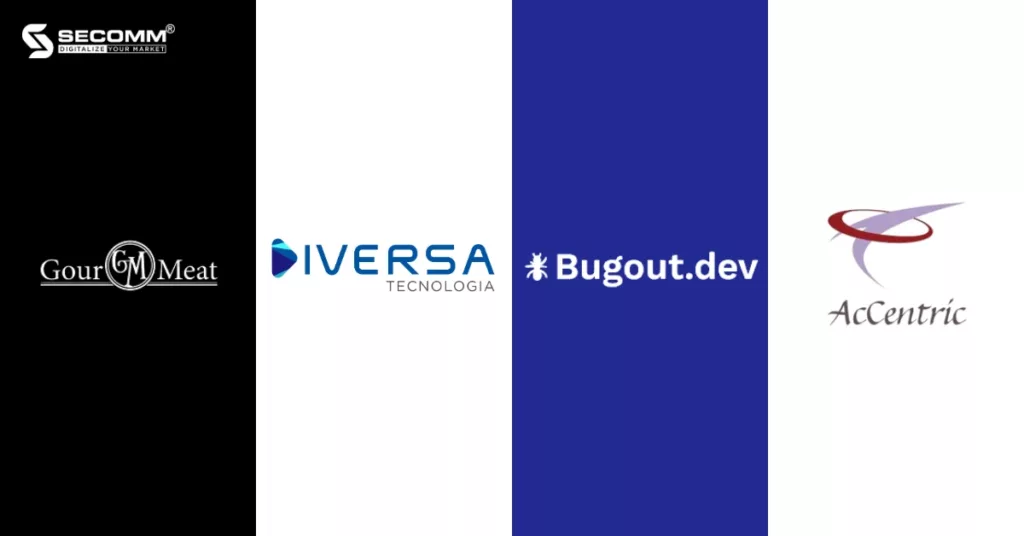
Amazon SageMaker is a service for building, training, and deploying machine learning models for any use case with fully managed infrastructure, tools, and workflows.
The primary application of Amazon SageMaker is the development of practical machine learning applications, including product recommendations, personalization, smart shopping, robots, and voice-enabled devices.

In over 16 years since its establishment to date, AWS has provided cloud services to millions of customers worldwide with a global-scale operational experience. In the near future, AWS may continue to maintain its leading position in this over 60 billion USD market with a market share range of 32-34%.
To learn more about AWS and how to deploy AWS for your business, contact SECOMM or call the Hotline at (02871089908) for a free consultation.
 2
2
 16,833
16,833
 0
0
 1
1
In recent years, BigCommerce has achieved a significant milestone as it emerges as one of the preferred platforms for eCommerce website development among numerous online businesses. According to BuiltWith, there are presently 45,952 operational websites utilizing this platform.
This article will highlight 10 notable eCommerce websites from around the world, spanning various industries, that have adopted BigCommerce for their operations.
Skullcandy opened its first store in 2015 in Park City, Utah, and it remains the company’s exclusive physical retail location in the United States due to its primary online sales strategy. Skullcandy is a technology brand known for crafting headphones and speakers with a youthful and modern style. Their eCommerce website is developed using the BigCommerce platform.
Aside from seasonal promotions, Skullcandy provides customers with diverse payment choices, including PayPal, VISA, MasterCard, and even a Buy Now, Pay Later option through Klarna.

BURROW is an online furniture brand that specializes in offering seasonal furniture and sofas with a minimalist, modern, and vibrant style. The company’s approach revolves around three key principles to deliver unique value to customers. First and foremost, they have built their eCommerce website on the BigCommerce platform, encouraging online shopping through enticing promotions, illustrative product videos, and free shipping. Secondly, their products are known for their custom designs, high durability, multifunctionality, compactness, portability, and versatility to fit into various spaces. Lastly, BURROW places a strong emphasis on building a community that connects customers from all around and enhancing brand awareness.
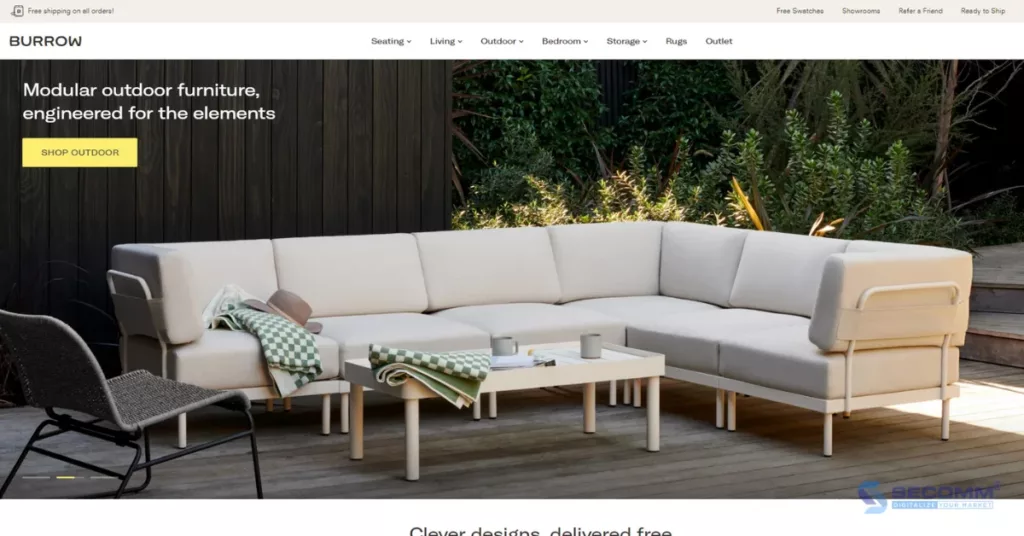
LARQ is renowned for its stylish and compact reusable water bottles, designed with sustainability in mind. These bottles are manufactured using advanced technologies like PureVis and NanoZero to ensure high water quality. LARQ’s bottles possess self-cleaning capabilities, utilizing UV-C LED lights to eliminate up to 99.99% of bacteria.
These exceptional features led to a significant $1 million investment from Shark Tank. LARQ has developed its eCommerce website using BigCommerce, complete with a dedicated Basq Magazine section where they share valuable insights on hydration with their customers.
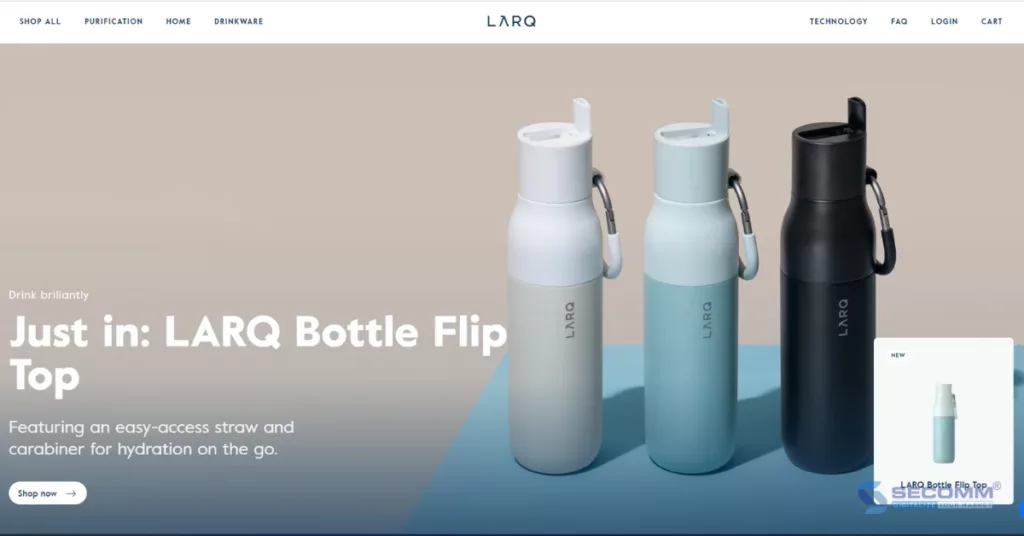
The premium beauty brand, Molton Brown, hailing from the UK, has also used the BigCommerce platform to build their eCommerce website. Their product range, spanning fragrances, hand washes, essential oils, scented candles, and bath & body products, is entirely manufactured in the UK and is cruelty-free. Their product packaging is crafted from high-quality reusable glass, adhering to eco-friendly standards.
At present, the company exclusively offers online shopping services to customers in the US, Japan, and the majority of European regions. Molton Brown consistently introduces seasonal collections, special occasion sets, gender-specific product lines, and personalized gift recommendations, simplifying the shopping experience for their customers.
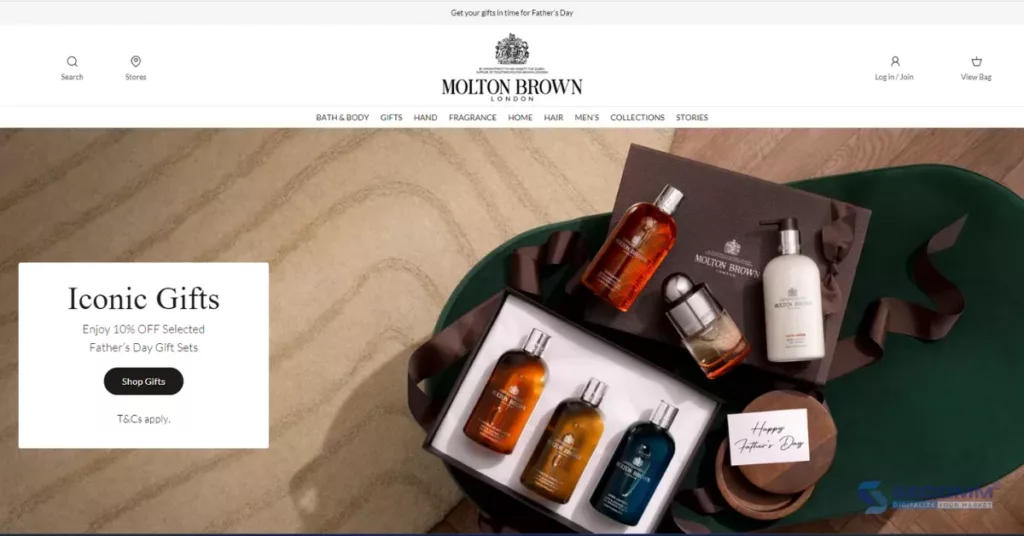
Tommie Copper is a brand that specializes in offering comfortable, lightweight fashion products designed to reduce pain and aid in functional recovery for both men and women. With a strong emphasis on expanding online sales, the company has invested significantly in its eCommerce website using the BigCommerce platform. They have also implemented various customer engagement programs to encourage more shopping. One notable initiative is the Customer Loyalty Program, featuring three tiers: Score, Performance, and Pro-Grade, with detailed and precise instructions on point accrual and redemption.
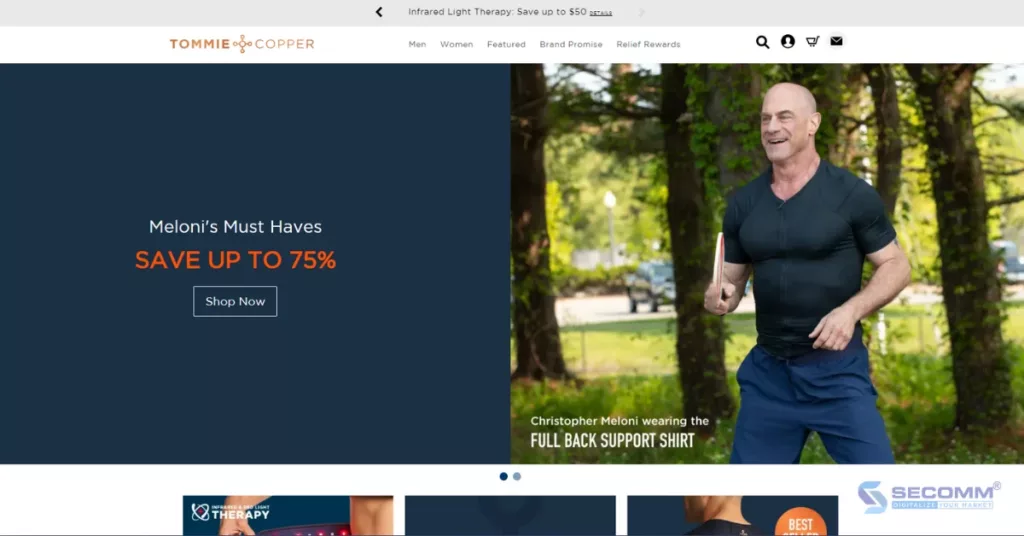
Saddleback Leather is a company specializing in handcrafted leather goods, and they develop their eCommerce website with BigCommerce. Their product range is extensive, encompassing items such as bags, backpacks, belts, and even intricately designed mouse pads. Visitors to their website are greeted with a distinct “Texan” design aesthetic and captivating narratives. Notably, customers can also become part of the Saddleback Club, granting them access to exclusive and appealing member-only offers.
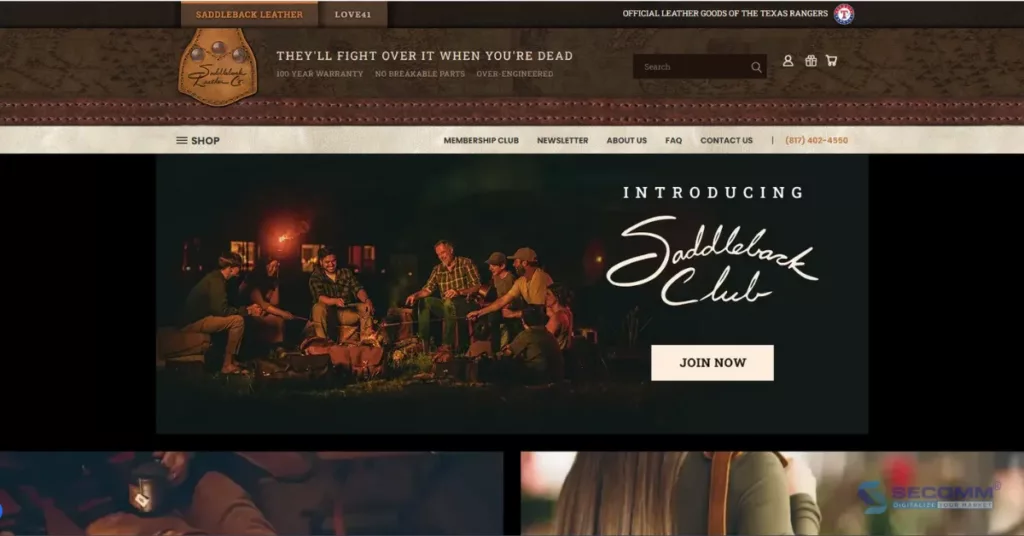
Barron Designs stands as a top-tier brand specializing in the design and provision of premium interior and exterior products crafted from high-quality materials like wood, tiles, and stone. Their diverse product range includes wooden doors, stone fireplaces and chimneys, mailbox posts, engineered wood panels, and more. Barron Designs has developed its eCommerce website using the BigCommerce platform, offering a multitude of features to ensure the best shopping experience for customers.
When customers browse and click on their favorite products to view details, they can choose colors and select options such as fire resistance and UV protection before placing an order. The production and delivery times typically range from 2 to 4 weeks. For those interested in sampling a product, they can simply click on the option, and a complimentary mini-size sample will be sent to their doorstep. Furthermore, a discount coupon will be emailed to encourage customers to make a full-size purchase.
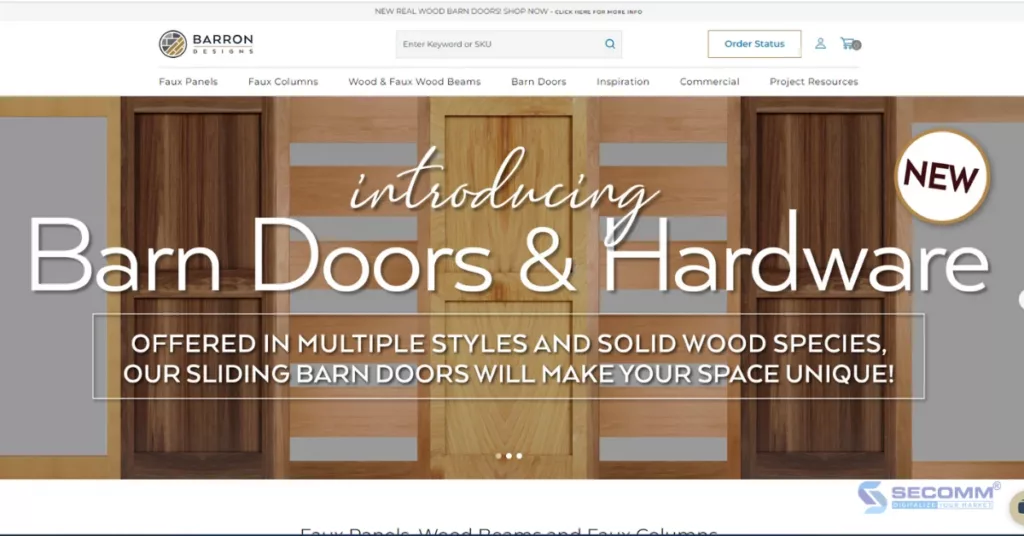
SugarBoo & Co is a well-known BigCommerce eCommerce website that offers a wide range of handmade products for personal and household use. It offers a diverse range of handmade products for both personal and household use, including items like notebooks, decorative pieces, ceramic dishes, baby toys, and more. To provide an excellent online shopping experience, the company offers multiple payment methods, including well-known options like ShopPay and AfterPay.
SugarBoo & Co’s blog section is filled with interesting content, regularly sharing tips on gift selection, the advantages of using ceramic products, home decorating ideas, and more. Plus, during special occasions and holidays, the website provides customers with a selection of discounted shopping suggestions.
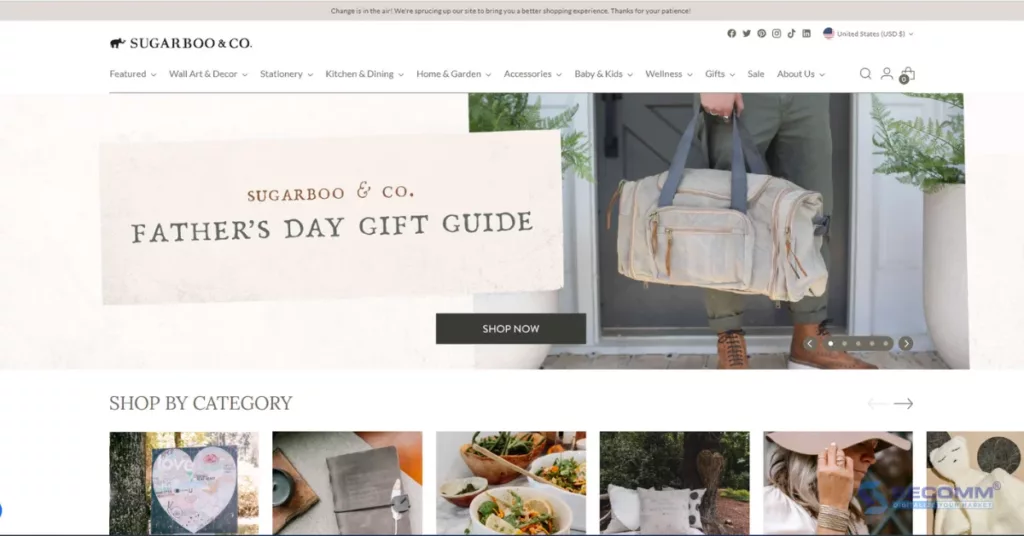
Autograph Foliages is a prominent brand in the United States, specializing in landscaping solutions for both homes and commercial establishments. The company offers a diverse range of collections, including seasonal and holiday-themed foliage like Christmas decorations, catering to the needs of families and businesses. What sets Autograph Foliages apart is its enduring partnerships with major entities such as Walt Disney World, Universal Studio, Warner Bros, and Seaworld Parks & Entertainment, a testament to the superior quality of its foliage products.
Their website, developed on the BigCommerce platform, prominently displays new and seasonal products. To access the pricing details for specific items, customers must register an account on the website. They can also subscribe to receive weekly newsletters containing valuable tips on plant care, decoration, and more.
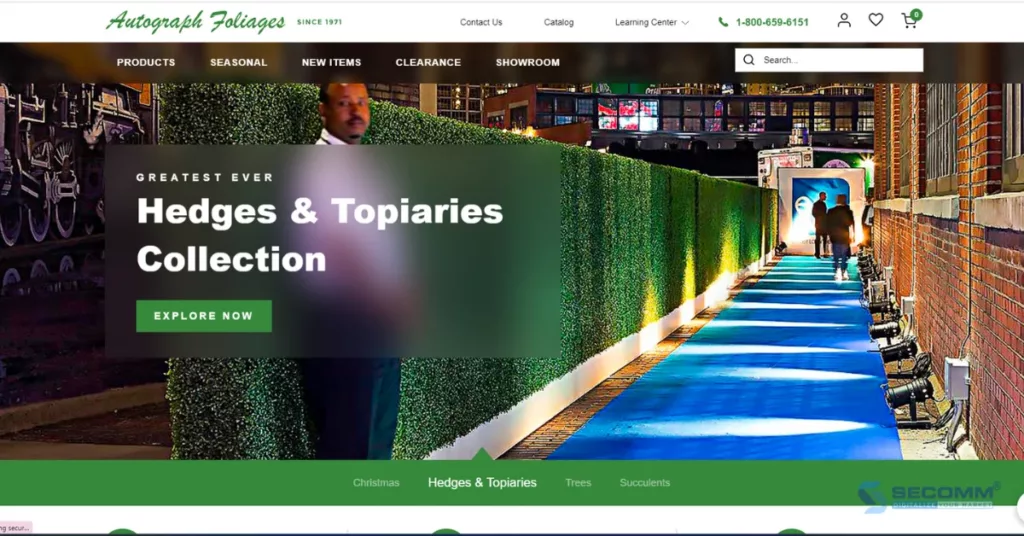
Established in 1999 and officially launched its products in 2000, Body Bliss specializes in a wide range of personal care items. With over two decades of development, the company has continually researched and refined its products to prioritize customer health, using gentle and environmentally friendly ingredients.
Body Bliss’s BigCommerce website follows a minimalist design, featuring well-organized product categories for easy customer navigation. The site also offers appealing incentives such as complimentary gifts and free shipping. Furthermore, the company uses Instagram to engage with customers and it is seamlessly integrated into the website to keep customers updated on the latest updates.
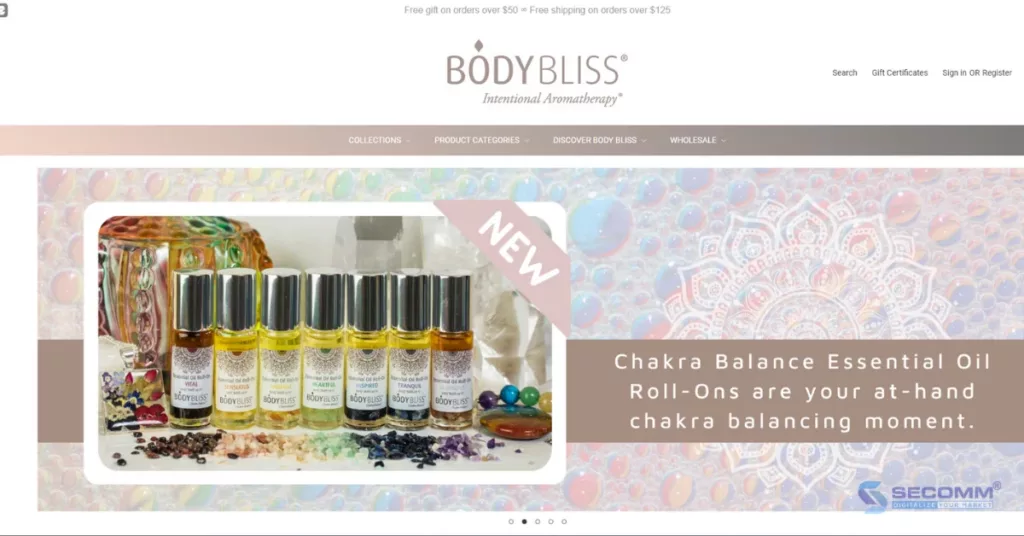
This is SECOMM’s summary and review of 10 eCommerce websites that have achieved success using the BigCommerce platform, effectively capturing customers and leading in their industries.

Related content: BigCommerce 2023: Pricing, Features, Pros and Cons
With a wealth of experience helping clients in various countries deploy eCommerce, SECOMM specializes in providing consulting services with professional eCommerce deployment solutions.
Get in touch with SECOMM or call the hotline at 02871089908 today to receive free support and expert guidance.
 2
2
 5,365
5,365
 0
0
 1
1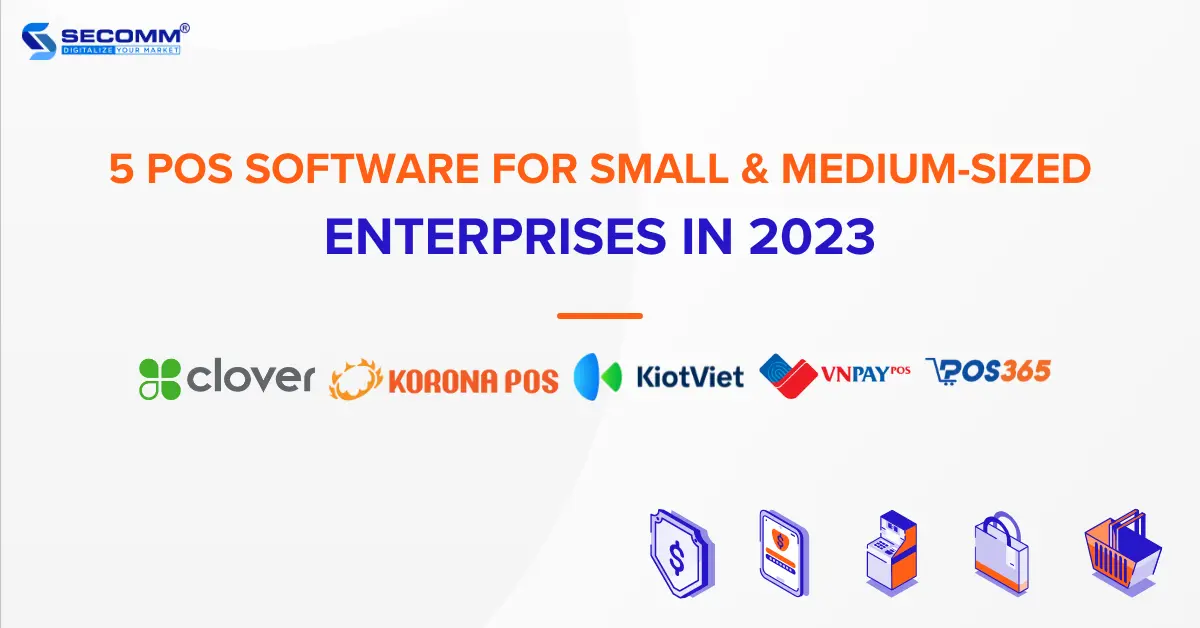
Point of Sale (POS) is a system employed by businesses to handle sales transactions, monitor inventory levels, manage customer relationships, generate revenue reports, and conduct business analysis, among other functions. By implementing POS, businesses, particularly SMEs, gain a comprehensive understanding of their operational activities and streamline their management processes.
In this article, SECOMM will evaluate and compare the five most widely-used POS software solutions among small and medium-sized enterprises, including Clover, KORONA POS, KiotViet, and POS365.
Clover is a POS software developed by Clover Network Inc, aimed at offering an integrated solution for handling sales and payments for both small and medium-sized businesses. Clover provides POS solutions across various industries, including restaurants, services, retail, and more. Specifically, the costs associated with implementing Clover’s POS for retail SMEs are categorized into three primary packages:

Ease of Use: The Clover interface is intuitive and user-friendly, making it easy to navigate on the touchscreen and access system functions.
Customization: Users have the flexibility to tailor the interface and configure the system to meet their individual needs. This includes modifying screen layouts, customizing function buttons, and setting options to align with specific business operations.
Offline Support: Clover is equipped to function offline, a valuable feature in the event of an internet connection disruption. Transaction data is securely stored and automatically synchronized once connectivity is restored, ensuring uninterrupted business operations.
High Initial Costs: Clover carries a higher initial price tag compared to alternative POS solutions, particularly for businesses choosing the comprehensive payment package. This may pose a barrier for smaller businesses operating with limited financial resources.
Invoice Formatting Limitations: Clover has some limitations regarding invoice formatting and customization, which can pose challenges for businesses with specific requirements for invoice formats and content. For example, adding special liquor consumption taxes, collecting stamps on invoices for grocery stores, and so on.
Rely on the Clover Ecosystem: Clover POS functions optimally within the Clover ecosystem and may not seamlessly integrate with diverse management systems such as CRM, ERP, etc., offered by different brands.
KORONA POS is a retail system developed by KORONA, intended to assist in sales management, payments, and inventory control for small and medium-sized businesses.
Currently, KORONA POS offers a range of solution packages for businesses to select from:

User-Friendly Interface: KORONA POS boasts a straightforward and user-friendly interface, ensuring ease of use even for employees lacking prior experience with POS systems.
Regular Updates and Upgrades: KORONA POS offers frequent updates and improvements to enhance its features and resolve issues, all while ensuring uninterrupted daily business operations.
Cross-Platform Compatibility: KORONA POS is compatible with multiple platforms, including desktops, laptops, tablets, and smartphones. This flexibility enables sales staff to process transactions and manage sales from virtually any location.
Internet Required: KORONA POS relies on a continuous internet connection to operate. Disruptions in the network connection can lead to interruptions or even render transactions and management tasks impossible.
Vendor Risk: When businesses adopt KORONA POS, they become reliant on the vendor for system maintenance and upgrades. Any issues or service deviations from the vendor can have an impact on the business’s operations.
POS System Migration Challenges: If a business has been using a different POS system and intends to switch to KORONA POS, the transition process can be intricate and may require a significant investment of time, effort, and resources to migrate all data effectively.
KiotViet is a business management and retail point-of-sale system catering to retail stores and restaurants. KiotViet provides an array of sales management features and tools, encompassing payment processing, inventory control, customer management, order handling, delivery, reporting, and business analysis.
KiotViet offers three options for implementing their POS system:
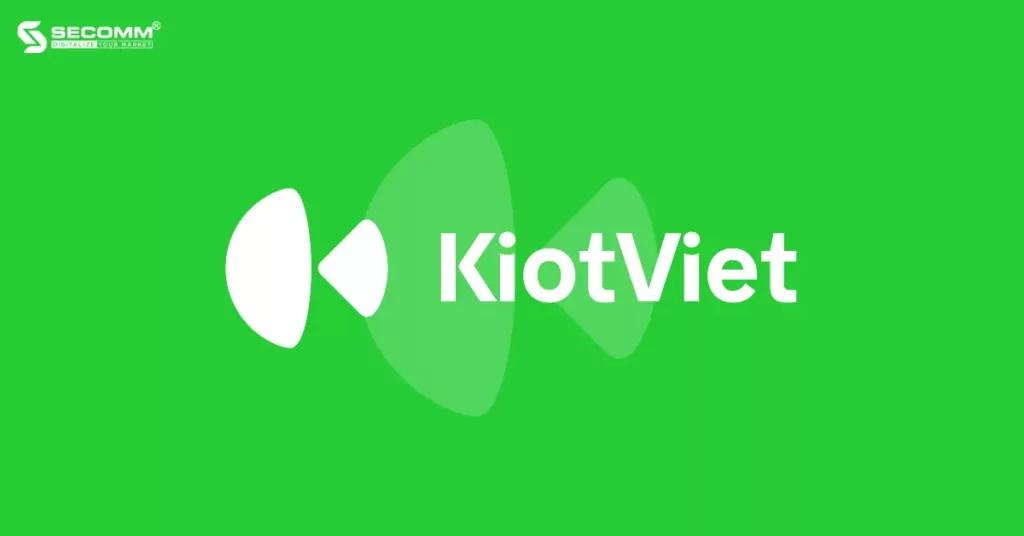
Ease of Use: KiotViet has a user-friendly interface with tailored support for Vietnamese users, eliminating the need for extensive technical expertise during setup and operation.
Seamless Integration: KiotViet offers flexible integration with various peripherals like printers, barcode scanners, payment devices, and other applications such as inventory management, HR management, and financial systems. This results in a comprehensive POS system for effective business management.
Efficient Inventory Management: KiotViet facilitates efficient inventory management, simplifying the process of updating product information and merchandise categories. Therefore, businesses can maintain control over inventory levels, monitor stock movements, and ensure on-time product availability.
License fee: KiotViet necessitates monthly or yearly license fee, which may pose challenges for small or recently formed businesses operating with limited funds.
Limited customization: While KiotViet provides some customization options, the capacity for complex customization to cater to individual business requirements may be limited.
Limitations in Niches Industries: KiotViet primarily targets retail and restaurant businesses, which implies that certain features or management procedures may not be well-suited or could be restricted for niche industries such as electronics, pets, agriculture, and others.
VNPAY-POS, an ‘All-in-one’ solution developed by VNPAY, consolidates numerous features into a single device to comprehensively fulfill a business’s sales and payment management requirements.
VNPAY currently extends two primary options to businesses and organization using VNPAY-POS:

Diverse Payment Methods: VNPAY-POS allows businesses and individuals to accept payments from customers using a range of electronic payment methods, including e-wallets, bank cards, QR codes, and bank transfers.
Appealing Incentives and Comprehensive Support: In addition to its core features, the solution offers advanced functionalities like support for 0% installment plans, cross-selling services, quick and professional 24/7 registration assistance.
Optimized Sales and Business Management: A VNPAY SmartPOS device goes beyond payment processing, performing various tasks such as digital menu display, item selection, order placement, invoice printing, sales management, data extraction, and more. This streamlines operational costs for businesses.
Ongoing Costs: VNPAY POS may entail increasing monthly ongoing costs or transaction charges for payment processing, potentially straining businesses with limited financial resources.
Feature Limitations: In comparison to certain other POS systems, VNPAY-POS has limitations in its feature set, particularly in tailoring solutions to meet the specific needs of individual businesses.
Hardware Compatibility: VNPAY-POS mandates specific hardware prerequisites for operation, such as tablets or mobile devices supported by VNPAY. This could necessitate an initial investment for adopting VNPAY-POS.
POS365 is a cloud-based POS system developed by 365 Technology Corporation. POS365 provides a comprehensive solution for retail businesses, restaurants, cafes, and related industries.
Currently, POS365 offers three packages for businesses:

Vietnamese business-friendly: POS365 has a modern interface that’s easy to navigate, with features thoughtfully tailored to Vietnamese business practices.
Diverse Features: POS365 offers a comprehensive set of sales and business management tools, encompassing inventory control, order processing, warehouse management, customer relations, staff oversight, and business reporting.
Multi-Branch Management: POS365 facilitates the management of multiple branches and sales points through a unified system, simplifying business expansion and operation oversight.
Limited customization: POS365 comes with certain limitations regarding customization and specific business requirements adjustments. This can pose challenges for businesses with unique needs or customization preferences.
Internet required: POS365 relies on a stable internet connection to function. If there’s an internet disruption, payment processing and business management may experience interruptions.
Limited security: Because POS365 is an online system, there’s a higher risk of cyberattacks or data breaches. Businesses need to implement appropriate security measures to safeguard customer information and business data.
Related content: Top 5 best POS software for large-scale enterprises in 2023
Above is a brief overview of 5 POS software solutions widely used by SMEs to enhance business efficiency. Businesses need to consider various factors to select the most suitable POS system.
 4
4
 12,730
12,730
 0
0
 2
2Subscribe to get the latest eBook!
Hotline